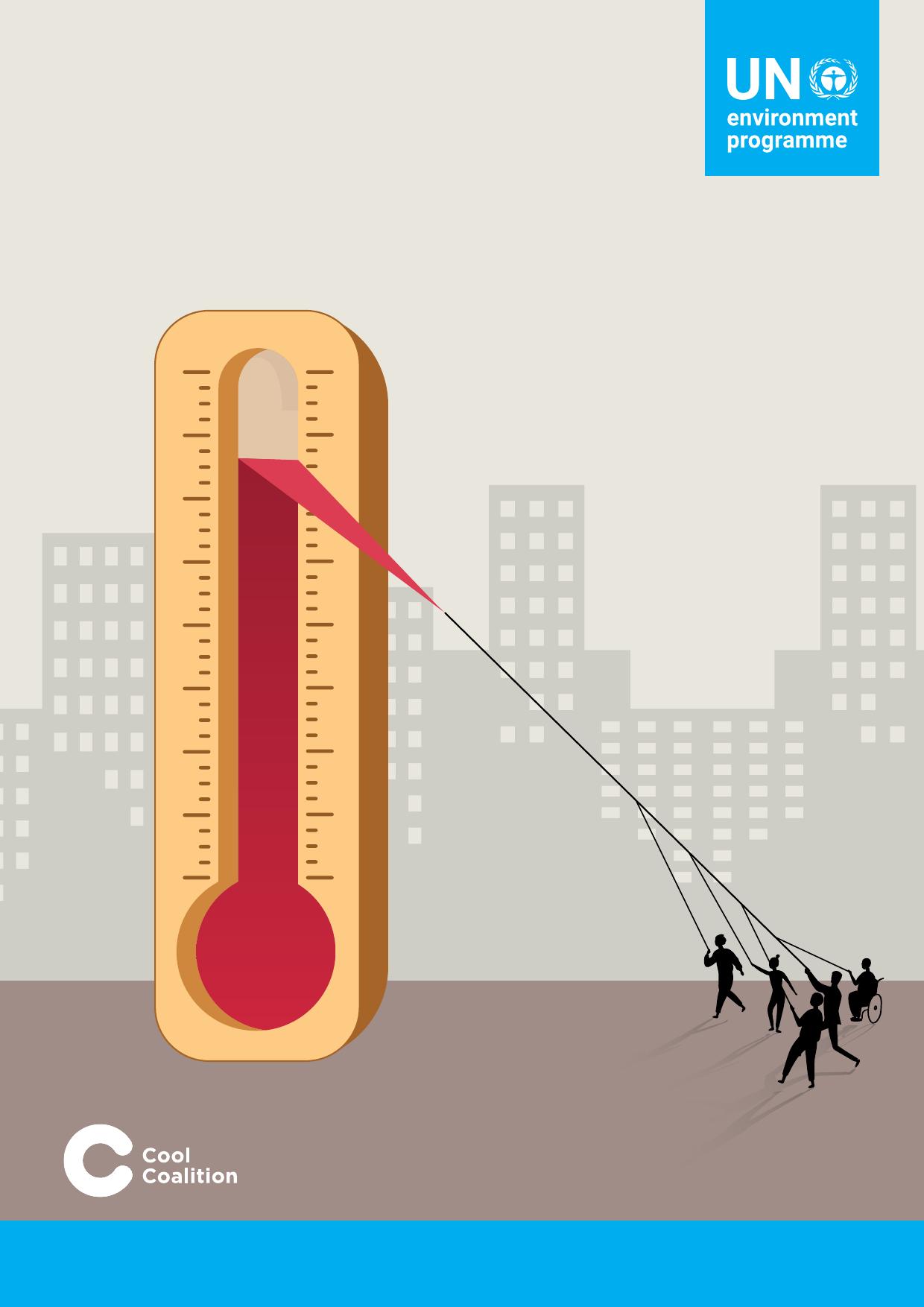KeepingitchillHowtomeetcoolingdemand,whilecuttingemissionsGlobalCoolingWatch2023©2023UnitedNationsEnvironmentProgrammeISBN:978-92-807-4106-3DOI:https://doi.org/10.59117/20.500.11822/44243Thispublicationmaybereproducedinwholeorinpartandinanyformforeducationalornon-profitserviceswithoutspecialpermissionfromthecopyrightholder,providedacknowledgementofthesourceismade.TheUnitedNationsEnvironmentProgrammewouldappreciatereceivingacopyofanypublicationthatusesthispublicationasasource.NouseofthispublicationmaybemadeforresaleoranyothercommercialpurposewhatsoeverwithoutpriorpermissioninwritingfromtheUnitedNationsEnvironmentProgramme.Applicationsforsuchpermission,withastatementofthepurposeandextentofthereproduction,shouldbeaddressedtotheDirector,CommunicationDivision,UnitedNationsEnvironmentProgramme,P.O.Box30552,Nairobi00100,Kenya.DisclaimersThedesignationsemployedandthepresentationofthematerialinthispublicationdonotimplytheexpressionofanyopinionwhatsoeveronthepartoftheSecretariatoftheUnitedNationsconcerningthelegalstatusofanycountry,territoryorcityorareaoritsauthorities,orconcerningthedelimitationofitsfrontiersorboundaries.MentionofacommercialcompanyorproductinthisdocumentdoesnotimplyendorsementbytheUnitedNationsEnvironmentProgrammeortheauthors.Theuseofinformationfromthisdocumentforpublicityoradvertisingisnotpermitted.Trademarknamesandsymbolsareusedinaneditorialfashionwithnointentiononinfringementoftrademarkorcopyrightlaws.TheviewsexpressedinthispublicationarethoseoftheauthorsanddonotnecessarilyreflecttheviewsoftheUnitedNationsEnvironmentProgramme.Weregretanyerrorsoromissionsthatmayhavebeenunwittinglymade.©Maps,photosandillustrationsasspecifiedSuggestedcitation:UnitedNationsEnvironmentProgramme(2023).GlobalCoolingWatch2023:KeepingitChill:Howtomeetcoolingdemandswhilecuttingemissions.Nairobi.www.unep.orgFinancialsupportfromtheDanishInternationalDevelopmentAgency(DANIDA)oftheMinistryofForeignAffairsfromDenmark,CONCITO,andtheCleanCoolingCollaborative,aphilanthropicinitiativeoftheClimateworksFoundation,toconducttheresearchonwhichthispublicationisbasedisgratefullyacknowledged.Supportedby:MINISTRYOFFOREIGNAFFAIRSMINISTRYOFFOREIGNAFFAIRSOFDENMARKOFDENMARKAninitiativeofClimateWorksFoundationMINISTRYOFFOREIGNAFFAIRSMINISTRYOFOFDENMARKFOREIGNAFFAIRSOFDENMARKMINISTRYOFFOREIGNAFFAIRSMINISTRYOFUNEPOFDKEeNeMpAinRgKitchill:HowtomeetcoolingdemFOOFaRDEnEINGdMNsAARFFwKAIhRSilecuttingemissionsAcknowledgementsTheUnitedNationsEnvironmentProgrammeLeadAuthors(UNEP)andtheCoolCoalitionwouldliketothankthemembersofCoolCoalitionSteeringRadhikaKhosla(AssociateProfessorandCommitteeandTechnicalAdvisoryCommittee,ResearchDirectoroftheOxfordIndiaCentretheleadandcontributingauthors,thereviewers,forSustainableDevelopment,andPrincipalandtheSecretariatfortheircontributiontotheInvestigator,FutureofCoolingProgramme,preparationofthisreport.UniversityofOxford,UnitedKingdom);OmarAbdelaziz(AssistantProfessor,TheTechnicalAdvisoryCommitteeAmericanUniversityinCairoandCo-chair,Refrigeration,Air-conditioningandHeatSimonBenmarraze(InternationalRenewablepumpTechnicalOptionsCommitteetotheEnergyAgency[IRENA]),PatrickBlake(UNEP),MontrealProtocol,Egypt);LeoJosephBlyth(WorldBankGroup),RayGluckman(GluckmanConsultingandIainCampbell(RMI),JohnChristensen(UNEPMember,TechnicalandEconomicAssessmentCopenhagenClimateCentre[UNEP-CCC]),PaneltotheMontrealProtocol,UnitedKingdom);JamesCurlin(Head,UNEPOzonAction),LilyRiahi(GlobalCoordinator,UNEPCoolBrianDean(SustainableEnergyforAllInitiativeCoalition,Thailand)[SEforAll]),GabrielleDreyfus(InstituteforGovernance&SustainableDevelopment–[IGSD]),CoordinatingAuthorsAymanEltalouny(UNEPOzonAction),BenHartley(SEforAll),JoannesHeister(WorldBank),ShikhaBhasin(UNEPCoolCoalition,France);BrianHoluj(UNEP),InesJacob(IRENA),IanMcGaviskP.E.(UNEPCoolCoalition,UnitedNoahHorowitz(CleanCoolingCollaborative),StatesofAmerica)AnkitKalanki(RMI),KevinLane(InternationalEnergyAgency[IEA]),BrianMotherway(IEA),LeadTopicalAuthorsTobyPeters(UniversityofBirmingham),GiorgiaPasqualetto(SEforAll),PipatModelling:TimThurnham,(EiderConsulting,Poopeerasupong(UNEPOzonAction),UnitedKingdom)MarkRadka(UNEP),LilyRiahi(UNEPCoolPolicy:ShikhaBhasin(UNEPCoolCoalition,France);Coalition),RajanRawal(CEPTUniversity),FrancoisCohen(UniversityofBarcelona,Spain)LiazzatRabbiosi(OzoneSecretariat,Nairobi,Residentialspacecooling:AnkitKalanki(RMI,Kenya),NiharShah,(LawrenceBerkeleyNationalUnitedStatesofAmerica)Laboratory[LBNL],UnitedStatesofAmerica),Emergingtechnologyandnon-residentialspaceAxumTeferra(CleanCoolingCollaborative,cooling:NiharShah(LBNL,UnitedStatesofUnitedStatesofAmerica)America)Coldchain:YosrAllouche(IIR,France);ProjectLeadMoniqueBaha(IIR,France);TobyPeters(UniversityofBirmingham,UnitedKingdom);LeylaSayinLilyRiahi(CoordinatorUNEP,CoolCoalition)(UniversityofBirmingham,UnitedKingdom)Refrigerants:GabrielleDreyfus(IGSD,UnitedStatesofAmerica)Markettrendanalysis:H.IanMcGaviskP.E.(UNEPCoolCoalition,UnitedStatesofAmerica)Cross-cutting:JohannesHeister(WorldBankGroup,UnitedStatesofAmerica)Finance:IssaFaye(InternationalFinanceCorporation[IFC]UnitedStatesofAmerica);AlanMiller(IFC,UnitedStatesofAmerica);CamiloMondragon-Velez(IFC,UnitedStatesofAmerica);IanCrosby(IFC,Austria).iiiUNEPKeepingitchill:HowtomeetcoolingdemandswhilecuttingemissionsAcknowledgementsTopicalAuthorsandContributorsPompidoPujol(UniversityofBarcelona,Spain),RajanRawal(CEPTUniversity,India),MohamedAhmedAbdelrasoul(RegionalCenterforSadeq(RCREEE,Egypt),LalrinpariSailo(IFC,UnitedRenewableEnergyandEnergyEfficiency[RCREEE],StatesofAmerica),AlexanderSharabaroff(IFC),Eygpt),CarlosAlbertoVielmaLeal(UniversityofNancySherman(IGSD,UnitedStatesofAmercia),Barcelona,Spain),MohamedAli(RCREEE,Egypt),PramodSingh(AEEE,India),ManjeetSingh(UNEPYulduzAlimova(KozminskiUniversity),AhmadCoolCoalition,India),KristenTaddonio(IGSD,Arabkoohsar(TechnicalUniversityofDenmarkUnitedStatesofAmerica),AaminaTeladia(World[DTU],Denmark),SimonBenmarraze(IRENA,Bank,UnitedStatesofAmerica),BrightTettehGermany),PatrickBlake(UNEPU4E,France),Iain(UniversityofMilan,Italy),UpasanaVarma(IFC,Campbell(RMI,UnitedStatesofAmerica),HanUnitedStatesofAmerica),KhuzamaWardehChen(EnergyFoundationChina[EFC],China),(RCREEE,UnitedKingdom),OumaimaZghoudaDidierCoulomb(IIR,France),ShengCui(EFC,(UniversityofBarcelona,Spain),JiayiZhangChina),BrianDean(SEforAll,Austria),Himanshu(CLASP,UnitedStatesofAmercia),TanZhengDixit(CouncilonEnergy,EnvironmentandWater(EFC,China)[CEEW],India),Jean-LucDupont(IIR,France),MarcoDuran(UNEPU4E,France),MohamedEbaid(RCREEE,KingdomofSaudiArabia),AkramElMohamdy(RCREEE,Egypt),PatrickFahr(UniversityofOxford,UnitedKingdome),DanielFranciscoMontoyaConcha(UniversityofBarcelona,Spain),AdityaGarg(CEEW,India),AkashGoenka(AEEE,India),OwenGow(AtlanticCouncil,UnitedStatesofAmerica),JanGrözinger(GuidehouseGermany),WeiHan(EFC,China),BenHartley(SEforAll,Austria),BenjaminHickman(UNEPCoolCoalition,France),BrianHoluj(UNEPU4E,France),AndreaIsabelBardalesCortés(UniversityofBarcelona,Space),InesJacob(IRENA,Germany),MehulJain(WorldBankGroup,India),SatishKumar(AEEE,India),SonalKumar(CEEW,India),TillyLenartowicz(SEforAll,Austria),JinruiLiu(IFC,UnitedStatesofAmerica),MattMalinowski(CLASP),AntonellaMazzone(UniversityofBristol,UnitedKingdom),AlyviaMcTague(UniversityofBarcelona,Spain),MarkusOfferman(Guidehouse,Germany),BeatrizOrtegaSánchez(UniversityofBarcelona,Spain),GiovaniPalafox-Alcantar(UniversityofOxford,UnitedKingdom),GiorgiaPasqualetto(SEforAll,Vienna),JordiPlanellesCortes(UniversityofBarcelona,Spain),GerardivUNEPKeepingitchill:HowtomeetcoolingdemandswhilecuttingemissionsAcknowledgementsReviewersSecretariat,production,coordinationYosrAllouche(IIR),MoniqueBaha(IIR),SimonLilyRiahi(TeamLead,UNEPCoolCoalition),Benmarraze(IRENA),PatrickBlake(UNEPU4E)ShikhaBhasin(UNEPCoolCoalition),Eng.CarlosBohorquez(MedellinCityHall),TinaSophieLoran(UNEPCoolCoalition),Brimpli(MultilateralFundfortheImplementationDeepaSolanki(UNEPCoolCoalition),oftheMontrealProtocol[MLF]),LindsayBrysonClementCharnaillat(UNEPCoolCoalition)(ClintonHealthAccessInitiative[CHAI]),IainCampbell(RMI),JalelCHABCHOUB(AfricanEditorsDevelopmentBankGroup),ClementCharnaillat(UNEPCoolCoalition)FrancoisCohen(UniversityAmandaLawrence-Brown(UNEPChiefScienceofBarcelona),JordiPlanellesCortes(UniversityEditor)andLisaMastny(Editor)ofBarcelona),DidierCoulomb(IIR),BrianDean(SE4All),KatjaDinges(Guidehouse),GabriellaMediaandlaunchsupportDreyfus(IGSD),GabrielleDreyfus(IGSD)Jean-LucDupont(IIR),IssaFaye(IFC),AnirbanGhoshSophieLoran(UNEP),KeishamazaRukikaire(Mahindra),JuergenGoeller(Carrier),Akash(UNEP),SajniShah(UNEP)Goenka(AEEE),EtienneGonin(UnitedNationsDevelopmentProgramme[UNDP]),JanGrözingerDesignandlayout(Guidehouse),SouhirHammami(UNEPCoolCoalition),BenHartley(SE4All),JohannesHeisterWeeks.deWerbeagenturGmbH(figuresand(WorldBank),BrianHoluj(UNEPU4E),Paullayout)andBeverleyMcDonald,UNEP(coverHuggins(CarbonTrust),InesJacob(IRENA),design)MehulJain(WorldBank),AnantJani,AnkitKalanki(RMI),GennaiKamata(UNEPCoolCoalition),Thanksalsoto:SamerKhoudeir(Empower),ManojKumar(IndianInstituteofTechnologyRoorkee),SatishKumarAndreaHinwood(UNEP),SheilaAggarwal-Khan(AEEE),HongpengLiu(UNESCAP),JinruiLiu(UNEP),StevenStone(UNEP),MarkRadka(IFC),RobMcDonald(TheNatureConservancy),(UNEP),MirayAtallah(UNEP),TinaBirmpilli(UNEPIanMcgavisk(RMI),JesusMenendez(ZeroEnergyMultilateralFundSecretariat),JohnChristensonPassivhaus),AlanMiller(IFC),AndréDanielMueller(UNEPCCC),RuthCoutto(UNEP),JimCurlin(SwissAgencyforDevelopmentandCooperation(UNEPOzonAction),PatriciaKameri-Mbote[SDC]),BalajiNatarajan(MLF),MarkusOffermann(UNEP),BalajiNatarajan(UNEP),MegSeki(Ozone(Guidehouse),GeorgiaPasqualetto(SE4All),Secretariat),DechenTsering(UNEP)LiazzatRabbiosi(OzoneSecretariat),KimberlyRoseberry(UNESCAP),LalrinpariSailo(IFC),MegThisreportwouldnothavebeenpossiblewithoutSeki(OzoneSecretariat),AlexanderSharabaroffthefinancialsupportwereceivedfromour(IFC),NancySherman(IGSD),CamilleSifferlenpartnersDanishInternationalDevelopmentAgency(PassiveHouseInstitute),PramodSingh(AEEE),(DANIDA),MinistryofForeignAffairsDenmark,NesenSurmeli-Anac(Guidehouse),AxumTeferraCONCITO,CleanCoolingCollaborative.(ClimateworksFoundation),AaminaTeladia(WorldBank),UpasanaVarma(IFC),AndreaVoigt(Danfoss),FlorianWalbert(COS-TA),EslamMohamedMahdyYoussef(Guidehouse)vUNEPKeepingitchill:HowtomeetcoolingdemandswhilecuttingemissionsGlossary°CDegreesCelsiusMEPSMinimumenergyperformanceACESAfricaCentreofExcellenceforstandardSustainableCoolingandCold-ChainAEERAnnualenergyefficiencyratioMLFMultilateralFundBAUBusinessasUsualCaaSCooling-as-a-serviceMoNREMinistryofNaturalResourcesandCDDCoolingdegreedayEnvironmentofVietNamCFCChlorofluorocarbonCO2eCarbondioxideequivalentMWMegawattCOPConferenceofthePartiesESCOEnergyservicecompanyNCAPNationalCoolingActionPlanESGEnvironmental,socialandgovernanceNDCNationallyDeterminedContributionEUEuropeanUnionF-gasFluorinatedgasPAYGPay-as-you-goGCFGreenClimateFundGDPGrossdomesticproductPCMPhase-changematerialGHGGreenhousegasGWPGlobalwarmingpotentialRACHPRefrigeration,airconditioningandHCHydrocarbonheatpumpHCFCHydrochlorofluorocarbonHFCHydrofluorocarbonR&DResearchanddevelopmentHFOHydrofluoro-olefinHVACHeating,ventilationandairTWTerawattconditioningIEAInternationalEnergyAgencyTWhTerawatt-hourIFCInternationalFinanceCorporationIPCCIntergovernmentalPanelonClimateU4EUnitedforEfficiencyChangeKIPKigaliImplementationPlanUNUnitedNationskWKilowattkWhKilowatt-hourUNEPUnitedNationsEnvironmentProgrammeUNFCCCUnitedNationsFrameworkConventiononClimateChangeVRFVariablerefrigerantflowviUNEPKeepingitchill:HowtomeetcoolingdemandswhilecuttingemissionsTableofContentsListoffigures,tablesandboxes........................................................................................................viiListofabbreviations...........................................................................................................................ivExecutivesummary..........................................................................................................................xiv1Coolingasaglobalchallenge.........................................................................................................21.1Theurgentneedforsustainablecooling.............................................................................................41.2Globalcoolingstocktakereport...........................................................................................................52Thepathwaytonear-zeroemissionsfromcooling.........................................................................82.1Coolingequipmentstock......................................................................................................................92.2Coolingequipmentenergyefficiency...............................................................................................132.3ReducingdirectGHGemissionsfromrefrigerants..........................................................................162.4Coolingintransportapplications......................................................................................................172.5Griddecarbonization.........................................................................................................................182.6ReducingGHGemissionsfromcooling...........................................................................................193Globalcoolingpolicyandlegislativelandscape............................................................................273.1Landscapeofnationalcoolingpolicies............................................................................................273.2Integratingandimplementinganoptimalpackageofregulatoryinstruments.............................303.3Regulatoryinstrumentstoenhanceaccesstocooling...................................................................393.4Marketreadinessforsustainablecoolingsolutions.......................................................................433.5Electricitygenerationandcapacityplanning...................................................................................453.6Employmentandparticipationofwomen........................................................................................464Spacecooling..............................................................................................................................484.1Anintegrated,whole-systemsapproach..........................................................................................484.2Technologicalinnovationforspacecooling....................................................................................504.3Overcomingbarrierstospacecooling..............................................................................................535Refrigerationandcoldchains.......................................................................................................565.1Sustainablecoldchains.....................................................................................................................565.2System-basedstrategiestoadvancesustainablecoldchains.......................................................595.3Technologyinnovationinrefrigerationandcoldchains.................................................................626Pathtowardslow-emissionrefrigerants.......................................................................................656.1Refrigerantphasedown....................................................................................................................656.2Life-cyclemanagementofrefrigerants............................................................................................656.3Transitiontowardsalternativerefrigerants......................................................................................666.4Synergiesbetweenenergyefficiencyandtherefrigerantphasedown..........................................68viiUNEPKeepingitchill:HowtomeetcoolingdemandswhilecuttingemissionsTableofContents7Financingforsustainablecooling..................................................................................................737.1Streamliningandovercomingchallengestoscalefinancing..........................................................737.2Mappingthefinancinglandscapeforcooling...................................................................................747.3Emergingbusinessmodelsandinstrumentstoscalefinancing.....................................................777.4Challengestoscalingupinvestmentinsustainablecooling...........................................................817.5Recommendationsforscalingsustainablecoolingfinancing.........................................................828RecommendedstepstosupporttheBestPoliciespathway...........................................................868.1Recommendedpolicyactions............................................................................................................868.2Recommendedenablingactivities.....................................................................................................89Bibliography......................................................................................................................................91AnnexesAnnex1TechnologiesprimerAnnex2ModellingfuturescenariosforcoolingAnnex3GlobalinstalledcapacityofcoolingequipmentAnnex4VariablesusedtoestimateannualenergyconsumptionofcoolingequipmentAnnex5Thetransitiontolow-GWPrefrigerantsAnnex6GHGemissionsfromglobalcoolingequipmentAnnex7GlobalCoolingEmissionsModelAnnex8GlobalCoolingPolicyStocktakesurveydataAnnex9PolicyprimerAnnex10SummaryofnationalpoliciesandregulationsrelatedtotheHFCphasedownAnnex11Life-cyclemanagementinitiativesofrefrigerantgasesinselectedcountriesAnnex12�ExamplesofthecommercialuseofnaturalrefrigerantsinthecoldchainandresultingenergysavingsviiiUNEPKeepingitchill:HowtomeetcoolingdemandswhilecuttingemissionsListofFiguresFigureES-1�Globalpathwayandkeystepstoachievenear-zeroGHGemissionsfromcooling,2022-2050.......................xviiFigureES-2Distributionofcriticalnationalpoliciestolowercoolingemissionsacrosscountries............................xviiiFigure2-1Globalcoolingcapacityin2022andunderthreescenariosforgrowthto2050........................................10Figure2-2�(a)Installedcapacityand(b)energyconsumptionofcoolingequipmentundertheBAUGrowthscenario,2000-2050............................................................................................................11Figure2-3Projectedglobalelectricityuseforstationarycoolingunderfourscenarios,2010-2050.........................14Figure2-4GlobalHFCemissionsfromcoolingunderfourmitigationscenarios,2010-2050....................................17Figure2-5ElectricitydecarbonizationprofilesforArticle2andArticle5regions,2010-2100...................................18Figure2-6GHGemissionsfromcoolingbyregion.........................................................................................................19Figure2-7Globalpathway:progresstowardnear-zeroGHGemissionsfromcoolingasof2030.............................21Figure2-8Globalpathwayandkeystepstoachievenear-zeroGHGemissionsfromcoolingin2050.........................22Figure2-9Pathwaytowardsnear-zeroGHGemissionsfromcoolingindevelopingcountriesin2050........................23Figure2-10CumulativeglobalGHGemissionsfromcooling,2022-2050......................................................................24Figure2-11ContributiontoBestPoliciesemissionreductionin2050,bycountrygroup.............................................25Figure3-1Distributionofrelevantnationalpoliciestolowercoolingemissionsacrosscountries............................29Figure3-2�Shareofcountries,byregion,thathaveimplementedMEPSinthespacecoolingandrefrigerationsectors(andupdatethemregularly),asofMay2023..................................................................................31Figure3-3�Shareofcountries,byregion,thathaveimplemented(a)regulationsforGWPrefrigerantrecoveryduringservicingand/or(b)regulationsforGWPrefrigerantdisposal,asofMay2023...........................................32Figure3-4�CountriesinLatinAmericaandEast,SouthandSoutheastAsiawith(a)coolingmentionedintheirNationallyDeterminedContribution,climateornet-zerostrategy,and/or(b)aNationalCoolingActionPlan,asofMay2023.........................................................................35Figure3-5�Shareofcountries,byregion,with(a)national-levelcoolingpoliciesand(b)dataonaccesstocooling,asofMay2023................................................................................................................39Figure3-6�Shareofcountries,byregion,forwhich(a)foodwasteisreportedeachyearand(b)thecoldchainhasbeenmappedtoidentifyrisksoffoodwasteandshortage,asofMay2023...............................40Figure4-1Awhole-systemsapproachtowardssustainablecooling............................................................................48Figure4-2Passivecoolingprinciplesinbuildings..........................................................................................................50Figure4-3Passivecoolingopportunitiesincommercialbuildings...............................................................................51Figure4-4Policiestoovercomebarriersinthecoolingsectorandscalesustainablespacecooling...........................53Figure4-5Recommendedactionstepstoaddressthebarrierstosustainablespacecooling..................................54Figure5-1Thefoodcoldchainasanexampleofatypicalcoldchain.........................................................................57Figure5-2Typicalcoldchainflowfromfarmtofork,andfromvaccinemanufacturertoarm...................................60Figure6-1Life-cyclestagesofrefrigerantgases...........................................................................................................66ixUNEPKeepingitchill:HowtomeetcoolingdemandswhilecuttingemissionsListofTablesTable2-1Energyefficiencyscenariosforcoolingequipmentmodelled..............................................13Table2-2HFCmitigationscenarios........................................................................................................16Table2-3Basisofgriddecarbonizationscenariosmodelled...............................................................18Table2-4Stepsleadingtoapathwayofnear-zeroemissionsfromcooling.......................................20Table3-1PoliciesaffectingtheenergyefficiencyofbuildingsandappliancesinMorocco..............34Table8-1Recommendedpolicyactions.................................................................................................86Photo:AltrendoImages,shutterstockxUNEPKeepingitchill:HowtomeetcoolingdemandswhilecuttingemissionsListofBoxesBox1-1Keydriversofcoolingdemandandrelatedenergyuse...........................................................3Box3-1Casestudy:IntegratingsustainablecoolingpoliciesinMorocco........................................34Box3-2DevelopingHeatActionPlans:TheHeatActionPlatformonlineresource.........................37Box3-3Casestudy:AfricaCentreofExcellenceforSustainableCoolingandCold-Chain..............38Box3-4Casestudy:VietNamIntegratedPolicyFramework.............................................................42Box3-5Casestudy:CoolingbyClimateSaathisinIndia....................................................................45Box6-1�Casestudy:OperationalizingsynergiesbetweentheHFCphasedownandenergyefficiencyindifferentcountries..................................................................................70Box6-2Linkingtherefrigeranttransitiontotheenergyefficiencyobligationsofutilities...............71Box7-1Casestudy:BulkprocurementinIndia...................................................................................78Box7-2Casestudy:GreenmortgagesfortheconstructionsectorinColombia..............................81SaoPaulo,BrazilPhoto:NelsonAntoine/shutterstockxiUNEPKeepingitchill:HowtomeetcoolingdemandswhilecuttingemissionsForewordIngerAndersenCoolingprotectspeoplefromrisingtemperatures,maintainsfoodqualityandExecutiveDirectorsafety,keepsvaccinesstableandenableseconomicproductivity.ItiscentraltoUnitedNationsEnvironmentachievingthesustainabledevelopmentgoals.Theflipsideisthatcoolinggrowth,Programmeunderbusinessasusual,wouldleadtoadoublingofthesector’sgreenhousegasemissionsby2050–whichcannotbeallowedtohappeniftheworldistolimitclimatechangetomanageablelevels.Thereare,however,solutionstothisdilemma,whichwouldallowcoolingtoreachanadditional3.5billionpeopleanddramaticallyreducepredictedemissions.TheGlobalCoolingWatchreport,KeepingitChill:Howtomeetcoolingdemandswhilecuttingemissions,laysoutmeasuresthatwould,by2050,reducegreenhousegasemissionsfromcoolingbyatleast60percentbelowbusiness-as-usual,reducepeakloaddemandbybetween1.5and2terawatts,andsaveUS$22trillionforend-usersandthepowersector.Thereport,fromtheUNEP-ledCoolCoalition,looksatactionsinthreeareas.Deployingpassivecoolingmeasures,suchasinsulation,naturalshadingandventilation,woulddramaticallyreducecoolingloads.Higherefficiencystandards,includingthroughupdatedMinimumEnergyPerformanceStandardsandbetterlabelling,wouldtripletheglobalaverageefficiencyofcoolingequipmentby2050.Afasterphasedownofclimate-warminghydrofluorocarbon(HFC)refrigerantsthroughtheKigaliAmendmenttotheMontrealProtocolwouldalsomakeahugedifference.Ifrapidgriddecarbonizationwereaddedtotheseactions,predicted2050emissionscouldbereducedby96percent.Todeliverthesebenefits,governmentsmustintroducealignedpoliciesthatsupportandintegratepassivecooling,energyefficiencyandfasterrefrigerantphasedown–includingthroughframeworkslikeNationalCoolingActionPlans.Somecountriesalreadyhavepoliciesinplace,buttheyneedtobebetterimplemented.Othernationsmustcatchup.Financeforcoolingalsoneedstorise–althoughUS$22trillioninsavingsandthesocietalbenefitsofdeepemissionscutswouldmakethesustainablecoolingtransitionaffordable.Iaskallnations,citiesandprivatesectortocommittosustainablecoolingwithconcreteactions.TheGlobalCoolingPledge,ajointinitiativebetweentheCoolCoalitionandtheUnitedArabEmiratesashostofthe2023UnitedNationsClimateChangeConference(COP28),providesarealopportunitytoact.Ifwefollowtherecommendationsinthisreport,wewilldeliveracooler,andbetter,worldforall.xiiUNEPKeepingitchill:HowtomeetcoolingdemandswhilecuttingemissionsAcomprehensiveandHongKong,ChinasystemicshifttosustainablePhoto:mm7,shutterstockcoolingisrequiredtominimisegrowthintheemissionsfromcoolingwhileincreasingoverallaccesstocoolingforvulnerableandunderservedcommunities.ExecutiveSummaryAstheworldwarms,andasincomesandpopulationsgrow,demandforcoolingisrapidlygrowinganditisincreasinglybeingrecognizedasacriticalservice.Peopleneedcoolingtoprotectthemselvesfromrisingtemperaturesandtokeepfoodfresh,vaccinesviableandeconomiesproductive.Basedoncurrentpolicies,betweennowandIntegratedactionisneededinthreekeyareas:2050theinstalledcapacityofcoolingequipmentgloballywilltriple,resultinginamorethandoubling1)�Passivestrategiestoaddressextremeheatandofelectricityconsumption.Thiswillleademissionsreducecoolingdemandinbuildingsandinthefromcoolingtosurgeto6.1billiontonsofcarboncoldchain.dioxideequivalent(CO2e)in2050,equivalenttomorethan10percentofglobalprojected2)�Higherenergyefficiencystandardsandnormsemissionsthatyear1.Thisrapidincreaseincoolingforcoolingequipment.willstrainelectricitygridsinmanycountries,presentingamajorhurdletotheongoingtransition3)�Aphasedownofclimate-warmingfromfossilfuelstorenewableenergysources.hydrofluorocarbon(HFC)refrigerantsatafasterratethanisrequiredundertheKigaliCoolingisadoubleburdenonclimatechange.AmendmenttotheMontrealProtocol,whileRisingdemandforpower-hungryequipment,suchimprovingtheenergyefficiencyofcoolingasairconditionersandrefrigeration,willdriveequipment.greaterindirectemissionsfromtheassociatedelectricityconsumption.Atthesametime,theseemissionsarecompoundedbydirectemissionsfromthereleaseofrefrigerantgasesincoolingequipment,themajorityofwhichhaveamuchhigherglobalwarmingpotentialthanCO2.Acomprehensiveandsystemicshifttosustainablecoolingisrequiredtominimisegrowthintheemissionsfromcoolingwhileincreasingoverallaccesstocoolingforvulnerableandunder-servedcommunities.Meetinggrowingcoolingdemandsustainablypresentsoneofthebiggestopportunitiestoprotectpeople,prosperityandtheplanet.1CalculatedbasedontheCurrentPoliciesScenariointheUnitedNationsJapanEnvironmentProgramme’s(UNEP)2023EmissionsGapReport;seeUNEPPhoto:RyojiIwata,unsplash2023a.xivUNEPKeepingitchill:HowtomeetcoolingdemandswhilecuttingemissionsNear-zeroemissionsfromcooling–withimprovedFullyimplementingthemeasuresoutlinedaccesstocooling–canonlybeaccomplishedinthisreportcan:throughtheimplementationofsynergisticpolicies,regulations,trainingandfinancialinstrumentsthatReducethe2050greenhousegas(GHG)worktogethertocreateastrongandsustainableemissionsfromcoolingbyatleast60coolingecosystem.Itrequiresmainstreamingpercent(around3.8billiontonsofCO2ecoolingwithinanational-levelregulatoryorlegalemissions),andthiscouldincreasetoaframeworkaswellasdevelopingNationalCooling96percentreductiondependingonratesActionPlansandstreamliningfinance.ofgriddecarbonization.Thecumulativesavings,measuredatasocialcostofImportantly,theG20countriesrepresent73percarbonofUS$185pertonofCO2e,arecentofthepotentialforreducingcoolingUS$16.5trillion(2020US$).emissionsto2050,ofwhich11percentisfromtheG7countries.ThisillustratesthatleadershipCreateelectricitysavingsforendusersfromtheG20countriesplayakeyrole.ofUS$1trillionin2050(2020US$)andreducethepeakpowerrequirementbybetween1.5and2terawatts(TW),avoidingpowergenerationinvestmentsintheorderofUS$4trilliontoUS$5trillion.Budapest,HungaryPhoto:AndocsshutterstockxvUNEPKeepingitchill:HowtomeetcoolingdemandswhilecuttingemissionsCoolingisanecessityinaAboutthereportwarmingworldThisreportshinesaspotlightoncoolingpolicyInitsSixthAssessmentReport,thetrends,technologiesandinvestmentopportunitiesIntergovernmentalPanelonClimateChangetohelpclosethegapsinaccess,affordabilityandstatesthat:“Heatisagrowinghealthrisk,dueinformation.Itfocusesnotonlyonspacecoolingtoburgeoningurbanization,anincreaseinbutalsooncoldchainsforfoodandhealth.hightemperatureextremes,anddemographicchangesincountrieswithageingpopulations”PreparedasacollectiveoutputoftheCool(IPCC2023).Giventhesetrends,coolingwillCoalition,ledbytheUnitedNationsEnvironmentneedtoexpandforbothstationaryapplicationsProgramme(UNEP),thereportundertakes,forthe(residentialandnon-residentialspacecooling,firsttime,modellingofthetotalityofemissionscoldchainsandprocesscooling)andtransportfromcooling,bothdirectandindirect.Itmodelsapplications(mobileairconditioningandcoolingemissionsacrossallsectors–includingrefrigeratedtransport).spacecooling,coldchainandrefrigeration,andtransportglobally–whileconsideringcoolingUnderabusiness-as-usual(BAU)projection,theaccessneedsandevaluatingthebenefitsofaglobalinstalledcapacityofcoolingequipmentcomprehensiveapproachandapathwaytonear-isenvisagedtoalmosttripleby2050to58TW2.zeroemissionsfromcooling.MeetingthisrisingdemandwillrequirelargeinvestmentsinelectricitygenerationanddistributionThereportlooksata2022baselineandprovidesinfrastructure,andwillalsoresultinhigherelectricityprojectionsandinterventionscenariostoreducebillsforendusers,particularlyinAfricaandSouthemissions,whileimprovingaccess,upto2050.Asiawherethefastestgrowthispredicted.Themodellingallowsevaluationofthedifferentmeasuresandpathwaysbywhichnear-zeroYet,despitethissignificantgrowthinequipment,emissionsfromcoolingcanbeachieved,alongsidetheworld’spoorestandmostvulnerabledevelopmentprioritiessuchasaccesstocoolingpopulationswillcontinuetolackaccesstoforall.Thereportalsoprovidesastatuscheckcooling.Providingaccesstocoolingindevelopingandanoverviewofnationalpolicyandregulatorycountriesoverallrequiresanadditional10peractionsacrossallcoolingsectorsin192Unitedcentgrowthinthe2050coolingcapacity.NationsMemberStates(nodatawasavailablefortheDemocraticPeople’sRepublicofKorea).Accessisenhancedthroughpassivecooling,bringingnaturebacktocitiesforcomfortable“Heatisagrowinghealthrisk,microclimates,lowerupfrontandrunningduetoburgeoningurbanization,costsforefficientcoolingequipment,moreanincreaseinhightemperaturereliablegridsandenhancedsupportbasedonextremes,anddemographicassessmentofneeds.changesincountrieswithageingpopulations”Tominimizethemultipleandseverenegativeimpactsfromcoolinggrowth,arapidtransitiontosustainablecoolingisneeded.Thisrequirestheadoptionofcoolingtechnologiesandapproachesthatareaccessible,affordableandscalablebutthatminimizenegativeimpactsonpeople,theeconomyandtheenvironment.Fortunately,solutionsexistthatcanprovidecoolingforallwhileprotectingeconomiesandtheplanet.2SuchanincreaseininstalledcapacityofcoolingequipmentwouldVancouver,Canadarequireanestimated2to2.8TWofadditionalelectricalpowerunderPhoto:MargaritaYoung,shutterstockBAUenergyefficiencyassumptions.xviUNEPKeepingitchill:HowtomeetcoolingdemandswhilecuttingemissionsFigureES-1:�Globalpathwayandkeystepstoachievenear-zeroGHGemissionsfromcooling,2022-2050AllSectors,AnnualEmissions,Global,BillionTonnesCO2e10+4.3+0.69.0-1.0-1.98KigaliComplianceImprovedAccessBAUEnergyEfficiency6PassiveCooling6.1-1.3-2.34.1ReductionBAUGrowthHighEfficiency4RapidHFC2PhaseDownBAUGrid0Decarbonisation2022MediumGridDecarbonisationEmissionsRapidGridDecarbonisationDirect(Refrigerant)-0.22.3-0.7Emissions-0.4-1.1Indirect(Energy)Emissions0.220502050with2050with2050withWithoutMeasuresBAUCoolingMeasuresBestCoolingMeasuresNear-ZeroCoolingGrowthBAUCoolingMeasures2022-2050MeasuresBestCoolingGridMeasuresDecarbonisationNote:Bluebarsshowemissionsin2022and2050.Purplebarsindicategrowth.YellowbarsindicateBAUCoolingMeasureemissionreductions.OrangebarsindicateBestCoolingMeasureemissionreductions.Greenbarsindicateemissionreductionduetoelectricitygriddecarbonisation.FigureES-1illustratestheBAUgrowthincoolingMakingitareality:Threepriorityemissionsbetween2022and2050,togetherwithactionareastocutcoolingapathwaytoreducedemissionsin2050.Thisemissionspathwayhasbeendevelopedasaviablewaytoachievenear-zeroemissionsfromcooling,Amajorityofcountries(over80percent)andalsoprovidessignificantcumulativeenergyandeconomicsavingswhileexpandingcoolinghaverecognizedtheimportanceofadvancingaccesstothemajorityofvulnerablehouseholdsin2050.sustainablecoolingthroughatleastoneofthreekeypolicyactionsatthenationallevel(FigureES-2).However,effortsareoftenpilot-scaleorsiloed,andchallengestoimplementationaresignificant.“FullyimplementedNear-ZeroInadditiontocompliancewiththeKigaliAmendmentCoolingMeasurescanreducethetotheMontrealProtocol(whichoverseesthe2050emissionsfromcoolingbyphasedownofHFCrefrigerants),itisimperative96percent—around5.9billiontonsforcountriestotakefurtheractioninthreekeyofCO2eemissions—comparedareastoachievenear-zeroemissionscooling.withbusiness-as-usual.”xviiUNEPKeepingitchill:HowtomeetcoolingdemandswhilecuttingemissionsFigureES-2:�DistributionofcriticalnationalpoliciestolowercoolingemissionsacrosscountriesKeypoliciesKigaliagreementMEPSRatified,acceptedNationalBECorapprovedBoth(MEPSandBEC)NeitherMEPSorBECNodataNote:Numberofpoliciesinplaceamongthefollowingthree:1)minimumenergyperformancestandards(MEPS)establishedatthenationallevelforappliancesinthecoolingsector;2)nationalbuildingenergycodes(BECs),mandatory,voluntaryandunderdevelopment;and3)ratification,approvaloracceptanceoftheKigaliAmendmenttotheMontrealProtocol.1)ImplementingpassivecoolingstrategiesBuildingenergycodesthatexplicitlyincorporatePassivecoolingmeasurescandramaticallysuchpassivecoolingmeasuresareoneofthereducecoolingloadswhilemaintainingindoormosteffectiveregulatoryinstrumentstohelpthermalcomfortaswellastemperaturesinreducecoolingdemand.Thesecodescanalsobecoldstorage.Techniquesthatcanminimizeextremelyimportantindrivinguptakeofefficientheatingressandbuildingcoolingdemandcoolingequipmentwithlowglobalwarmingincludeimprovedinsulation,reflectivesurfaces,potential(GWP).Sub-nationalgovernmentscanthermalmass,shadingthroughnatureandintegratebuildingenergycodesintomunicipalbuildingdesign,naturalventilation,urbandesign,bylaws,anddrivetheirenforcement,butneedlandscapingandorientation,andspecificationssufficientcapacitytodoso.forwindowsanddoors.Suchpassivecoolingmeasurescancurbthegrowthindemandforcoolingcapacityin2050by24percent,resultincapitalcostsavingsinavoidednewcoolingequipmentofaroundUS$1.5trilliontoUS$3trillion(2020US$)andreduce2050emissionsby1.3billiontonsofCO2e.Photo:JeffSmithPerspectives,shutterstockxviiiUNEPKeepingitchill:Howtomeetcoolingdemandswhilecuttingemissions2)Drivingenergyefficiency3)Phasingdownclimate-warmingrefrigerantsInstallingandoperatingequipmentathighenergyfasterthanthetimelinesestablishedundertheefficiency,combinedwithpassivecoolingloadKigaliAmendmenttotheMontrealProtocol,reduction,couldlower2050electricityuseforaccompaniedbyenergyefficiencydrive.stationarycoolingequipmentbelowthe2022Additionalpolicyactions,beyondthegoalsoftheleveldespitethemassiveincreaseincooling.KigaliAmendment,canachievetheHFCphaseTodeliversuchareduction,theglobalaveragedownatafasterrate.Theseincludetherapiduptakeefficiencyofallcoolingequipmentoperatinginoflow-GWPtechnologiesinallnewequipmentand2050wouldneedtobealmosttripletheaverageenhancedrefrigerantlife-cyclemanagementtoefficiencyofequipmentoperatingtoday.Suchpreventleakagesandend-of-lifeemissions.Thisefficiencylevelsarealreadyachievedwithtoday’scanhalvetheHFCemissionsin2050ascomparedleadingtechnologies,buttheseneedtobescaled.totheKigaliphasedowntimetable.MinimumenergyperformancestandardsThisshouldbeaccompaniedbyanenergy(MEPS)areoneofthemosteffectiveregulatoryefficiencydriveinordertomaximizesynergies.instrumentsthatgovernmentscanusetoKeyelementsareMEPSthatincorporatelow-increasetheefficiencyofcoolingproducts.TheyGWPrefrigerants;increasingtheenforcementaremostimpactfulwhencombinedwitheffectiveofbuildingenergycodesthatreducethecoolinglabellingofproductstoinformconsumerchoice,capacityandthereforetheamountofrefrigerant;financialinstrumentsthatdriveconsumerandlinkingwithefficiencyprogrammes,suchasdemandforhigherefficiencyproducts,andthoseofutilities,toincorporatecost-effectivealignmentwithregulationsforphasingdownopportunitiestomitigaterefrigerantemissions.high-GWPrefrigerants.Byimplementing,regularlyEnhancedimplementationofstrongerregulationsupdatingandenforcingMEPS,countriescanonrefrigerantrecoveryduringservicingand/oracceleratethephaseoutofthemostoutmodeddisposalarecritical,asisexpandedservicesectorcoolingtechnologies,ensurethattheexistingtrainingandconsumerawarenessprogrammes.stockisreplacedwithmoreefficientmodelsandavoidbecomingadumpinggroundforusedorStrengtheningenforcementoftheMontrealoutdatedproductsfromothercountries.AmajorProtocolanditsKigaliAmendmentnationallywillglobalpushonMEPSandlabelswillfurtherdrivespeedthetransitionandpreventtheillegaltradetechnologydevelopmentandbuildthedemandinbannedsubstances.Surveyresultsshowthatbasetotakeinnovative,super-efficientappliancessofar,only28countries(outof68wheredatatoscale.wasavailable)havesetupnationalimporttariffsthatrestrictorconstrainaccesstorefrigerationorDrivingefficiencyincoldchainandrefrigerationcoolingequipmenttopreventdumping.throughMEPSandpassivecoolingcandeliver30percentoftherequiredenergysavingsbyTheabovemeasurescan,iffullyimplemented,2050whilegreatlyreducingfoodlossandwaste.reducethe2050emissionsfromcoolingbymoreThislargeenergysavingisduetothe24-hour,than60percent—around3.8billiontonsofCO2eyear-longoperationofrefrigerationandrequiresemissions—comparedwithbusiness-as-usualincreasedpolicyattention.(FigureES-1).Theemissionreductionsgrowto96%whentheseactionsarecombinedwithrapidelectricitygriddecarbonization.However,sofaronly53countries(27percent)haveestablishedsuchpolicies,viamandatorybuildingcodes(68countries)andMEPsforcoolingandrefrigeration(115countries),whilemorethan150countrieshaveratifiedtheKigaliAmendment’sactiononHFCphasedown.xixUNEPKeepingitchill:HowtomeetcoolingdemandswhilecuttingemissionsEnablingactionsbuildingcodeswithpassivecooling,MEPS,andrefrigerantregulations,andtounlockfinanceforCountriesmusturgentlyexaminehow,implementation.institutionally,theycanenhancecoordinationandsectoralplanningforcooling,andexplorehowMainstreamingcoolinginaNationallyDeterminedregionalcooperationandpolicyharmonizationContribution(NDC)andinclimatestrategies,canhelpunlockeconomiesofscale.net-zeroplansand/orotherrelevantpolicyStrengtheningofmonitoring,verificationandframeworksisanotherwaythatcountriescanenforcement,andexpandedindustrypartnershipdriveactiontowardssustainablecoolingandandaction,arealsocriticaltosuccess.developmentpriorities.IntegratingcoolingwithinHowever,twoofthemostimportantareasforclimateandenergydecreesandlawsprovidesenablingactiononcoolinginvolvelegislativeafoundationforaction,includingmandatingframeworksandfinancing.reportingonannualcoolingGHGemissions,oradoptingandenforcingstandardsandcodesthat1)Anintegratedapproachmayotherwisebevoluntary.Integratingoraligningpoliciesthatsupportpassivecooling,energyefficiencyandfasterTargetedpolicysupportwillbenecessary.refrigerantphasedownisneededtomaximizeNCAPs,nationaladaptationplansandstrategies,benefits.Governmentsshouldincorporatecoolingandsub-nationalclimateorheatactionplansintoacomprehensivelegislativeframework,offerakeyopportunityforcountriestomapandinparalleldevelopNationalCoolingActionandidentifythesizeoftheircoolingchallenge.Plans(NCAPs)toensurecoordinationandcreateCountriesthatcurrentlylackanationalstrategycoherentdeliveryacrossstakeholders–includingoncoolingaccess,butthatcollectdataongovernment,manufacturingindustry,privateequipmentownershipandoncoolingaccesssector,researchandcivilsociety.Bysettingratesandgaps,arewellplacedtointegrateabaseline,NCAPscanhelpcountriestrackcoolingaccessintorelevantclimate,energyandefficiencyimprovementsandprovideinputtoHFCdevelopmentpolicies.phasedownplans.SeveralcountrieshaveusedNCAPstobegintoaligncoolingpoliciessuchasSurabaya,IndonesiaPhoto:JimmyOfisia,unsplash.comxxUNEPKeepingitchill:Howtomeetcoolingdemandswhilecuttingemissions2)Astep-changeinfinancingCalltoactionFinanceisamajorchallengeandneedstobeIndustry,governments,investorsandothersstreamlined,scaledupandbettertargetedtowillhavetostepoutoftheircomfortzonestosupportthemostvulnerableandtoscalemarketcometogetherandprioritizetheaccelerationofadoptionofhigh-efficiencyandclimate-friendlysustainablecoolingasameanstodeliverthermalsolutions.Thelife-cyclecostsavingsandthecomforttovulnerablepeopleandarobustglobalsocietalbenefitsofdeepemissionscutsincoldchainthatcantransformlivelihoodsandcoolingwillmakethetransitionaffordable.economies.Businessmodels,suchascooling-as-a-service(CaaS),energyservicecompany(ESCO)Astrongfoundationhasbeenlaidthankstothefinancing,anddistrictcooling,alongwithfinanceKigaliAmendmenttotheMontrealProtocol,instrumentssuchason-billfinancing,cantakeandintegratingthistransitiontowardslow-GWPadvantageoftheselife-cyclecostsavingsandrefrigerantswithenergyefficiencymeasureslowertheupfrontcostsforconsumersandwillhaveafargreaterimpactonclimatechangebusinesses.Atthesametime,bulkpurchasingmitigation.ofbuildingmaterialsandequipmentthatcatertogreenprocurementcriteriacanalsolowertheThereisauniqueopportunitytoactthankstoconstructioncostsforenergy-efficientbuildingstheGlobalCoolingPledgeissuedinconjunctionandequipment.Greenmortgages,risk-sharingwiththe2023UnitedNationsClimateChangefacilities,on-wagefinancingandmicrofinanceConference(COP28)intheUnitedArabEmirates.canenhanceaccesstofinanceandbetargetedThepledgeprovidesastrongpoliticalpushtosustainablecooling.Insomeareas,significanttotakeimmediatestepstoreduceemissions,publicinvestmentorincentivesareneededincreasepassivestrategies,bringbacknaturetoalongsideprivateinvestmenttoensurethecities,improveenergyefficiencywhilephasingincorporationofsustainablecooling,whetherdownHFCsinthecoolingsectorandincreasethroughsocialhousing,urbannature-basedaccessforthosemostvulnerable.Andthatcansolutions,loweringcoolingdemandinbuilthelptaketheheatoffawarmingworld.structuresandcriticalinfrastructuresuchasruralcoldchains.Acceleratedactionisrequiredtoremovebarrierstothesefinanceinstrumentsandbusinessmodels,putinplaceproperriskmanagementframeworks,andenhancereliablemarketdatatounlockandredirectfinance.Critically,astep-changeinpublic,industry,philanthropicandinternationalfinanceandtechnicalassistanceisneededtopilotandscalealltheseapproaches.Formanydevelopingcountries,dedicatedconcessionalfinancewillunderpinthesuccessofthesemodelsandhelptargetfinanceinstrumentstothemostvulnerable.DistrictcoolingplantPhoto:PlamenGalabov,shutterstockxxiUNEPKeepingitchill:HowtomeetcoolingdemandswhilecuttingemissionsThecoolingsectorisatacriticaljunctureinitsgrowthandimpacttrajectory,anditscoursewilldependonactionbymultiplestakeholders,acrossvariouslevelsofgovernance.Telangana,IndiaPhoto:balajisrinivasan,shutterstock1UNEPKeepingitchill:Howtomeetcoolingdemandswhilecuttingemissions01CoolingasaglobalchallengeCoolingisafundamentalnecessityinawarmingworld.Asglobalcoolingneedsareincreasinglymet,coolingwillbeakeycontributortotheincreasingdemandforelectricityandrefrigerantconsumptionbetweennowand2050.Unlessrapidactionsaretakentotransitiontosustainablecoolingandtolowercoolingdemand,coolingwillplayagrowingroleinacceleratingclimatechange.AstheEarthgetshotter,coolinghasbecomeaThisgrowingdemandforcoolingisbeingdrivennecessity.Itprovidesthermalcomfort,maintainsbyrisingtemperaturesandincreasedfrequencyfoodqualityandsafetyfromfarmtofork,reducesandintensityofextremeheatwaves,rapidfoodlossandwaste,andensuresthatvaccinesareurbanization,growingpopulations,andrisingstableandaccessible.Coolingenablesworkforceshouseholdincomes,especiallyinthehottestpartstoremainproductive,allowsdigitaleconomiestooftheworld(Box1-1).Suchgrowthincoolingbeviableandisparticularlycriticalforvulnerabledemandandassociatedgreenhousegas(GHG)populations.Atthesametime,thecombinationemissionsisamajordriverofclimatechangeandofunprecedentedgrowthinelectricitydemandforthreatenstheachievementofaglobalgoalofnet-cooling,aswellastheleakageofrefrigerantsthatzeroGHGemissions.havehighglobalwarmingpotential(GWP),makescoolingakeydriverofclimatechange(WoodsetMotherturningonal.2022).Newanalysisinthisreportshowsthat,theairconditionerbasedoncurrentpolicies,theinstalledcapacityofPhoto:yamasan0708,coolingequipmentgloballywilltriplebetweennowand2050.shutterstockCoolingenablesworkforcestoremainproductive,allowsdigitaleconomiestobeviableandisparticularlycriticalforvulnerablepopulations.2UNEPKeepingitchill:HowtomeetcoolingdemandswhilecuttingemissionsBox1-1:KeydriversofcoolingdemandandrelatedenergyuseAstheneedforcoolinggrows,theglobalstockofcoolingequipmentisexpectedtoincreaserapidlyoverthenextfewdecades,alongwiththecorrespondingenergyconsumptionandGHGemissions(InternationalEnergyAgency[IEA]2023).Coolingisalreadyasignificantcontributortopeakpowerdemandinmanyregions,anditsgrowthwilladdfurtherpressureonpowergrids,especiallyindevelopingcountries(IEAn.d.).Keydriversthatwillaffectthesetrendsinclude:Climatechange.TheIntergovernmentalPanelonClimateChange(IPCC)estimatesthatGHGemissionsfromhumanactivitieshavecontributedaround1.1degreesCelsius(°C)ofwarmingsince1850-1900,andthat,averagedoverthenext20years,warmingwillreachorexceedafurther1.5°C(IPCC2021).Africa,LatinAmerica,SouthandEastAsia,andtheMiddleEastwillseethelargestabsoluteincreasein“coolingdegreedays”astheplanetwarms–anindicatorofthetypicalcoolingrequiredbasedonlocalweatherconditions(Mirandaetal.2023).Populationgrowth.Morethan98percentofthepopulationgrowthbetween2022and2050isexpectedtooccurindevelopingcountries,especiallyinwarmerclimates(PopulationReferenceBureau[PRB]2022;UnitedNationsDepartmentofEconomicandSocialAffairs[UNDESA]2022).Africa,whichhasthehighestrateofpopulationgrowthamongmajorworldregions,isexpectedtoaccountformorethanhalfofglobalpopulationgrowthbetweennowand2050,withthepopulationofsub-SaharanAfricadoublinginsize(PRB2022).Incomegrowth.Theglobaleconomyhasexpanded35percentoverthelastdecade(WorldEconomicsn.d.),leadingtoarisingmiddleclassinmanydevelopingcountries.Forhouseholdsthathavegrowingincomesinhotcountries,coolingishighonthelistof“must-have”technologiestoenablethermalcomfortforwell-beingandproductivity(Howarthetal.2023).Urbanization.Theglobalurbanpopulationisexpectedtogrowby2.3billionbetween2020and2050(UNDESA2019).By2040,therewillbe64megacities—citieswithmorethan10millioninhabitants—with22ofthe23newmegacitieslocatedintheGlobalSouth(OxfordEconomics2022).Urbanareasaredriversofcoolingdemandgiventheirdensity,disappearinggreenandblueinfrastructure,theurbanheat-islandeffectandoftenhigherstandardsofliving.Policiestoimproveaccesstocooling.Theamountofcoolingconsumedpercapitavarieswidelybyregion.Improvingaccesstocoolingwillimprovehealthandproductivityinhotregionswithlowgrossdomesticproduct(GDP)andwillreduceinequalities(therebysupportingSustainableDevelopmentGoal10).TheexpectedgrowthinGDPwillhelpimprovesomeoftheexistinglackofaccesstocooling,butpolicyactionwillbeneededtoprovidecoolingtothelowest-incomehouseholds.Passivestrategiestoreducecoolingloads.Insufficientactiontoensurebuildingefficiencyandpassivecoolingwillbemajordriversofcoolinggrowth(seesection2.1).ItisincreasinglyurgentKibera,Nairobi,Kenyatomeetpeople’sneedsPhoto:KuznetsovAlexey,shutterstockforcoolingandheatadaptationwhilealsoachievingGHGmitigationanddevelopmentgoals,conservingnaturalresourcesandimprovingthelocalenvironment.3UNEPKeepingitchill:Howtomeetcoolingdemandswhilecuttingemissions1.1TheurgentneedforVenugopal2016;Azhar2017;SEforALL2021;sustainablecoolingLimaye2023;SEforALL2023a).HeatwavesandrelateddroughtshavedevastatedInadditiontocoolingforthermalcomfort,thereislivesandlivelihoodsacrosstheglobeinrecentanincreasingdemandforrefrigerationandcoldyears(Yinetal.2023).July2023wasthehottestchains.ThisneedisespeciallyacuteindevelopingmontheverrecordedinEarth’shistory(Nationalcountries,whichfacegrowingpopulationsandAeronauticsandSpaceAdministration2023).Inhighlevelsofmalnutrition,yetareconfronted2021,risingtemperaturesexposedvulnerablewithafoodsystemthatlacksconnectivityandpopulationsto3.7billionmore“heatwavedays3”isincreasinglyinsecureduetoclimatechange,thantheydidannuallyduring1986-2005,andleadingtohighlevelsoffoodlossandlowpricesheat-relateddeathsincreased68percentbetweenforproducers(UNEPandFoodandAgriculturethe2000-2004periodandthe2017-2021periodOrganizationoftheUnitedNations[FAO]2022).(Romanelloetal.2023).Theabsenceofrefrigeratedfoodcoldchainsresultedinanestimatedadditional1billiontonsManyoftheworld’smostvulnerablepeopleofcarbondioxideequivalent(CO2e)emissionshavelimitedornoaccesstomoderncoolingfromfoodlossasof2021(InternationalInstitutetechnologies–suchasairconditionersandofRefrigeration[IIR]2021).Alackofproperrefrigerators–whetherathome,atschoolorengineeringandsupplychainsresultsininefficientintheworkplace.Coolingisincreasinglybeingoperationandfinancialoverruns.understoodasacriticalinfrastructureservice,akintoenergy,waterandothers.WithoutadequateUnderthecurrentapproachtocooling,referredtocooling,thechallengeofachievingglobalasthebusiness-as-usual(BAU)growthscenario,SustainableDevelopmentGoals(SDGs)willbetheinstalledcapacityofcoolingequipmentfurtherexacerbated.4A2023analysisfoundthat,globallywilltriplebetweennowand2050.Thisacross77countries,anestimated1.2billionwouldincreaseemissionsfromsuchequipmenttopeopleareathighriskduetoalackofaccessto6.1billiontonsofCO2eperyear.cooling,withwomenmakingup52percentofthehigh-riskpopulationinruralareasand54percentinurbanareas(SustainableEnergyforAll[SEforALL]2023a).Heatimpactshavegenderimplications,includingPhoto:Biswaphotography93,shutterstockbutnotlimitedtolongerrecoverytimesforwomensufferingfromheatstress(Iyoho,NgandMacFadden2017;Aleleetal.2020;SEforALL2021;Limaye2023).Severalstudieshavenotedthatpregnantwomenaremorevulnerabletoheatstressandthatsuchvulnerabilitycanalsoharmthefoetus(Jacklitschetal.2016;InternationalLabourOrganization2019;Scorgieetal.2023).Furthermore,thegendereddevelopmentthresholdsforwomen,suchasloweraccesstohealthcare,higherincidenceofpoverty,andburdenofhouseholdwork,arefurtherexacerbatedbyextremeheatstressevents,orworsentheimpactsofheatstressonwomen(Raval2015;3Aheatwavedayisameteorologicaltermusedtodescribeadaywhenthetemperaturegreatlyexceedsthelong-termaverageforaspecificlocationandischaracterizedbyunusuallyhotandoftenoppressiveweatherconditions.Thespecificdefinitionofaheatwavedaycanvaryfromoneregionorcountrytoanother,asitdependsonlocalclimatenormsandthresholds.4See,forexample,UNEPCoolCoalition(n.d.a);Khoslaetal.(2021).4UNEPKeepingitchill:HowtomeetcoolingdemandswhilecuttingemissionsItisincreasinglyurgenttomeetpeople’sneedsThecoolingsectoriscriticaltoadvancingprogressforcoolingandheatadaptationwhilealsoontwointernationalclimate-relatedagreements:achievingGHGmitigationanddevelopmentgoals,theKigaliAmendmenttotheMontrealProtocolconservingnaturalresourcesandimprovingtheonSubstancesthatDepletetheOzoneLayer,andlocalenvironment.ThisrequiresarapidtransitiontheParisAgreementonclimatechange.TheKigalitosustainablecooling–coolingtechnologiesandAmendment,whichenteredintoforcein2019,approachesthatareaccessible,affordableandhasbeenratifiedbyover150Partiesandaimsforscalablebutthatminimizetheimpactsonpeopletheconversionofrefrigerantgasesusedlargelyandtheplanet,includingthroughlargereductionsinrefrigerationandair-conditioningequipmenttoinGHGemissions(Khoslaetal.2021).Coolingenvironmentallyfriendlyalternatives,whichcanshouldbepursuedinamannerthatdownsizesresultinareductioninglobalwarmingofuptocoolingsystemsandcoolingneeds,decreases0.5°C(UnitedNationsEnvironmentProgrammeresourceconsumptionandminimizestheoverall[UNEP]OzoneSecretariat2022;UNEPOzoneenvironmentalimpactofcooling.Secretariat2023a).TheParisAgreement,whichenteredintoforcein2016andhasbeenadoptedThetransitiontosustainablecoolingrequirestakingby196Parties,callsoncountriestoreduceGHGstockofwheretheglobalcoolingsectorcurrentlyemissions,withthegoaloflimitingtheriseinstands,analysingwhereandwhichactionscanaverageglobaltemperatureto2°Cabovepre-havethelargestimpactsinreducingemissionsindustriallevels,andideallyto1.5°Candimprovingsustainability,andfindingthepolicymeasuresthatcanenablescaleandensure1.2G�lobalcoolingstocktakeequitableaccess.Suchactiononcoolingwilldeliverreportonacomplexsetofissues,includingthepotentialtomitigateclimatechange(byreducingthegrowthThecoolingsectorisatacriticaljunctureinitsincooling-relatedGHGemissions),theurgencyofgrowthandimpacttrajectory,anditscoursewillidentifyingmeasurestoadapttorisingextremedependonactionbymultiplestakeholders,acrossheat,thegoalsofequityandaccesstocoolingforvariouslevelsofgovernance.Thisfirstglobalall,andachievementoftheSDGs.coolingstocktakereportprovidesanoverviewofimplementedcountryactionsandactivitiesonActiononcoolingwilldeliveronacomplexsetofissues,includingthepotentialtomitigateclimatechange(byreducingthegrowthincooling-relatedGHGemissions),theurgencyofidentifyingmeasurestoadapttorisingextremeheat,thegoalsofequityandaccesstocoolingforall,andachievementoftheSDGs.Kowloon,HongKong,AsiaPhoto:Geeyom,shutterstock5UNEPKeepingitchill:Howtomeetcoolingdemandswhilecuttingemissionscooling,andpresentsamodelledpathwaytogettoregionsandcountrygroupingsundertheKigalinear-zeroGHGemissionsfromcooling.ItaimstoAmendment.Itprovideshistoricalmodellingfromanswerthefollowingquestions:1990to2022aswellasforecastsupto2050.WhatisthepolicylandscapefornationalAlthoughthemodellingdidnotincludeemissionssustainablecoolingactionsaroundtheworld?fromfoodlossassociatedwithanincompletecoldchainandlackofrefrigeration,thereportWhatistheimpactofnationalcoolingpolicyfeaturescasestudiesthatdemonstratetheactionsonGHGemissions?importanceofcoolingforlimitingfoodlossandreducingurbanheatislands.Whatarethefastestandmosteffectivemeansofachievingnear-zeroemissionsfromcoolingCurrentspacecoolingtechnologiesincluderoomwhileprovidingaccesstocoolingforall?airconditioners,packagedunitsandchillers.ResidentialrefrigerationisservedlargelywithThereportreliesonpredictivemodellingandsealedsystems,whilecommercialrefrigerationonanextensiveliteraturereviewandanalysismaybeservedwithsmallsealedsystems,ortoprovideacomprehensivereviewofcoolinglargecentralizedordecentralizedrefrigerationapplicationsinbothstationarysettings(suchassystems.Industrialrefrigerationisservedlargelybuildings)andmobilesettings(suchascarswithcentralizedrefrigerationsystems.Transportandtrucks).Itspecificallyexploresspacecoolingapplicationsforcoolingincludemobileairandcoldchainsintheresidential,commercial,conditioninginvehicles(cars,vans,trucks,busesindustrial,agriculturalandtransportsectors.andtrains)aswellasrefrigeratedtransport(inSpacecoolingreferstothermalcomfortvans,trucksandiso-containers).applicationsinalltypesofbuildingsandinvehicles.ThecoldchainreferstotheprocessingThesecoolingtechnologiesrelymostlyonthevapourandstoragetechnologiesresponsibleforkeepingcompressioncycle,composedofacompressor,food,drinks,pharmaceuticalsandotherproductscondenser,expansiondeviceandevaporator.atcontrolledtemperatures.ImprovingtheefficiencyofcoolingequipmentcanbeachievedthrougharangeoftransformativeModellingdatapresentedarefromaGlobalemergingtechnologies–suchasadvancedheatCoolingEmissionsModeladaptedspecificallyforexchangersandvariable-speedcompressors–thisreport(GluckmanConsulting2023).Itisathatprovidehigherenergyefficiencygainsandandcomprehensive,bottom-upstockmodellingtoolforminimizetheneedforrefrigerantswithhighglobalassessingtheGHGemissionsfromrefrigerationwarmingimpact.Moredetailsondifferentcoolingandairconditioning.Thetoolisbasedon14equipment,theircapacityrange,typicalusageandregionalsub-modelsthatrepresentgeographiccurrentmarketsizecanbefoundinthetechnologiesprimerinAnnex1.Kyoto,JapanPhoto:JasonLow,unsplash.com6UNEPKeepingitchill:HowtomeetcoolingdemandswhilecuttingemissionsEmissionsfromcoolingin2050Francecouldbecutbyover60percentPhoto:BeeBonnet/shutterstock(around3.8billiontonsofCO2eemissions)comparedtobusiness-as-usualthatyear,whileexpandingcoolingaccessto3.5billionpeople;thecutscouldreach96percentdependingonratesofelectricitydecarbonization.7UNEPKeepingitchill:Howtomeetcoolingdemandswhilecuttingemissions02Thepathwaytonear-zeroemissionsfromcoolingEmissionsfromcoolingin2050couldbecutbyover60percent(around3.8billiontonsofCO2eemissions)comparedtobusiness-as-usualthatyear,whileexpandingcoolingaccessto3.5billionpeople;thecutscouldreach96percentdependingonratesofelectricitydecarbonization.Thischapterprovidestheresultsofmodellingd)“Near-ZeroCoolingMeasures”–whichGHGemissionscenariosfromcoolingequipmentcombinesBestCoolingMeasureswithrapidbetween2022and2050.Thescenariosallassumeelectricitydecarbonization(leadingtozero-carbonsignificantgrowthincoolingequipmentstock.electricityby2050indevelopingcountriesandbyThemodellingcoversequipmentinfourmain2035indevelopedcountries).Inthisscenario,marketsforstationarycooling(residentialspace2050emissionsare94percentbelow2022cooling,non-residentialspaceandprocesscooling,emissionsand96percentbelowthoseinthe2050residentialcoldchain,andnon-residentialcoldBAUCoolingMeasuresscenario.chain)aswellastwomainareasoftransportcooling(mobileairconditioningandrefrigeratedComparedtotheBAUCoolingMeasuresscenario,transport).ItcalculatesboththedirectemissionstheBestCoolingMeasuresscenariocouldreducefromrefrigerants,emittedandleakedfromcoolingtheoverallgrowthinthecoolingequipmentstockequipment,andindirectemissions,releasedfromby24percent(upto2050)withoutcompromisingthepowergenerationrequiredforoperatingtheaccesstocooling,anditcouldsaveenduserscoolingequipment.US$1trillion(2020US$)in2050duetoreducedelectricityuse.Thefourmodelledscenariosare:UndertheBestCoolingMeasuresscenario,thea)“WithoutMeasures”–aworst-casescenarioreductionincumulativeelectricityconsumptionwhichassumes,from2022,noimprovementsbetween2022and2050ismodelledtobetoenergyefficiency,nocompliancewiththe110,000terawatt-hours(TWh),creatingsavingsKigaliAmendmentandnofurtherelectricityofUS$17trillion(2020US$)forendusersdecarbonization.overthis28-yearperiod.Thisalsotranslatesb)“BAUCoolingMeasures”–whichassumesintoareductioninpeakelectricitydemandofthatemissionsfromcoolingwillsteadilyreducebetween1.5terawatts(TW)and2TWin2050,viaexistingcooling-relatedpolicymeasuresthattherebyavoidingtheconstructionof1,500towillslowlyimproveenergyefficiencyanddeliver2,000largepowerstationswithacapacityofcompliancewiththeKigaliAmendment.1,000megawatts(MW)eachandtherelatedc)“BestCoolingMeasures”–whichassumestransmissionanddistributioninfrastructure.Thisthatimprovedcooling-relatedpolicymeasuresrepresentsapowersectorinvestmentsavingsofwill1)minimizegrowthinthecoolingloadUS$4trilliontoUS$5trillion(2020US$)by2050.throughpassivecoolingstrategies;2)maximizetheenergyefficiencyofnewcoolingequipment;Furthermore,thesignificantreductioninglobal3)improvetheoperationalefficiencyofexistingcooling-relatedemissionscanbetranslatedintoequipment;and4)reducetheuseandemissionssavingsinthesocialcostofcarbon,asdiscussedofhydrofluorocarbon(HFC)refrigerantsatafasterinRennertetal.2022.Usingtheauthors’preferredratethanrequiredbytheKigaliAmendment.socialcostofcarbonofUS$185pertonneofCO2e,thecumulativesavingsbetween2022and2050areUS$16.5trillion(2020US$).8UNEPKeepingitchill:HowtomeetcoolingdemandswhilecuttingemissionsFulldetailsofthemodellingmethodologyareProjectedstockgrowthoutlinedinAnnex2.Theglobalstockofcoolingequipmentisexpected2.1C�oolingequipmentstocktogrowrapidlyoverthenextfewdecades,drivenbyrisingpopulations,incomesandtemperaturesIn2022,theglobalinstalledcapacityofcooling(Box1-1).Tomodelpopulationgrowth,theGlobalequipmenttotalledanestimated22TW,andnearlyCoolingEmissionsModelusedmid-growthallthisequipment–94percentofthetotalinstalledforecastsfromtheUnitedNations(UNDESAcoolingcapacity–wasforspacecoolingof2022).Tomodelincomegrowth,itusedtheSharedbuildingsandvehicles(seeAnnex3).ThemodellingSocio-EconomicPathwaySSP2(“MiddleofthecoveredmostequipmentusedforstationaryandRoad”)GDPforecastsfromtheUnitedNationstransportcooling,withthenotableexceptionsofFrameworkConventiononClimateChangeheating-onlyheatpumpsandceilingfans.(UNFCCC)(InternationalInstituteforAppliedSystemsAnalysis2018).Basedonthemodellingresults,46percentofTheGlobalCoolingEmissionsModelexploredthecoolingcapacityasof2022wasinstalledthreescenariosforgrowthinthecoolingindevelopingcountries(so-calledArticle5equipmentstock:countriesundertheMontrealProtocol)andisexpectedtoincreaseto67percentby2050.Business-as-usual(BAU)growth,whichusesDevelopingcountriesdrivethegrowthininstalledpublishedmid-levelforecastsforpopulationandcoolingcapacityaswellasinrelatedelectricityGDPgrowthandassumesafurther1°CofglobalconsumptionandGHGemissions,andarewarmingby2050.expectedtoconsumeahigherpercentageoftheelectricityusedforcoolinggloballythantheirshareImprovedaccessgrowth,whichrepresentsoftheinstalledcoolingcapacity.ThisisduemainlyanincreasetoBAUGrowth,takingintoaccounttothehighertemperaturesintheselocations,effortstoimproveaccesstocoolinggloballyandalongwiththeuseoflower-efficiencyequipment.leadingtoextragrowthinspacecoolingandcoldchainrefrigeration.Improvedaccessgrowthwithpassiveloadreduction,whichleadstoareductionincoolingequipmentgrowththroughtheuseofpassivemeasuressuchasimprovedbuildingdesign.Figure2-1illustratesthethreemodelledgrowthscenariosforcoolingequipmentfrom2022to2050.Business-as-usualImprovedaccessImprovedaccessgrowth(BAU)growthgrowthwithpassiveloadreductionusespublishedmid-levelrepresentsanincreasetoforecastsforpopulationandGDPBAUGrowthtogivecoolingleadstoareductionincoolinggrowthandassumesafurtheraccesstoaround1billionof1°Cofglobalwarmingby2050thepooresthouseholdsequipmentgrowth9UNEPKeepingitchill:HowtomeetcoolingdemandswhilecuttingemissionsFigure2-1:Globalcoolingcapacityin2022andunderthreescenariosforgrowthto2050InstalledCoolingCapacity(TW)70GrowthFactorGrowthFactorLoadReduction2.62.860-24%5040TransportColdChain30TransportSpaceCooling20Non-ResidentialColdChainResidentialColdChainNon-ResidentialSpaceCoolingResidentialSpaceCooling100205020502050BAUGrowthImprovedAccessWithPassive2022LoadReductionSource:GlobalCoolingEmissionsModelBAUgrowthscenarioUnderthisscenario,thecoolingequipmentstockincreasesincapacitybyafactorof2.6,risingfrom22TWin2022to58TWin2050(Figure2-1).Thisistheequivalentof16billionmini-splitair-conditioningunits,assumingatypicalcapacityof3.5kilowatts(kW).GrowthintheinstalledcoolingcapacityisTherelationshipbetweentheinstalledcoolingJakarta,IndonesiafastestforresidentialspacecoolingequipmentcapacityandtheannualenergyconsumptionPhoto:DewiKaruniasih/(itisexpectedtoincreasebyafactorofthreefromcoolinghasimportantpolicyimplications.unsplash.combetween2022and2050,whereasthecoldchainThepeakelectricaldemandfromcoolingandnon-residentialspacecoolingareexpectedequipmentiscreatedlargelybytheuseofspacetogrowbyafactoroftwo(Figure2-2a).Energycoolingequipmentinhotweather.However,usegrowsfasterforspacecoolingthanforcoldtheannualenergy-relatedGHGemissionsfromchainrefrigerationbecausetheexpectedriseincoolingaremoreevenlysplitbetweenspaceglobaltemperatureswillincreasetheoperatingcoolingandthecoldchain.Thismakesitequallyhoursofspacecoolingequipment.However,inimportanttofocusonpoliciesaimedatimprovingtermsofenergyconsumption,coldchainmakescoldchainefficiencyasonpoliciesforspaceasignificantcontributiontotheglobaltotalcooling.(Figure2-2b).Thisisbecausemostspacecoolingequipmentoperatesforfewerrunninghoursannuallythancoldchainequipment.10UNEPKeepingitchill:HowtomeetcoolingdemandswhilecuttingemissionsFigure2-2:�2a)Installedcapacityand2b)energyconsumptionofstationarycoolingequipmentundertheBAUGrowthscenario,2000-2050InstalledCapacityEnergyConsumptionofcoolingequipment5016CoolingCapacity(TW)EnergyConsumed(PWh)45144012353010258206154105200200020102020203020402050200020102020203020402050Non-ResidentialSpaceCoolingNon-ResidentialColdChainSource:GlobalCoolingResidentialSpaceCoolingResidentialColdChainEmissionsModelImprovedaccessgrowthscenarioregionscouldstillfacealackofaccessin2050.TheimprovedaccessgrowthscenariomodelsAreportfromSustainableEnergyforAllassessedtheincreasetoBAUgrowththatisrequiredtopopulationsatriskofhavingnoaccesstoexpandcoolingaccesstomostoftheworld’scoolingandfoundthat,across76countries,populationby2050.Itassumesthateach1.1billionpeoplewereathighriskofhavinghouseholdinwarmandhotregionsneedsanocoolingaccessand3.8billionpeoplewereminimumofoneair-conditioningunit(of3.5kW,atmoderateorlowrisk,asof2022(SEforALLoronerefrigeration-ton)andonerefrigerator,2023).Lookingahead,astudybyAndrijevicetal.andthatpassivecoolingmeasuresareused(2021)forecaststhatby2050,thenumberofwhereverpossible.peoplewithoutaccesstocoolingcouldreachtwotofivebillion,dependingonGDPgrowth.TheBasedontheassumptionthatextracoolingstudyprovidesamid-rangeestimateof3.5billionequipmentfor3.5billionpeoplewillbeneededpeopleatriskundertheUNFCCC’sSharedSocio-tomeetglobalcoolingneedsin2050,thetotalEconomicPathway(SSP2),whichisthepathwaycoolingcapacityin2050increases7percentusedforGDPgrowthintheGlobalCoolingundertheimprovedaccessscenario,from58TWEmissionsModel.to62TW.Acrossdevelopingcountriesoverall,thismeansanadded10percentgrowthinUndertheBAUgrowthscenario,theexpectedcoolingcapacityonaverage;however,inAfricaincreaseinGDPoverthecomingdecadeswilltherequiredcapacitygrowthforimprovedaccessallowagreatershareofhouseholdsinhotishigherat27percent(risingfrom5.3TWunderregionstohavespacecoolingandrefrigeration.BAUgrowthto6.7TWin2050).However,thepooresthouseholdsinmany11UNEPKeepingitchill:HowtomeetcoolingdemandswhilecuttingemissionsImprovedaccessgrowthscenariowithPassivemeasuresinthecoldchain–suchaspassiveloadreductionthemandatoryuseofdoorsonfoodanddrinkretaildisplaycases–canquicklyleadtoreducedSomeofthegrowthincoolingdemandinthecoolingloads.DisplaycaseswithdoorsconsumeBAUandimprovedaccessscenarioscanbelessthanhalftheenergyofopendisplaycasesavoidedthroughtheimplementationofso-(Fosteretal.2018),andthecostofaddingdoorscalledpassivemeasures(asdistinguishedfromtonewdisplaycasesisoffsetbythereducedcost“active”coolingmeasuresthatinvolvetheuseofofaconsiderablysmallerrefrigerationsystem.electricequipmentsuchasairconditionersandDoorscanalsoberetrofittedtoexistingdisplayrefrigerators).cases.Anotherexampleofpassivecoolingistheuseofambientfreecooling(suchasfromcoldArangeofbuildingdesignstrategiesareavailablewater)insomefoodmanufacturingprocessestoreducespacecoolingloadspassively,suchas(seechapters4and5).optimizingthetypesofconstructionmaterialsselected,usingreflectivesurfaces,providingOpportunitiesforloadreductionthroughpassivenaturalventilationandusingshading.Fornewcoolingweremodelledforeachofthesixmarketbuildingconstructionprojects,reductionsinsectorscoveredinthisstudy.Overall,theadoptionloadof30to40percentaretypical,andinsomeofpassivemeasuresisforecasttoreducethecircumstancesreductionsofmorethan50pergrowthinthecoolingloadin2050by24percentarefeasible(Al-Tamimi2022).However,thecent(fallingfrom62TWto47TW),asshowninrateofchangeinthebuildingstockisslow,andFigure2-1.Thisreductionincoolingcapacitywillnewbuildingdesignmeasurestakealongtimetosaveendusersasignificantcapitalinvestment.affectthetotalspacecoolingcapacity.ForexistingIfcoolingequipmentcostsintherangeUS$100buildings,coolingloadscanbereducedthroughtoUS$200perkW(2020US$),thena15TWretrofits,resultingintypicalloadreductionsof10reductionincoolingcapacitywillavoidcostsofto20percent(Hondeborgetal.2023).betweenUS$1.5trillionandUS$3trillionby2050(2020US$).Reducingcoolingloadsinthecoldchainisequallyimportantbecausethereplacementcycleforcoldchainrefrigerationequipmentistypicallyaround10to15years,whichismuchshorterthanforbuildings(50years)(Ji,LeeandYi2021).Therefore,relevantcoldchainpoliciescanhaveafasterimpactonreducingcoolingcapacityandGHGemissions.“Passivemeasurescouldreducecoolingloadsby24%,withsavingsininvestmentcosts,energycostsandGHGemissions.”Dubai,UnitedArabEmiratesPhoto:JohnWreford/shutterstock12UNEPKeepingitchill:Howtomeetcoolingdemandswhilecuttingemissions2.2C�oolingequipmentenergyTheGlobalCoolingEmissionsModelestimatestheefficiencyannualenergyconsumptionofcoolingequipmentconsideringseveralequipmentvariables:theIn2022,stationarycoolingaccountedforgrowingstock,efficiencyofnewequipment,use19percentofglobalelectricityuse.Withoutpatternsandoperationalefficiency(seeAnnex4).improvementstoenergyefficiency,thegrowingstockofcoolingequipmentwillleadtomuchEnergysavingscenarioshigherelectricityloads,resultinginsignificantinvestmentinelectricitygenerationinfrastructure,Fourenergyefficiencyscenarioshavebeenmuchhigherelectricitybillsforendusersandaassessed,assummarizedinTable2-1.massiveincreaseinGHGemissions.However,thereisgreatpotentialtomeettheriseincoolingdemandwithoutsuchsignificantgrowthinelectricityconsumption(UNEPandInternationalEnergyAgency[IEA]2020).Table2-1:EnergyefficiencyscenariosforcoolingequipmentmodelledEnergyefficiencyscenarioDescriptionNoefficiencygainBAUefficiencygainEfficiencylevelsofnewequipmentarefrozenat2022levels.ThisisacounterfactualMidefficiencygainwithout-measuresscenario.HighefficiencygainMediumenergyefficiencylevelsareintroducedslowly.ThisistheBAUpathway,withefficiencyimprovementbeingdrivenbyrelativelyweakpolicies.Mediumenergyefficiencylevelsareintroducedmorerapidly,andsomehigh-energyefficiencylevelsareintroduced.Highenergyefficiencylevelsareintroducedrapidly.HongKong,ChinaPhoto:Chromatograph/unsplash.com19%ofglobalelectricityin2022wasusedforstationarycooling13UNEPKeepingitchill:HowtomeetcoolingdemandswhilecuttingemissionsTheimpactofimprovingenergyefficiencycan(B)WithimprovedaccessandBAUefficiencygain,besignificant.Combiningthehighefficiencygaintheuseofelectricityincreasesbyafactorof2.5,scenariowithpassiveloadreductionmeasuresfrom5,000TWhin2022to12,600TWhin2050.wouldresultinelectricityusein2050thatisbelowthatin2022.Figure2-3illustratestheelectricity(C)Withtheadditionofpassiveloadreductionconsumptionfromstationarycoolingapplicationsmeasures,electricityconsumptionis9,900underfourscenarios:TWhin2050.(A)Withimprovedaccessandnoefficiencygain,(D)Withtheadditionofhighefficiencygain,theuseofelectricityincreasesbyafactorofelectricityusedropsin2050to4,800TWh,3.3,from5,000TWhin2022to16,800TWhdespitethesubstantialincreaseinequipmentin2050.stock.Figure2-3:�Projectedglobalelectricityuseforstationarycoolingunderfourscenarios,2010-2050PWh1816(A)Improvedaccessgrowth,noefficiency14gain(B)AwithBAU12efficiencygain(C)Bwithpassive10measures(D)Cwithhigh8efficiencygain6Source:GlobalCoolingEmissionsModel420201020152020202520302035204020452050“BestefficiencyThailandmeasuresarePhoto:sutipong/shutterstockessentialtoavoidatriplingofelectricityconsumptionfromincreasedcoolingdemand.”14UNEPKeepingitchill:HowtomeetcoolingdemandswhilecuttingemissionsFinancialbenefitsofcoolingefficiencySavingsassociatedwiththesocialcostofcarbonarealsoessentialtoquantify.A2022studybyThecostbenefitsoffollowingapathwaywithRennertetal.suggestedthatthesocialcostofhighefficiencygaintogetherwithpassiveloadcarbonmayvarysignificantlyduetoeconomicreductionmeasuresareconsiderable,bothforendandsocialfactors.Theirestimatesarebasedonusersandforelectricityproducers.IncomparisonregionallydisaggregateddamagefunctionsfortotheBAUCoolingMeasuresscenario(BAUfoursectors(agriculture,energy,mortalityandefficiencygainwithoutpassiveloadreductionsea-levelrise).Theirmeansocialcostofcarbonmeasures),theglobalbenefitsforstationaryspaceestimateusingthepreferreddiscountingschemecoolingandcoldchainrefrigerationareestimatedisUS$185pertonofCO2e(US$44toUS$413pertobe:tonofCO2e:5-95percentrange)in2020US$.ThissuggeststhatthecumulativesavingsrangefromAreductioninelectricityconsumptionofUS$4toUS$38trillion(2020US$),withalikely7,200TWhin2050.AssuminganelectricitycostvalueofUS$16.5trillion(2020US$).ofUS$0.15perkilowatt-hour(kWh),thiswouldcreateannualsavingsforendusersofaroundAlthoughnewhigh-efficiencycoolingequipmentUS$1trillionin2050(2020US$).isoftenmoreexpensivethanlow-efficiencyalternatives,experiencewithenergyperformanceAreductionincumulativeelectricitystandardsandlabellinginitiativeshasshownthatconsumptionbetween2022and2050ofasanewhigh-efficiencytechnologymatures,110,000TWh,creatingsavingsofUS$17trillionanycapitalcostdifferencebetweenlow-andforendusersoverthis28-yearperiod(2020US$).high-efficiencydesignswilllikelyshrink.IntheUnitedStatesofAmerica,aseriesofminimumAreductioninpeakelectricitydemandofenergyperformancestandards(MEPS)appliedtobetween1.5TWand2TWin2050,therebydomesticrefrigeratorsovera40-yearperiodledtoavoidingtheconstructionof1,500to2,000largea75percentreductioninelectricityconsumptionpowerstationswithacapacityof1,000MWeach.andtoa50percentreductionincapitalcostAssumingitcostsUS$2millionperMWtobuild(UnitedStatesAssociationofHomeApplianceanewelectricpowerstationplusafurther30perManufacturers2016).TheIEA(2018)estimatescentforextratransmissionanddistributioncosts,anequipmentcostincreaseofonlyonepercentthisrepresentsapowersectorinvestmentsavingsbetween2022and2050fortherapidlygrowingair-ofUS$4trilliontoUS$5trillionby2050(2020US$).conditioningmarket.Theconsiderableelectricitysavingsdescribedabovearelikelytobeachievedwithoutsignificantextrainvestmentcost.EnergyefficiencyimprovementsTheaverageoperatingenergyefficiencyofallexistingcoolingequipmentin2022isestimatedtobe2.5(expressedintermsofanannualenergyefficiencyratioorAEER,theratioofannualcoolingdeliveredtotheannualenergyused).Themodellingshowsthatin2050,theAEERimprovesto3.6withBAUefficiencygainandto7.2withhighefficiencygain.Mayfield,AustraliaPhoto:JanayaDasiuk/unsplash.com15UNEPKeepingitchill:Howtomeetcoolingdemandswhilecuttingemissions2.3R�educingdirectGHGtheuseoflower-GWPrefrigerantsinnewemissionsfromrefrigerantsequipmentbeingpurchasedRefrigerantswithhighglobalwarmingpotential,reductionintherateofleakageduringoperatingsuchasR-404AandHCFC-22,arewidelyusedinlifecoolingequipment,althoughvariouslow-GWPalternativesareenteringthemarket.RefrigerantsreductionofemissionsduringservicingandatcreatedirectGHGemissionsintwomainways:1)end-of-lifethroughleakageduringequipmentoperatinglifeand2)duringequipmentmanufacture,installation,retrofittinghigh-GWPrefrigerantswithlower-maintenanceandatend-of-life.ThephaseoutandGWPalternativesinexistingequipment.phasedownofhigh-GWPrefrigerantsiscontrolledundertheMontrealProtocolanditsKigaliTherateofemissionreductionisdependentonAmendment,withdifferenttimelinesfordifferentthelevelofuptakeoftheseopportunities.Fordevelopedanddevelopingcountrygroups.Forthisreport,fourscenariosforHFCrefrigerantadiscussionofcommonrefrigerantsandtheirconsumptionandemissionreductionwereGWPsinthecontextoftherefrigeranttransition,modelled,asshowninTable2-2.TheFasterActionseeAnnex5.andRapidHFCPhaseDownscenariosillustratethatitispossibletoachievetheHFCphasedownIntheGlobalCoolingEmissionsModel(describedatafasterratethanintheKigaliAmendmentindetailinAnnex7),reductionsindirectrefrigerant(Figure2-4).emissionsweremodelledconsideringthefollowing:Table2-2:HFCmitigationscenariosHFCmitigationscenarioDescriptionBaseCaseKigaliCompliant(BAU)Slowtransitionawayfromhigh-GWPrefrigerantswithoutKigalicompliance.Thisisacounterfactualwithout-measuresscenario.FasterActionRapidHFCPhaseDownAchievingtheKigaliAmendmenttargetsaccordingtothescheduleagreedbyPartiestotheMontrealProtocolin2016.ThisistheBAUpathway,asmostcountrieshavealreadyratifiedtheKigaliAmendment.AfasterphasedownofHFCsthanrequiredundertheKigaliAmendment.Rapiduptakeoflow-GWPtechnologiesandemissionreductionpolicies.ThisisarealisticBestCoolingMeasurespathwaythatisbasedontheuseoflow-GWPtechnologiesalreadyinuseinsomeregions.16UNEPKeepingitchill:HowtomeetcoolingdemandswhilecuttingemissionsFigure2-4:�GlobalHFCemissionsfromcoolingunderfourmitigationscenarios,2010-2050BilliontonsofCO2e2.01.61.2(A)ImprovedaccessnotKigalicompliant0.8(counter-factual)0.4(B)AwithKigalicompliance0.0(C)Bwithpassivemeasures(D)CwithrapidHFCphasedown201020152020202520302035204020452050Source:GlobalCoolingEmissionsModel2.4C�oolingintransportairconditioners.InternalcombustionenginesareapplicationsinefficientandhavehighGHGemissions,whereaselectricvehiclebatteriesarechargedfromthegrid,Inadditiontostationarycoolingapplications,thewhichisrapidlybeingdecarbonized.AlthoughtheGlobalCoolingEmissionsModelconsideredtwopathwayforelectrifyingheavytrucksandothertransportapplications:mobileairconditioningandlarge,long-distancevehiclesisstillunclear,theserefrigeratedtransport.Mobileairconditioningofhaveonlyasmallshareoftheoverallstockofvehicles(includingcars,vans,trucks,busesandmobileairconditioners.trains)createsasignificantdemandforspacecooling,withtheinstalledcapacityprojectedtoTransportrefrigerationsystemsarecurrentlyincreasefrom6TWin2022to14TWin2050.poweredeitherdirectlyfromthevehicleengine(forAsof2022,mostmobileairconditionersinroadrefrigeratedvansandsmalltrucks)orwithasmall,vehicleswerepoweredbyeitheragasolineordedicateddieselengine.Transportrefrigerationdieselinternalcombustionengine.isavitalpartofthecoldchain,butintermsofcoolingcapacityitrepresentedlessthan0.5perAsthetransitiontoelectricvehiclescontinues,centofthetotalglobalcoolingcapacityin2022.alargeshareofroadvehiclesisexpectedtobepoweredusingbatteryelectricmotors.ThiswillreducetheindirectGHGemissionsfrommobileTransportrefrigerationisavitalThailandpartofthecoldchain,butintermsPhoto:KAMONRAT/shutterstockofcoolingcapacityitrepresentedlessthan0.5percentofthetotalglobalcoolingcapacityin2022.17UNEPKeepingitchill:Howtomeetcoolingdemandswhilecuttingemissions2.5G�riddecarbonizationNiksic,MontenegroPhoto:AppolinaryKalashnikova/unsplash.comInparallelwitheffortstoreducecoolingloadsandtoimprovetheefficiencyofcoolingequipment,allcountriesareexpectedtodecarbonizetheirelectricitysupply.Foreachofthe14regionsintheGlobalCoolingEmissionsModel,thecurrentaveragecarbonemissionfactorforthegridwasestablished(measuredingramsofCO2emittedperkWhgenerated)(OurWorldinData2023).Threedecarbonizationscenariosweremodelledineachregion,basedonassumptionsaboutthepaceofgriddecarbonization(Table2-3).Table2-3:BasisofgriddecarbonizationscenariosmodelledGriddecarbonizationscenarioDevelopedcountriesDevelopingcountriesBAUdecarbonizationReachingzeroin2050Reachingzeroin2100MiddecarbonizationReachingzeroin2040Reachingzeroin2070RapiddecarbonizationReachingzeroin2035Reachingzeroin2050Figure2-5illustrateshistoricalgridfactorsandthethreedecarbonizationscenariosfortheaverageofalldeveloped(Article2)countriesandtheaverageofalldeveloping(Article5)countries.Figure2-5:�ElectricitydecarbonizationprofilesforArticle2andArticle5regions,2010-2100Article2Countries(weightedaverage)Article5Countries(weightedaverage)600600gCO2/kWhgCO2/kWh50050040040030030020020010010000200020202040206020802100200020202040206020802100Reported(average)RapidDecarbonisationMidDecarbonisationSlowDecarbonisationSource:GlobalCoolingEmissionsModel18UNEPKeepingitchill:Howtomeetcoolingdemandswhilecuttingemissions2.6ReducingGHGemissionsFigure2-6aprovidesabreakdownoftheGHGfromcoolingemissionsfromcoolingin2022betweendeveloped(Article2)anddeveloping(Article5)regionsForeachofthesixmodelledmarkets,theGlobal(seecountrylistinAnnex7).Figure2.6bshowsCoolingEmissionsModelwasusedtoprojecttheabreakdownoftheseemissionsbetweenG20estimatedtrajectoryofGHGemissionsbetweencountriesandtherestoftheworld.Theseresults2022and2050.indicatethatcoolingactioninG20countrieswouldhaveaprofoundimpactonachievingascenarioofIn2022,theGHGemissionsfromglobalcoolingnear-zeroemissionsfromcooling.equipmenttotalledanestimated4.1billiontonsofCO2e(seeAnnex6).Oftheseemissions,themajority(64percent)wereindirect(energy-related)and36percentweredirect(fromrefrigerantemissions).Thedirectemissionsincludeemissionsofhydrochlorofluorocarbons(HCFCs)aswellashydrofluorocarbons(HFCs),assignificantuseofHCFCsstilloccursindevelopingcountries.Figure2-6:�GHGemissionsfromcoolingbyregion,2022TotalCooling,GHGEmissions(%)34%18%G20RestofWorldTotalA2regionsTotalA5regions4.09Billiontons4.09BilliontonsCO2eCO2e66%82%Source:GlobalCoolingEmissionsModelTheG20hasakeyroleinreducingcoolingemissions.Photo:jomichaelides/shutterstock19UNEPKeepingitchill:HowtomeetcoolingdemandswhilecuttingemissionsGHGemissionpathwaysto2030and2050DifferentcombinationsofthesevariablesleadtoawiderangeofpathwaysbetweennowandAsdescribedinsections2.1to2.5,several2050.Around150pathwaysweremodelled,independentvariablesaffectfutureGHGemissionswithresultsavailablefortheglobaltotal,forthefromcooling.Thesearetheratesof:14regions,andforcountrygroupingssuchasdeveloped/developingcountriesandtheG20growthinthecoolingequipmentstockandG7countries(GluckmanConsulting2023).TheoutputshighlightedinthissectionillustrateaimplementationofenergyefficiencyprogressionfromaWithoutMeasuresscenario(noimprovementsfornewandexistingcoolingimprovementsafter2022),throughBAUCoolingequipmentMeasures,BestCoolingMeasurestotheNear-ZeroCoolingMeasuresscenariosin2030and2050.implementationofHFCemissionmitigationTable2-4describesthestepsthatleadtotheNear-actionsZeroCoolingMeasuresscenario,basedonthemodellingassumptionsgivenearlier.transitiontoelectricvehiclesdecarbonizationoftheelectricitysupply.Table2-4:Stepsleadingtoapathwayofnear-zeroemissionsfromcoolingPathwayStockgrowthHFCmitigationEnergyGridBAUefficiencydecarbonizationAWBAitUhogurotwMtehasures–NoKigaliBWImitphroouvetdMaecacseusress–complianceNoefficiencygainCB+KigalicomplianceDCeff+icBieAnUcyengearignyImprovedaccessEDloa+dPraesdsuicvetiocnoolingFEef+ficHieignhcyengearingyKigalicompliantBAUNoGFdo+wRnapidHFCphaseefficiencygaindecarbonizationHGde+caBrAbUongizriadtionIHde+caMrbidongirzidationImprovedaccessHighefficiencyBAUJId+ecRaarbpoidngizraidtionplusPassivecoolinggainMidRapidloadreductionRapidHFCphasedown20UNEPKeepingitchill:Howtomeetcoolingdemandswhilecuttingemissions“Theadoptionofpassivemeasurescanreducethegrowthinthecoolingloadin2050by24percent(fallingfrom62TWto47TW).”Pathwayto2030Figure2-7showsthepossiblepathwaytowardsnear-zeroemissionsfromcoolingintheperiodto2030.TheBAUCoolingMeasuresscenariowouldcreatea33percentincreaseinGHGemissionsbetween2022and2030,whereastheNear-ZeroCoolingMeasuresscenariowillcreatea23percentreductioninemissions.Figure2-7:�Globalpathway:progresstowardnear-zeroGHGemissionsfromcoolingasof20306AnnualGHGEmissions,2030.Global,AllCoolingSectors,BillionTonnesCO2eBAUGrowthImprovedAccess+1.3+0.15.4-0.1-0.35.0-0.2-0.8KigaliCompliance5BAUEnergyEfficiencyPassivecooling4.1-0.4reduction3.6-0.24-0.1-0.23.1HighEfficiencyRapidHFC3PhaseDownBAUGrid2DecarbonisationMediumGrid1DecarbonisationRapidGridDecarbonisation020302030with2030with2030withwithoutBAUCoolingBestCoolingNear-ZeroCooling2022MeasuresEmissionsMeasuresMeasuresMeasuresDirect(Refrigerant)GrowthBAUCoolingBestCoolingGridEmissions2022-2050MeasuresMeasuresDecarbonisationIndirect(Energy)Source:GlobalCoolingEmissionsModelEmissionsNote:Bluebarsshowemissionsin2022and2050.Purplebarsindicategrowth.YellowbarsindicateBAUCoolingMeasureemissionreductions.OrangebarsindicateBestCoolingMeasureemissionreductions.Greenbarsindicateemissionreductionduetoelectricitygriddecarbonisation.21UNEPKeepingitchill:HowtomeetcoolingdemandswhilecuttingemissionsGlobalemissionforecastto2050Near-zeroGHGemissionsarefeasiblebyTheglobalpathwaytowardsnear-zeroemissionsfromcoolingin2050,forallcooling2050byapplying“BestCoolingapplications,isshowninFigure2-8.WithrapidgridMeasures”combinedwithrapidgriddecarbonization,theprojected2050emissionsfalldecarbonisation.BestCoolingMeasurestoaround0.2billiontonsofCO2e.Thisrepresentsincludemaximizingpassivecoolinga97percentreductionfromtheWithoutMeasuresopportunities,highenergyefficiencyscenario,a96percentreductionfromtheBAUgainandrapidHFCphase-down.CoolingMeasuresscenarioanda94percentreductioncomparedwiththe2022emissionsfromcooling.TheBestCoolingMeasuresplusamediumgriddecarbonizationscenarioisforecasttodelivera68percentreductioninannualemissionsin2050comparedto2022.Thisistheoverarchinggoal,ascapturedintheGlobalCoolingPledgebeingnegotiatedundertheaegisoftheUnitedArabEmiratesPresidencyofthe2023UnitedNationsClimateChangeConference(COP28).Figure2-8:G�lobalpathwayandkeystepstoachievenear-zeroGHGemissionsfromcoolingin2050AllSectors,AnnualEmissions,Global,BillionTonnesCO2e10+4.3+0.69.0-1.0-1.98KigaliComplianceImprovedAccessBAUEnergyEfficiency6PassiveCooling6.1-1.3-2.34.1ReductionBAUGrowthHighEfficiency4RapidHFC2PhaseDownBAUGrid0Decarbonisation2022MediumGridDecarbonisationEmissionsRapidGridDecarbonisationDirect(Refrigerant)-0.22.3-0.7Emissions-0.4-1.1Indirect(Energy)Emissions0.220502050with2050with2050withWithoutMeasuresBAUCoolingMeasuresBestCoolingMeasuresNear-ZeroCoolingGrowthBAUCoolingMeasures2022-2050MeasuresBestCoolingGridMeasuresDecarbonisationSource:GlobalCoolingEmissionsModelNote:Bluebarsshowemissionsin2022and2050.Purplebarsindicategrowth.YellowbarsindicateBAUCoolingMeasureemissionreductions.OrangebarsindicateBestCoolingMeasureemissionreductions.Greenbarsindicateemissionreductionduetoelectricitygriddecarbonisation.22UNEPKeepingitchill:HowtomeetcoolingdemandswhilecuttingemissionsRegionalemissionforecaststo2050Passivemeasuresandhighenergyefficiencycreatethebiggestopportunitiesforemissionreductionforalldeveloping(Article5)countriesto2050(Figure2-9).Figure2-9:�Pathwaytowardsnear-zeroGHGemissionsfromcoolingindevelopingcountriesin2050AllSectors,AnnualEmissions,A5Regions,BillionTonnesCO2e9+0.78.2-0.98+4.8-1.7PassiveMeasuresHighEfficiency7ImprovedAccessRapidHFC6KigaliCompliancePhaseDown5.5-1.2BAUEnergyEfficiencyBAUGrid-2.15DecarbonisationMediumGrid4DecarbonisationRapidGrid32.7DecarbonisationBAUGrowth-0.12.1-0.52-0.4-1.10.2120502050with2050with2050with0withoutMeasuresBAUCoolingMeasuresBestCoolingMeasuresNear-ZeroCooling2022MeasuresEmissionsDirect(Refrigerant)GrowthBAUCoolingBestCoolingGridEmissions2022-2050MeasuresMeasuresDecarbonisationIndirect(Energy)EmissionsSource:GlobalCoolingEmissionsModelManySware,KenyaPhoto:TuckerTangeman/unsplash.comA5developingcountrieshavelimitedaccesstocooling.TheexpectedgrowthinA5countrieswillbethemaindriverforincreasedglobalcoolingcapacityin2050.23UNEPKeepingitchill:HowtomeetcoolingdemandswhilecuttingemissionsCumulativeglobalemissionforecastto2050Thecumulativeemissionsbetweennowand2050arealsoofimmenseimportanceifariseintheaverageglobaltemperatureabove1.5°Cistobeavoided.Figure2-10showsthepathwayofcumulativeemissionsfromcoolingapplicationsbetween2022and2050.Figure2-10:�CumulativeglobalGHGemissionsfromcooling,2022-2050200AllSectors,CumulativeEmissions,Global,BillionTonnesCO2e+60+6184-11-23BAUGrowthImprovedAccess160KigaliCompliance120119BAUEnergyEfficiencyPassiveCoolingReduction80HighEfficiencyRapidHFCPhaseDownBAUGridDecarbonisationMediumGridDecarbonisationRapidGridDecarbonisation150-15-36-1089-10-5-1162400WithoutWithBAUWithBestWithNear-ZeroWithoutMeasuresCoolingMeasuresCoolingMeasuresCoolingMeasuresMeasuresorGrowthGrowthBAUCoolingBestCoolingGrid2022-2050MeasuresMeasuresDecarbonisationDirect(Refrigerant)EmissionsIndirect(Energy)EmissionsSource:GlobalCoolingEmissionsModel“Meetingtherisingdemandforcoolingwillrequirelargeinvestmentsinelectricitygenerationanddistributioninfrastructure”Photo:stockfour/shutterstock24UNEPKeepingitchill:Howtomeetcoolingdemandswhilecuttingemissions82%ofglobalcoolingrelatedGHGemissionscamefromG20countries,in2022G20andG7contributionstoemissionItalyreductionsin2050Photo:Giulio_Fornasar/AsshowninFigure2-6b,G20countrieswereresponsibleforanestimated82percentofglobalshutterstockcooling-relatedGHGemissionsin2022.ThecontributionsofdifferentregionstothepotentialemissionsavingscreatedbythefulladoptionofNear-ZeroCoolingMeasuresby2050isillustratedinFigure2-11.G20countriesrepresent73percentofthe2050emissionreductionpotential,ofwhich11percentisfromG7countries.ThefigureclearlyillustratesthatleadershipfromG20countrieswillencouragetheadoptionofBestCoolingMeasures.Figure2-11:C�ontributiontoBestPoliciesemissionreductionin2050,bycountrygroupSplitofGHGEmissionReductionin2050(%)G7RestofG2011%RestofWorld27%73%ofthe2050emissionTotalEmissionReductionPotentialreductionpotentialareinG20countries5.9BillionTonnesCO2e62%Source:GlobalCoolingEmissionsModel25UNEPKeepingitchill:Howtomeetcoolingdemandswhilecuttingemissions“Regulatoryinstrumentsneedtobestrengthenedtoincreaseaccesstocoolingwhilealsoreducingenergyuseandemissions.”ExternalunitsofindustrialfreezerPhoto:readymade,pexels26UNEPKeepingitchill:Howtomeetcoolingdemandswhilecuttingemissions03GlobalcoolingpolicyandlegislativelandscapeMorethan80percentofcountrieshaverecognizedsustainablecoolingasapriorityinatleastonekeypolicyorlegislativeinstrument.However,only53countries(27percent)haveestablishedregulationsorregulatoryframeworkstoenableactiononallthreeareasrequiredtosupportafutureofnear-zeroemissionsfromcooling:implementingpassivecoolingmeasures;enhancingenergyefficiency;andrapidphasedownofhigh-GWPrefrigerants.3.1L�andscapeofnationalcoolingThesurveywasdesignedbytheUNEPCoolpoliciesCoalitionandreviewedby20globalcoolingexperts.Itexaminedresponsesto41questionsTheselectionandimplementationofdifferentthatdirectlyandindirectlyrelatetotheongoingregulatoryinstrumentstoachievesustainabletransitiontowardssustainablecoolingatthecoolingobjectivesandtargetsvariesacrossnationallevel,including:1)nationalmandatescountriesandjurisdictions.Keypolicyandoncooling;2)accesstocooling;3)coldchains;legislativeinstruments5toachievenearzero4)energy-efficientcooling;5)building(energy)pathwayincludeminimumenergyperformancecodes;6)refrigerants;and7)enablingpolicies.Thestandards(MEPS),buildingenergycodesandsurveywasstructuredaroundidentifyingactionsstandards,standardstoreducetheenvironmentalthatreduceGHGemissionsfromcooling,aswellimpactofrefrigerants,tariffsandfinancialasactions,dataandplansthatenhanceaccesstoincentiveschemes,information-basedpolicies,coolinganddevelopmentofthecoldchain.cross-cuttingpolicyactionstoeaseaccesstocooling,andNationalCoolingActionPlans(seeForanoverviewofthesurveyquestionsandAnnex8).Someoftheseregulatoryinstrumentsresults,seeAnnex8.Thedatawasgatheredhavetheforceoflaworareunderpinnedbyprimarilythroughdeskresearchinadditiontolegislation,andsomedonot.directresponsesfrompolicymakersandexpertsworkingonsustainablecooling.TheresultsareGlobalCoolingPolicyStocktakesurveybasedonavailableopen-sourcedataandthereforearebestestimates.ThesesurveyoutputswereInMay2023,asurveywasconductedtoreviewcorroboratedagainstotherpublicreportstotheexistingnationalregulatorylandscapeforcheckforaccuracyandalignment.Thereisaneedsustainablecoolingacross193countries6.TheforongoingrigorousandconsistenttrackingofaimofthisGlobalCoolingPolicyStocktakesurveyregulatoryinstrumentsoncoolingacrosscountrieswastoprovideanoverviewofthestatusandtofurtherrefinetheaccuracyofthedata.implementationofthemainregulatoryinstrumentsoncoolingselectedbycountries.5�Forthepurposesofthisreport,apolicyisunderstoodtobeaplan,Regulatoryinstrumentsattheregionallevelguideline,strategyorsetofprinciplestoguideactionstoachievearelevanttocoolingwerenotcoveredinthesurvey.goal(e.g.NationalCoolingActionPlans,informationschemesetc.).Forexample,severalCaribbeancountrieshaveLegislationisunderstoodtomeananyprimarylegislationpassedbyaadoptedtheCARICOMRegionalEnergyEfficiencylegislativebody(e.g.,parliament,congressorassembly)aswellasanyBuildingCode,whichaimstoimprovetheenergysecondarylegislation(e.g.regulations,decrees,by-lawsorstatutoryefficiencyofbuildingsintropicalenvironments,instruments)enactedorissuedbyanauthorityempoweredbyprimarywithpotentialrepercussionsforsustainablelegislationtodoso.Bothpoliciesandlegislationarecollectivelycoolingandaccesstocooling.Similarly,thereferredtointhisreportasregulatoryinstruments.WestAfricanEconomicandMonetaryUnionhasfocusedondevelopingavoluntaryregional6�Thissurveywasconductedacrossall193UNMemberStates.However,buildingcodeforenergyefficiency.nodatawasavailablefortheDemocraticPeople’sRepublicofKorea.Thissurveyfocusedonlyonnationalpolicies;regionalandsub-nationalpolicieswerenotincludedintheassessment.27UNEPKeepingitchill:HowtomeetcoolingdemandswhilecuttingemissionsMaintakeawaysfromthesurveyIntotal,morethan80percentofcountriessurveyedhaveestablishedatleastoneoftheTheresultsoftheGlobalCoolingPolicyStocktakethreemainregulatoryinstrumentsthatunderpinrevealthatnearlyallofthesurveyedcountriesanobjectiveofshiftingthecoolingsectortohaverecognizedtheimportanceofadvancingnear-zeroemissions(Figure3-1).Inaddition,sustainablecoolingthroughatleastoneofthreearound75countrieshaveidentifiedcoolingandmainregulatoryinstruments:MEPS,buildingrelatedpoliciesintheirNDCs,climateplansorenergycodesandeffortstoaddressrefrigerantstrategiestowardsachievingnear-zeroGHGemissions.Inaddition,somecountries(suchasemissions.CambodiaandKenya)haveadoptedframeworkpoliciessuchasNationalCoolingActionPlans•�115countries(59percent)haveestablished(KingdomofCambodia2022;RepublicofKenyaMEPSforcoolingandrefrigeration2022),andsomecountries(suchasBangladeshtechnologies.However,inAsia,OceaniaandandVietNam)haveincludedcoolingintheirAfrica,40to60percentofcountriesdonotNationallyDeterminedContributions(NDCs)haveMEPSthatcovercoolingorrefrigerationundertheParisAgreement(Bangladesh,Ministryappliances.ofEnvironment,ForestandClimateChange(2021;SocialistRepublicofVietNam2022).•�83countries(43percent)haveestablishedanational-levelbuildingenergycodetoensure<60%<45%haveestablished>75%haveratified,aminimumstandardofenergyefficiencyperformance.However,only68oftheseofcountriesanational-levelacceptedornationalbuildingenergycodesaremandatory;buildingenergyapprovedtheandseveralmore(32)areunderdevelopmenthaveestablishedcodeKigaliAmendmentglobally.MEPSforcoolingandrefrigeration•�Morethan150countries(over75percent)technologieshaveratified,acceptedorapprovedtheKigaliAmendmenttotheMontrealProtocol,whichprescribesthephasedownofhigh-GWPrefrigerants.Morethan110countries(60percent)considerrefrigerantrecoveryduringequipmentservicing,orrefrigerantdisposalintheirpolicies.Unfortunately,only53countries(27percent)haveestablishedregulationsorregulatoryframeworkstoenableactiononallthreefrontsviaMEPSforcoolingandrefrigeration,mandatorybuildingcodesandratificationoftheKigaliAmendment.53countrieshaveestablishedregulationsorregulatoryframeworkstoenableactiononallthreefrontsSingaporePhoto:SergioSala28UNEPKeepingitchill:HowtomeetcoolingdemandswhilecuttingemissionsFigure3-1:Distributionofrelevantnationalpoliciestolowercoolingemissionsacrosscountries+150countriesKeypoliciesKigaliagreementhaveratified,acceptedorMEPSRatified,acceptedNote:NumberofpoliciesinplaceamongthefollowingNationalBECorapprovedthree:1)minimumenergyperformancestandardsapprovedtheBoth(MEPSandBEC)(MEPS)establishedatthenationallevelforappliancesNeitherMEPSorBECinthecoolingsector;2)nationalbuildingenergycodesKigaliAmendmentNodata(BECs),mandatory,voluntaryandunderdevelopment;and3)ratification,approvaloracceptanceoftheKigaliAmendmenttotheMontrealProtocol.IdentifiedgapsandneedsSimilarly,onlyhalfofG20countrieshavemappedPhoto:outtheircoldchains,whicharecriticaltonutritionTommyStockProject,Despitetheseexistinginstruments,aBAUscenarioandfoodsecurity,accesstohealthcare,andjobsshutterstockwillleadtoanemissionsprofilefromcoolingthatinagricultureandrelatedsectors.isonlytwopercentlowerin2050thanin2022,basedonthemodellinginchapter2.ThesurveyRegulatoryinstrumentsaimedatprovidingresultsindicatethat,inmanycountries,regulatoryaccesstocoolingforallarelimitedandshouldbeinstrumentsmayneedtobestrengthenedtostrengthenedinthefaceofrisingextremeheatandincreaseaccesstocoolingwhilealsoreducingtheexpectedinequityinfuturecoolingscenarios.energyuseandemissions.Regularupdatestorelevantregulatorymeasuresareneededinmanycountriestoensureeffectiveoutcomes.G20countriesarewellpositionedtoleadthetransitiontosustainablecooling,astheyareresponsibleforaround85percentofglobalGHGemissionsandfor75percentofinternationaltradeflows(G202023).However,thesurveyfoundthatonlyhalfofG20countriescurrentlyincorporatestandardsforcoolandreflectingsurfacesintheirbuildingcodes.29UNEPKeepingitchill:Howtomeetcoolingdemandswhilecuttingemissions3.2I�ntegratingandimplementingCoolingpoliciesattheequipmentlevelanoptimalpackageofregulatoryinstrumentsEnergyefficiencystandardsandlabellingprogrammesThechoiceanddesignoftheoptimalpackageofStandardsandlabellingpoliciestopromoteregulatoryinstrumentsmustbeinformedbytheimprovedenergyefficiencyinappliancesandspecificcontext,commitmentsandgoalsoftheequipmenthavebeeninexistencesincethe1970s.countryinquestion.Thelegalnormsandtraditions,Suchstepsareusefultoavoidmarketsbecomingpoliticalfeasibilityandsocialcontextofacountrydumpinggroundsforusedoroutdatedproductswillhaveamaterialimpactonwhatregulatorythatareunabletobesoldelsewhere(UNEPUnitedpackageshouldbepursued.AcombinationofforEfficiency[U4E]2017).Thesepoliciesuseonenational,sub-nationalandcity-basedapproachesorbothofthefollowingcomplementarytoolsasmayalsobeappropriatetoensurethatlocalthebasistoimprovetheefficiencyperformanceofpoliciescomplementnationalapproaches.Inallcoolingappliancesandequipment(IEA2021):cases,therearecross-cuttingissuesthatwillneedtobeconsideredinthedesignandimplementationMinimumenergyperformancestandardsofthemixofregulatoryinstruments.Theseinclude(MEPS),whichestablishtheminimumenergyissuesaroundahumanrights-basedapproach,efficiencyrequirementsfornewproductsclearandcoordinatedmandates,institutionalbeingplacedonthemarket(IEA2022).Bycapacities,andregularreviewmechanisms,amongimplementingandenforcingMEPS,countriesothertoolstoensureeffectiveimplementation,canacceleratethephaseoutofthemostcomplianceandenforcement.outmodedcoolingtechnologies,ensurethattheexistingstockisreplacedwiththemostTheregulatoryecosystemforcoolingcanbeefficientmodelsandavoidbecomingadumpingcomplexandinvolvemultiplestakeholders.Thegroundforusedoroutdatedproducts(UNEPfirstlineofinstrumentsareMEPSforappliancesU4E2017).thatdirectlypromotetheuseofenergy-efficientappliancesandregulaterefrigerantuseinlinewithSurveyresultsshowthat131countries(68theKigaliAmendmenttotheMontrealProtocol.percent)haveestablishedMEPSforspaceAdditionalinstrumentsrangefrombuildingcooling,and117countries(61percent)haveenergycodesthatintegratepassivestrategiestoestablishedMEPSforrefrigeration(Figure3-2).requirementsforpublicdisclosureoffoodlossTheseincludetheworld’slargesteconomies,datatosupportthebusinesscaseforinvestingintheUnitedStatesofAmericaandChina.thecoldchain.EffectivegovernanceandmandatesHowever,withinregionsuniversalapplicationofarealsoneededtosupportthetransitiontoMEPSislackingandstakeholderengagementlow-GWPrefrigerantsandtoreduceemissionsacrosspolicydepartmentsisneededtorealizefromrefrigerantleakageandtheend-of-lifeofactualenergyandemissionssavings.refrigerant-basedappliances.Energylabels.TheseprovideconsumerswithThefollowingsectionsprovidemoredetailsonaclearindicationoftheenergyefficiencyandregulatoryinstrumentsatthreelevels:1)coolingotherkeyfeaturesofproductsatthepointequipmentandappliances;2)buildingcodesofpurchase.Long-runningenergylabellingandthebuiltenvironment;and3)systems-programmesinlocationssuchastheUnitedlevelsustainabilitythatintegratesarangeofStatesandtheEuropeanUnionhaveresultedinstruments.(Foraprimeroncoolingpolicyinannualreductionsofelectricityconsumptionsolutions,seeAnnex9.)ofaround15percent(UNEPOzoneSecretariat2023b).30UNEPKeepingitchill:HowtomeetcoolingdemandswhilecuttingemissionsFigure3-2:�Shareofcountries,byregion,thathaveimplementedMEPSinthespacecoolingandrefrigerationsectors(andupdatethemregularly),asofMay2023AfricaCooling252416Refrigeration2612215Asia23Cooling364141EuropeRefrigeration2451124LatinAmericaCooling41160andtheCaribbeanRefrigeration80119Northern79AmericaCooling15616Refrigeration2415Oceania100Cooling64Refrigeration501450Cooling3629Refrigeration57WorldRefrigCeoraotliiongn12339154142238020406080100Shareofcountries(%)N/AwithoutMEPSwithMEPSwithMEPSandregularupdatesNote:Inthespacecoolingsector,thesurveyassessedwhethercountriesupdatedMEPSbiannually(identifiedasMEPSandregularupdates).Intherefrigerationsector,thesurveyassessedwhetherMEPSwereupdatedregularlyasashareofthebestavailabletechnology(BAT)(identifiedasMEPSandregularupdates).SurveyresultsshowthatmorethanhalfoftheRegionalcooperationandpolicyharmonizationworld’scountrieslackprogrammestargetedathelpunlockeconomiesofscaleforcompliantencouraginghigh-efficiencybehaviouramongproductsandenablebetteroversightandconsumers.UnitedforEfficiency’sModelenforcement.Forexample,theEastAfricanRegulationGuidelinesandEnergyLabellingCommunity,theSouthernAfricanDevelopmentGuidance(UNEPU4En.d.a;UNEPU4E2021a)Community(SADC),theAssociationofSoutheastarekeyresourcesforcountriestoconsider.AsianNations(ASEAN)andotherregionalgroupsToolssuchasCountrySavingsAssessmentsarepursuingroadmapsfortheadoptionofrobust(UNEPU4En.d.b)provideafirstnational-levelMEPS(UNEPU4E2021c;UNEPU4E2023a).Inestimateofpotentialelectricitysavings,electricityAfrica,theEastAfricanCentreofExcellenceforbillreductionsandGHGmitigationpotentialofRenewableEnergyandEfficiency(EACREEE)adoptingneworrevisingexistingMEPSandandtheSADCCentreforRenewableEnergyandlabels.SuchinterventionsmustbeunderpinnedEnergyEfficiency(SACREEE)havepartneredbymonitoring,verification,andenforcement,withUNEP’sUnitedforEfficiencyinitiativetoasdescribedinUnitedforEfficiency’sguidesdevelopharmonizedMEPSandlabellingforonEnsuringCompliancewithMEPsandEnergyresidentialrefrigeratorsandroomairconditioners,LabelsandonusingProductRegistrationSystemswiththegoalofacceleratingthetransitionto(UNEPU4E2021b;UNEPU4E,GlobalEnvironmentenergy-efficientappliancesthatuselow-GWPFacilityandKigaliCoolingEfficiencyProgramrefrigerants(UNEPU4E2021d).Communications2019).Capacity-buildingiskeytoensurethatandoutreachtotargetaudiencesareessentialtoofficialsandsuppliersunderstandtheirrolesandconveywhyandhowtoleveragethesepoliciesandresponsibilities.programmes.31UNEPKeepingitchill:HowtomeetcoolingdemandswhilecuttingemissionsPhasedownofrefrigerantswithhighglobalInstrumentstostopthedumpingofobsoletewarmingpotentialequipmentandillegaltradeofrefrigerantsThephasedownofrefrigerantswithhighGWP,asAshigh-incomeeconomiesimplementstrictermandatedintheKigaliAmendment,isessentialequipmentstandards,theyoftenselltheirlower-toachievingnear-zeroemissionsfromcoolingqualitycoolingappliancestodevelopingcountriesequipment.Implementationofthisphasedownthroughsecondarymarkets.ForrecipientmaybeintheformofKigaliImplementationPlanscountries,thiscanincreasethetimebetweenthe(KIPs),regulationstophasedowntheuseofadoptionofefficiencystandardsandthephaseoutfluorinatedgases(F-gases)andamendmentstoofolderproducts.Theillegaltradeincounterfeitexistingregulationsthatcountrieshaveintroducedandcontrolledrefrigerantsalsoposesasignificanttocontrolozone-depletingrefrigerants.threattodevelopingcountries.Figure3-3showstheshareofcountries,byregion,EstablishingnationalimporttariffsandthathaveimplementedrelevantregulationsinternationalprotocolsalongsideenforcementofforGWPrefrigerants,includingforrecoverystandardsisnecessarytopreventthedumpingduringservicingand/orforrefrigerantdisposal.ofobsoleteequipment.OneofthemosteffectiveIdeally,countriesshouldbealigningMEPSwithpoliciestostopthedumpingistodeveloptheirregulationsforphasingdownhigh-GWPproperMEPSandlabellingprogrammesandtherefrigerants,althoughveryfewhavedoneso(forcorrespondingenablingecosystem(Agyarkomoreonsynergiesbetweenenergyefficiencyand2020).Thesurveyresultsshowthat28countriestherefrigerantphasedown,seesection6.4).(outof68wheredatawasavailable)havesetupnationalimporttariffsthatrestrictorconstrainaccesstorefrigerationorcoolingequipmenttopreventdumping.Figure3-3:�Shareofcountries,byregion,thathaveimplemented(a)regulationsforGWPrefrigerantrecoveryduringservicingand/or(b)regulationsforGWPrefrigerantdisposal,asofMay2023Africa6526284843Asia556693Europe77100LatinAmerica2761andtheCaribbeanNorthernAmericaOceania2964World1372456020406080100Shareofcountries(%)N/ANorefrigerantRecoveryduringservicing(A)Both(A)+(B)Recoveryduringdisposal(B)recovery32UNEPKeepingitchill:HowtomeetcoolingdemandswhilecuttingemissionsWithoutadequateregulatoryenvironments,83countries(43percent)havebuildingenergysub-SaharanAfricancountriescouldbelockedcodes.Amongstthese,only68countries(35perintoobsoletetechnologiesfor15to20yearscent)havemandatorybuildingcodeswhileanother(CLASPandInstituteforGovernanceand32governmentsareintheprocessofdevelopingSustainableDevelopment[IGSD]2020).Analysisandpublishingtheircodes(UNEPGlobalAllianceof10AfricancountriesfoundthataquarterofforBuildingsandConstruction2022).Lessthanthetotalairconditionerssoldin2018fellbelow50countries(26percent)includepassivecoolingtheMEPSmandatesoftheoriginalcountriesofsolutions,e.g.coolandreflectivesurfaces,incodes.manufacture,and25percentofthelow-efficiencyairconditionersimportedfromnon-AfricanBuildingcodescanbefurtherenhancedwithcompaniesusedrefrigerantgasesthatwerespecificrequirementsforenergyandmaterialssubjecttocontrols(CLASPandIGSD2020).Theperformancetoallowforsystem-levelefficiency.UnionofAfricanAssociationsofRefrigerationandForexample,inGhanatheimplementationofAirConditioningStakeholdershascondemnedtheMEPShasbeencoupledwiththeestablishmentofdumpingofoutdatedairconditionersandsignedanewbuildingcode(GhanaStandardsAuthoritytheCasablancastatementtolimittheleakageof2018;UNEPU4E2020).IntheUnitedStatesofhigh-GWPrefrigerantsandpreventfuturecostsAmerica,thebuildingenergycodesimplementedassociatedwiththeirphaseoutundertheMontrealsub-nationallyinthelastfourdecadeshaveProtocol(UniondesAssociationsAfricainedesreducedtheenergyuseinbuildingsbymorethanActeursdelaRéfrigérationetdelaClimatisation40percent(AlliancetoSaveEnergy2022).2022).WhilebuildingenergycodesexistinsomepartsGovernmentsmaybeabletoimprovethecostoftheworld,clearmetricsontheirprogresseffectivenessandaffordabilityofenvironment-andimplementationremainweak,andinmanyfriendlycoolingequipmentbyprovidinganimportcountries,theyarerarelyadequatelyenforced,andtaxreduction,alongsideotherfinancingdespitetheirenvironmentaleffectiveness.mechanisms(seechapter7).Authoritiesoftenlackbuildingefficiencyrequirementsduetoinsufficientknowledge,Coolingpoliciesatthebuildinglevelincompletestatistics,inconsistentassessmentmethodologies,andinadequateenforcementBuildingcodesthatintegratestandardsforandmonitoring(Ürge-Vorsatzetal.2020).energyefficiencyandpassivecoolingMandatingbuildingenergycodecomplianceinCurrently,aroundone-fifthofalltheelectricitypublicbuildingscanbeanimportantstrategytoconsumptioninbuildingsisusedforoperatingenhanceuptakeatscale.airconditionersandothercoolingequipment(IEA2018).OneofthemosteffectiveregulatoryGreenbuildingsinstrumentstoachievelowenergyloads(andInadditiontobuildingcodes,numerousassociatedcostsavings)istoimplementcountriesuseratingsystemstoimprovebuildingbuildingenergycodesfortheresidentialandperformance.Forexample,inIndonesia,thecommercialsectors.ThesecodesshouldensureMinistryofEnvironmenthasaddedrequirementstheincorporationofpassivecoolingmeasures(forforgreenbuildings,includingtheuseofnon-examplenature-basedsolutions,coolmaterials,ozone-depletingmaterials,energyconservationbuildingenvelope,naturalventilationandartificialinfrastructureandsustainablematerials.Theshading)toprevent,modulateordissipateheatGreenshipratingsystemofGreenBuildingCouncil(seechapter4).ResearchsuggeststhatpassiveIndonesiaassessesenergyandrefrigerantcoolingcanhelpreduceabuilding’senergyefficiency,integratingenvironmental,climateandconsumptionby8to70percent(Songetal.2021).energypolicies(GreenBuildingCouncilIndonesian.d.).Toachieveaglobaltransitiontonear-zeroBuildingenergycodescanleadtolargereductionsemissionsfromcooling,however,allcountrieswillinthecoolingloadandthusreductionintheneedtosupportstrongimplementationofbuildinggrowthofcoolingequipmentanditsassociatedenergycodes.energyuseandemissions.Currently,only33UNEPKeepingitchill:HowtomeetcoolingdemandswhilecuttingemissionsIntegratedinstrumentstoenhanceIntegrationacrossMEPS,buildingcodesandsustainabilityrefrigerantactionsInisolation,MEPS,buildingcodesandrefrigerantAnintegratedpolicyapproachisrecommendedtoactionsarenotsufficientforthechallengeatacceleratethetransitiontocoolingappliancesthathand.Policymakersshouldconsiderdevelopingareenergyefficientanduselow-GWPrefrigerantsregulatoryframeworkstoensurethatpoliciesare(Box3-1).targetingasynergisticimplementationofbuildingcodes,thetransitiontolow-GWPrefrigerants,Marrakesh,Moroccohigherenergyefficiencyandnon-fossilenergyPhotos:MaxBrown,production(seeBox3-1foracasestudyonMorocco).NationalCoolingActionPlansofferanunsplash.comexampleofsuchintegratedregulatoryframeworks,whichalignthesemultiplecohortsandchartwaysforwardtoenabletheoverlapandcompoundingofnewandexistingpoliciestoreapbenefits.Thisisdiscussedinthefollowingsub-section.Box3-1:Casestudy:IntegratingsustainablecoolingpoliciesinMoroccoSince2010,Moroccohasrolledoutarangeofpoliciesandinitiativesattheregionalandnationallevelsthatareaimedatreducingenergyconsumptioninbuildingsandappliances(Table3-1)andarethuskeytosustainablecooling.Inthebuildingssector,policiesincludeeco-design,energylabellingandguidelinesforbuildingenergyperformanceandenergyefficiency,whichhavebeenincludedintheThermalRegulationofConstructionsince2015andarerequiredatthelevelofbuildingpermits.Forrefrigerationandair-conditioningunits,Moroccohassetoutdifferentlabellingstandardsdependingonthecapacityoftheunit,anditdefinestheenergyclassofanairconditioneraccordingtoitsseasonalperformance.TheMoroccangovernmentispartneringwithdomesticbanksandinternationalnon-governmentalorganizationsonrelatedactivities,includingthedevelopment(andpilot)ofananalyticalmetricforthelife-cyclecarbonfootprint;publicandbulkprocurementofefficientandsuper-efficientairconditioners;andthedevelopmentofasupplychainforaffordablesuper-efficientairconditionersinMorocco.Table3-1:PoliciesaffectingtheenergyefficiencyofbuildingsandappliancesinMoroccoPoratusQueratetandistion2020Decreen.927-20onthecompulsoryapplicationofMoroccanstandards.Photovoltaicproductsandsolarthermalinstallations2019Decreen.2-17-746onmandatoryenergyauditsandenergyauditorganizations2019Energyefficiencyprogrammeforpublicbuildings2018MEPSforairconditioners2016NationallyDeterminedContribution(NDC)2015MorSEFE2014Decreen.2-13-874onthermalregulationofbuildings2010MoroccanStandardNM14.2.300Source:Merinietal.2020;ElHafdaoui,KhallaayounandOuazzani2023.34UNEPKeepingitchill:HowtomeetcoolingdemandswhilecuttingemissionsMulti-stakeholderinitiativescreatestrategicroadmaps(technical,politicalAsthedemandforcoldchainssurges,andfinancial)anddevelopdigitalandsmartdatagovernmentsarestartingtodevelopcoldchaintoolstoquantifyandbenchmarkenergyuseandguidelinesandframeworksandtopulltogetheremissionsinthefoodchain.Itwilldemonstratemulti-stakeholderinitiativesatmultiplescalestocleanandsustainabletechnologiesforfoodsupportthetransitiontowardsnear-zeroemissionsectorsfrompost-farmgatetoconsumption.andequitablecoldchains.DevelopingcountriesstrugglewithbothdevelopmentalandfoodNationalCoolingActionPlansandHeatActionprovisionchallenges.GovernmentsmusturgentlyPlansrecognizethatachievingthesegoalswillrequireThedevelopmentofNationalCoolingActionestablishinganend-to-end,sustainable,resilient,Plans(NCAPs)inmorethan40countriesisaninclusiveandequitablecoldchainforfoodandencouragingsteptowardscoordinatedactionandpharmaceuticals.increasingambition.Thelandscapeisevolvingrapidly,especiallyinLatinAmericaandAsia,whereENOUGHisamulti-millionEurofour-yearArgentinaandMexico,aswellasChina,Indiaprogrammegathering30partnersfromnineandIndonesiahaveallrecentlyadoptedNCAPs.EuropeanUnioncountriesaswellasNorway,theSeveralcountriesinLatinAmerica(forexample,UnitedKingdomandTürkiye(SINTEF2023).TheChile,Colombia,PanamaandUruguay)andprojectwillsupporttheEU’sfarm-to-forkstrategy,SouthandSoutheastAsia(suchasBangladesh,providingtechnicalandnon-technicaltoolsandCambodia,SriLankaandThailand)havebothsolutionstoreduceGHGemissionsby2030andadoptedanNCAPandrefertocoolingintheirkeytosupportfoodindustryeffortstoachievecarbonclimatestrategies(Figure3-4).AsofOctober2023,neutralityby2050.TheprojectwillgeneratCeocoulirnrgenmtenti2o5necdoiunn:trieswereatvariousstagesofpreparinginformationonemissionsfromthefoodchaNinD,C/nationaltshtaeteirgyN(CA)APs.CoolingmentioneCoolinNgCmAPen(Bt)ionedin:NDC/nationalstategyNCAP(B)Both(A+B)Both(A+B)NDC/Nneatiitohnearl(sAta)tengoyr(A(B))NCAP(B)NodataBoth(A+B)Neither(A)nor(B)Neither(A)nor(B)NodataFigure3-4:�CountriesinLatinAmericaandEast,SouthanNdoSdaotautheastAsiawith(a)coolingmentionedintheirNationallyDeterminedContribution,climateornet-zerostrategy,and/or(b)aNationalCoolingActionPlan,asofMay2023LatinAmericaEast,SouthandSoutheastAsiaCoolingmentionedin:Coolingmentionedin:NDC/nationalstategy(A)NDC/nationalstategy(A)NCAP(B)NCAP(B)Both(A+B)Both(A+B)Neither(A)nor(B)NodataCoNeoitlhienrg(Am)noern(Bt)ionedin:NNoDdCat/anationalstategy(A)NCAP(B)Both(A+B)Neither(A)nor(B)Nodata35UNEPKeepingitchill:HowtomeetcoolingdemandswhilecuttingemissionsNCAPsarebeingrecognizedasacatalysttolinkNCAPimplementationhasvaried.Althoughsomeincreasingefficiencyandtherefrigeranttransition.countries(suchasIndiaandChina)haveincludedTheyallowforbetterintegrationacrossvariousimplementationmechanismsintheirNCAPs,rollcoolingpoliciesandpriorities,includingMEPS,outhasbeenslow.Tosupporttheimplementationbuildingcodes,therefrigeranttransition,andofIndia’sCoolingActionPlan(GovernmentofIndiaelectricitycapacityplanningtopowercooling2019),theWorldBankhasidentifiedinvestmentappliances.SuchprioritiesareusuallymanagedopportunitiesofUS$1.6trillioninIndia’scoolingbydifferentgovernmentbodiesorentities,suchasmarket,whichwouldcreate3.7millionjobsstakeholdersfromenergy,industry,technologyand(WorldBank2022a).Tomobilizesuchinvestmentcommerce,environment,investmentandfinance,opportunities,NCAPsshouldbedevelopedasandinternationalcooperation.Ascross-ministerialmulti-ministerial,cross-institutional,nationaleffortsplans,NCAPsenablecountriestoattractfinancethatdisplaythegovernment’sprioritizationofforimplementation.Ifdesignedandimplementedcooling(UNEPCoolCoalitionetal.2021a).Targetedwell,theycanleadtoamainstreamingofcoolingstructures,timelinesandfinancingmechanismsinnationaldevelopmentandenvironmentalforimplementationwillaidthedevelopmentofaagendas;identificationofgapsincoolingaccess;near-zeroemissiontrajectoryforcoolingattheandimprovedinstitutionalandinter-ministerialcountrylevel.Globalcoolingexperts,includingcoordination,publicawarenessandstakeholderatUNEP,haveresearchedaNCAPdevelopmentparticipation.methodologythatoffersablueprintforcountriestofollow(UNEPCoolCoalitionetal.2021a).Beirut,LebanonPhotos:AlevTakil,unsplash.com36UNEPKeepingitchill:HowtomeetcoolingdemandswhilecuttingemissionsBox3-2:Nice,FranceDevelopingHeatActionPlans:TheHeatActionPlatformonlinePhotos:JonasWeckschmied,resourceunsplash.comAslocalandregionalgovernmentsrecognizetheneedforheatpreparednessinitiatives,theyrequirelocallyrelevanttoolstosupport90heatresilienceandstreamlineimplementation.TheHeatActionPlatformisanonlineresourcethatdrawsfromglobalexperienceandexpertisetoenablesolutionswithaurbanpractitioners,policymakersanddevelopmentfinanceinstitutionsgrowingdatabasetoreducetherisksandimpactsofheat.ThePlatform’scomprehensiveheatplanningframeworkwalkstheuserthroughbestpracticesforriskassessment,developingHeatActionPlans,selectinginterventions,andfinancing,monitoringandevaluatingprojects.ThePlatform’sHeatPolicyTool,afilterablerepositoryof90heatresiliencesolutionswithagrowingdatabase,isaprioritizationtoolthatprovidestailoredsolutionstousersanywhereintheworld.TheHeatActionPlatform(heatactionplatform.onebillionresilient.org)wasco-developedbytheAdrienneArsht-RockefellerFoundationResilienceCenter,theUNEP-ledCoolCoalition,theExtremeHeatResilienceAlliance,theGlobalCovenantofMayorsforClimateandEnergy,MissionInnovation,theRockyMountainInstitute(RMI)andtheWorldEconomicForum.Source:AtlanticCounciln.dNotably,87countrieshaveestablishedbroaderwarningsystem,policiesthatintegratehealthprotection,awareness-raisingefforts,andresourcenationaladaptationplansandstrategies,withaallocationtomanageheat-relatedhealtheffects(Climate-ADAPT2023b).focusonidentifyingandaddressingtheirclimateEmbeddingcoolingactionsinNationallychangeadaptationneedsinthemediumandlongDeterminedContributions(NDCs)Sustainablecoolingcanplayakeyroleinterms.Manycountriesalsohaveimplementedincreasingtheambitionofcountries’NationallyDeterminedContributions(NDCs)towardsHeatActionPlans(Box3-2),whichcansimilarlyreducingemissionsundertheParisAgreement.Coolingisexpectedtocontributeanestimatedhelptostreamlineandcoordinatesustainable3.9billiontonsofCO2eemissionsin2050,theequivalentof15percentoftoday’sglobalcoolingactions.Portugal’sHeatwaveContingencyemissions.ExplicitmentionsofcoolingandrefrigerationinNDCswouldfostertheuseofPlan,developedinresponsetoa2003heatcost-effectivemitigationsolutionsandsupportemissionreductionsaimedatmeetingbroaderwave,mitigatesthehealthnet-zerotargets,withthepotentialforstrongdevelopmentco-benefits.impactsofheatstressduringhigh-temperatureperiods,withdailyalertsguidingtheimplementation87countrieshaveestablishedbroadernationalofprotectivemeasurestosafeguardthepopulation(Climate-ADAPT2023a).NorthMacedonia’sNationaladaptationplansandstrategiesHeat-HealthActionPlanincludesaheathealth37UNEPKeepingitchill:HowtomeetcoolingdemandswhilecuttingemissionsSofar,73countries(39percent)mentioncoolingNDC,prioritizesurbancoolingandpassiveandcooling-specificpoliciesintheirNDCs,climatestrategiesalongwithcoldchaindeploymentstrategiesornet-zerostrategies.Actionabletoreduceemissionswhilemaximizingsocio-measuresthatcountriescanadopttostrengtheneconomicdevelopment(ClimateActionTrackertheirNDCsviaclimate-friendlycoolingstrategies2022;SocialistRepublicofVietNam2022;UNEPincludepassivelycooledbuildings,moreefficientCoolCoalition2023).equipmentandappliances,andultra-low(<30)GWPrefrigerators(CleanCoolingCollaborative2021).InternationalcooperationandcoordinationTemperature-controlledsupplychainnetworksPakistan’sNDCsubmission,whichprioritizesarecomplex,requiringcoordinationacrosscooling,includesthedevelopmentofanNCAPstakeholders,countriesandcontinents.Theasanadaptationmeasure(SEforALL2022b).lackofpropersolutionstoaddresscoldCambodiahasdevelopedacomprehensiveNCAPstorage,limitedtechnicaltraining,andobsoleteandincorporatesextensivecoolingmeasurestechnologiescanleadtoflawedsolutions,initsrevisedNDC,withafocusonintegratingthelossofemissionmitigationopportunitiespassivecoolingstrategiesintogreenbuildingandhigherfinancialcosts.Addressingtheseguidelines,whichinturnunlockedclimateissuesrequirespromotingthesustainabilityfinance(KingdomofCambodia2020;KingdomofofcoldchainsystemsacrossregionsandCambodia2022;UNEP2023b).VietNam,inbothcommunities,asisoccurringinAfricathroughitsNationalClimateChangeStrategytoachievetheestablishmentofadedicatedcentreforthisnet-zeroemissionsby2050,andinitsupdatedpurpose(Box3-3).Box3-3:Casestudy:AfricaCentreofExcellenceforSustainableCoolingandCold-ChainTheAfricaCentreofExcellenceforSustainableCoolingandCold-Chain(ACES)isafirst-of-kind,not-for-profitcentrededicatedtosustainablecoolingandcoldchainforfoodandhealth.Theaimistobeaone-stopproviderfortechnicalandbusinessassistance,training,andknowledgetransferalong“farm-to-fork”and“vaccinemanufacturer-to-arm”.ACESwillalsofosterinternationalcollaborationstoadvanceinnovations,createnewbusinessopportunitiesandidentify,coordinateandsecurefunding,aswellasprovideadviceonpolicy.ACES,whichishostedbytheUniversityofRwandaattheRubiriziCampusinKigali,undertakescollaborativeresearch,testsnewequipmentanddevelopsknowledge,trainingprogrammesandrobustbusinessmodels.ThesearethencomplementedwithSpecializedOutreachandKnowledgeEstablishments(SPOKEs)acrossthecontinentthatwilldisplayhowsolutionscanbedeployedinpractical,real-worldapplicationsandprovidetheoutreachlearning,trainingandknowledgetransferandtechnicalassistancecentrestosupportlocalcommunityuptake.ThefirstoftheseisbeingdevelopedinKenya,withafurtherthreeplannedforPhase1.TheACESmodelisplannedtobetheflagshipofaglobalnetworkwithtwootherCentreofExcellencepartnersinIndia(HyderabadandHaryana).Atthecommunitylevel,theprogrammewilldeliveron-the-groundtrainingandsupportforfarmersandtheircommunitiesondesigningsustainablecommunitycoolingandcoldchainsolutionsanddevelopingfinanceablebusinessmodelsforpost-harvestmanagement.Itwillalsoprovidesupporttolocalandinternationaltechnologycompaniestobringtheirtechnologiestomarketatscale.Atthemacrolevel,ACESisdevelopingtools,modelsandassessmentmethodologiestobetterunderstandcoldchainneedsbothatthecommunityandnationallevels,aswellastheunintendedconsequencesofbringingthataccess.Source:ACESn.d.38UNEPKeepingitchill:Howtomeetcoolingdemandswhilecuttingemissions3.3R�egulatoryinstrumentsto96countries–aroundhalfofallcountries–haveenhanceaccesstocoolingestablishedanational-levelstrategyorpolicytoincreaseaccesstocooling(Figure3-5).ThisleavesAccesstocoolingisunevenlydistributedglobally,manycountries,includinginverywarmregionsdespitetheclearbenefitsofcoolingforhealth,suchasAfrica,Asia,andLatinAmerica,withoutproductivityandfoodsecurity.Toenhancesuchpolicies.Similarly,asdiscussedearlier,notaccess,thereisaneedforpoliciesthatincreaseeverycountryhasputforwardnationaladaptationtheaffordabilityofcoolingequipment,improveplansandstrategiesaddressingheatandaccesspassivethermalcomfort,andintegratenature-tocooling.basedsolutions,particularlyintheresidentialsector(thefastestgrowingcoolingsegment)Currently,morethanafifthoftheglobalpopulationandforvulnerablepopulations.UndertheBAUeitherdoesnothaveaccesstoelectricityorlacksscenario,theworld’smostvulnerablepopulationsaccesstoreliableelectricity(CDCGroup2019)willlackaccesstocoolingdespitetheexpectedandcannotaffordarefrigerator.Underthesegrowthinglobalcoolingcapacity.conditions,accesstothermalcomfortthroughpassiveinterventions(includingnature-basedEnhancingaccesstospacecoolingforsolutions)aswellasviableoff-gridsolutionsthermalcomfortbecomescritical(seesection5.2).Theintegrationofnature-basedsolutionsforcoolingandInthefaceofincreasingheatstressandwarmingreducingheatstress–suchasurbanforests,days,national-levelpolicyinstrumentssuchaslakesandwaterbodies,greencorridorsandnationaladaptationplansandstrategies,NCAPsopengreenspaces–havebeenshowntoreduceandHeatActionPlansofferakeyopportunitytemperaturesbyupto12°C(Schwaabetal.2021).forcountriestoidentifythesizeoftheircoolingchallengeandtoimproveaccess.However,onlyFigure3-5:�Shareofcountries,byregion,with(a)national-levelcoolingpoliciesand(b)dataonaccesstocooling,asofMay2023Africa2924174852Asia2113496910052Europe242044329LatinAmerica2415andtheCaribbeanNorthernAmericaOceania29World21225754020406080100Shareofcountries(%)N/ANeitherpolicynorWithdataonlyWithpoliciesanddataonaccessWithpoliciesonlydataonaccess39UNEPKeepingitchill:HowtomeetcoolingdemandswhilecuttingemissionsOnly20countries(outof58countrieswhereEnhancingaccesstocoldchainstodatawereavailable)havegovernmentpoliciespreventfoodlossorprogrammesforoff-gridrefrigeration,whichwillbekeytoenhancingcoolingaccessforthoseAsthedemandforfoodgrowsrapidly,reducingfoodwhoneeditmost.Theseinclude,forexample,lossthroughbetterrefrigerationcouldcushionpriceBotswanaandSouthAfricainAfrica;India,increasesandimprovefoodsecurity,especiallyforIndonesiaandIslamicRepublicofIraninAsia;thepooresthouseholds.EfficientcoldchainsystemsandColombiaandParaguayinLatinAmerica.arefundamentalinmeetingthegrowingdemandforGiventhenascentmarketforoff-gridcoolingtemperature-sensitivefoodandhealthcareproducts,applications,greaterpolicyfocusisneededonincludingvaccines(UNEPandFAO2022).increasingheatresilienceforthosewithoutgridaccessinurbanandruralcontexts.ItisimportantCurrently,94countries,oraroundhalfofalltoconsiderresilienttechnologiesthatcanworkcountriesglobally,arereportingontheirfoodeitheroff-gridorwithunstableelectricitysupply,loss,includinglow-andmiddle-incomecountries(Figure3-6).However,only62countries(32perAnotherareaforprioritypolicyfocusiscent)aremappingtheircoldchainstominimizeinstitutionalizingdatacollection.Countriesthatfoodloss.Coldchainmappingreferstotheprocesslackanationalstrategyoncoolingaccess,butofplanningoutthetransportoftemperature-thatcollectdataonequipmentownershipandonsensitiveproductsalongasupplychainthroughcoolingaccessratesandgaps(Figure3-5),suchthermalorrefrigeratedpackingmethods,aswellasIrelandandNicaragua,couldsetgoalsandasthelogisticsrequiredtoensuresecuredeliverytargetsforaccesstocoolingandintegratethese(Rodrigue2020).Despitethecrucialneedtointorelevantclimateandenergypolicies.improvecoldchainsinlocationswherepovertyandmalnourishmentaremorepronounced,manycountriesinAsia,Africa,EuropeandLatinAmericahavenotmappedtheircoldchainsorundertakenassessmentsoffoodlossandshortage.Figure3-6:�Shareofcountries,byregion,forwhich(a)foodwasteisreportedeachyearand(b)thecoldchainhasbeenmappedtoidentifyrisksoffoodwasteandshortage,asofMay2023Africa2371135154323Asia24711203330Europe3971314LatinAmerica57327andtheCaribbean100NorthernAmerica29OceaniaWorld14282424020406080100Shareofcountries(%)N/AColdchainsnotmapped,Coldchainsmapped(A)Both(A+B)nofoodwastedataFoodwastedata(B)40UNEPKeepingitchill:HowtomeetcoolingdemandswhilecuttingemissionsSumutPrakan,ThailandPhotos:RoylanTkg,shutterstockExamplesexistofrecentpolicystepsattheSince2019,theEfficientandCleanCoolingnationalleveltoaddressfoodlossandassessProgramme(ECCP)oftheWorldBank’sEnergycoldchains.In2015,India’sNationalCentreforSectorManagementAssistanceProgramColdChainDevelopmentcarriedoutaninaugural(ESMAP)hasfundedmorethan40technicalassessmentthatidentifiedsignificantdefectsassistanceactivitiesinover30countriestoinreefertransportandmodernpackhouses,supportthescaleupofsustainablecoolingpromptingashiftinfocusfromindiscriminatesolutionsinsectorssuchasbuildingsandcitiesinvestmentsincoldstoragecapacitytoinitiating(spacecooling),health(vaccinecoldchains)acomprehensiveend-to-endcoldchainsystemandagricultureandfisheries(foodcoldchain).(UNEPandFAO2022).VietNamalsohastakenForexample,theECCP-fundedUS$500millionextensivestepstodevelopanintegratedpolicyLivestockandDairyDevelopmentProgramframeworkforexpandingcoolingaccesswhilesupportedthedevelopmentofsustainablereducingemissions(Box3-4).livestockanddairycoldchainsinBangladesh,wherelessthan10percentofcoldchainOnlyoperationsarewelldeveloped.Theprojectenabledacomprehensivediagnosticoftherefrigeration62countries(32percent)globallyarerequirementsforthelivestockanddairysectors,andidentifiedpotentialsustainablesolutionsandmappingtheircoldchainstopolicyrecommendations(ESMAP2023).minimizefoodloss.41UNEPKeepingitchill:HowtomeetcoolingdemandswhilecuttingemissionsBox3-4:Casestudy:VietNamIntegratedPolicyFrameworkVietNamhasbeenfocusingonmainstreamingcoolinginitsnationalpolicyframework,prioritizingheatstressandcoolingenergydemandaskeyareas.However,coolingwasnotconsideredasanemissionreductiontarget.Sincetheannouncementofnet-zeroemissionsatthe2022UnitedNationsClimateChangeConferenceinGlasgow(COP26),VietNamisaligningitscoolingstrategieswithnet-zerotargetsthroughtheNationalClimateChangeStrategy(NCCS),aimingtoachievenet-zeroemissionsby2050.TheMinistryofNaturalResourcesandEnvironment(MoNRE)conductedacomprehensiveGHGassessment,whichinformedVietNam’slong-termmitigationpathwaysforthecoolingsectorandgeneratedpolicy,technicalandinstitutionalrecommendationsforvarioussegmentssuchasspacecooling,foodcoldchainsandrefrigerants.KeystrategiesintheNCCSincludeenhancingurbangreencovertocombatextremeheat,prioritizingefficientcoldchaininfrastructuretoreducefoodlossandenergyemissions,andimplementingMEPSandbuildingcodes.Innovativefinancingmodelsarealsobeingencouragedtoadoptefficientcoolingequipment,low-carbonbuildingdesignsandpassivecoolingsolutionstoachievesustainablecoolingaccesswhilecurbingenergyuseandHFCconsumption.VietNamisalsodevelopingaNationalGreenCoolingPlantocoverbothpassiveandactivecooling,aligningwithitsnationalandinternationalsocio-economicandenvironmentalcommitmentsasperitsNDC,whichwasupdatedin2022andanalysedthecoolingsector’sGHGemissionpathwaysfor2030.TheupdatedNDCunderscoresthecriticalityofcooling,consideringemissionsfromtheair-conditioningandrefrigerationsub-sector.Theimpactofheatwavesandrisingtemperaturesonpublichealthandenergyconsumptionduetocoolingisahighlightedpriority.VietNamhastakenasynergisticapproachtowardsclimateactionthroughDecreeNo.06/2022/ND-CPonMitigationofGreenHouseGas(GHG)EmissionsandProtectionofOzoneLayer,whichintegratescertainaspectsofthecoolingintotheregulatoryframework.MoNREincludedcoolingaspectsundertheGHGemissionmonitoringframeworkandinventorization.Inadditiontoregulatingrefrigerantconsumption,theMinistryincludedcoolingundertheregulatingmitigationofGHGemissions,where:�Largecold-chainestablishments,publicandcommercialbuildings(includingairports,offices,hotels,malls,etc.)aremandatedtoreportonannualGHGemissionsandtotakemeasurestoreducethem.UndertheimplementationframeworkoftheDecree,theMinistryofConstructionwillberesponsibleformaintainingtheGHGinventoryforcertaincategoriesoflargebuildings(commercialandpublicbuildingswithtotalenergyconsumptionof1,000tonsofoilequivalentormore).�RelevantministriesincludingtheMinistryofConstructionandtheMinistryofIndustry&TradewillpromulgatetheplansforsectoralGHGreductionby2030asprescribedintheNDC.CoolingisincludedasakeysectorintheNDCof2022.VietNamHoChíMinhCity,VietNamPhotos:MichuĐăngQuang,unsplash.comhastakenasynergisticapproachtowardsclimateaction,includingsustainablecooling.42UNEPKeepingitchill:HowtomeetcoolingdemandswhilecuttingemissionsJakarta,Indonesia3.4M�arketreadinessforPoliciesandprogrammestargetingenergyPhotos:AgincZetiawan,sustainablecoolingsolutionsefficiencyandF-gastransitionwillneedtofocusontheentiresupplychain,enablingshutterstockSupplychainreadinesslocalsmallandmediumenterprisestoadoptmoderntechnologiesthroughresearchsupport,Foratechnologytransitiontobesuccessful,ancollaborationwithmultinationalfirmsandindustrymustbepreparedtorevampitsexistingcapacity-buildingmechanisms(Parketal.manufacturingsetups,includingbysettingup2021).Nationalandinternationalprogrammessuppliersfornewcomponentsandservices(Gerefficouldprovidesmallandmediumenterprises1999;Sampson2021).Larger,more-resourcedwithcapitalfortechnologyadoption,affordablefirmsareoftenbetterplacedtointegratenewaccesstoquality,testingandcertificationtechnologiesintotheirmanufacturingprocessesinfrastructure,andenrolmentinindustrialthanarethesmallandmediumenterprisesthatupgradinginitiatives(DixitandBhasin2022).constitutethevaluechainsofproducts(Jones-Evans1998;Andrews2015).PolicyandregulatorySupportingtheservicingsectorroadmapsthatareaimedatachievingsustainablecoolingwillhavetoconfrontthisasymmetry.Servicingisakeyfactorindeterminingthemarketreadinessofsustainablecoolingsolutions,Iftheimplementationofanenergyefficiencypolicyparticularlylow-GWPandnaturalrefrigerantsforrequirestheuseofhigh-qualitycomponentsinwhichtechniciansrequireadditionalskillsandcoolingequipment,thentheabilityofsupplierstosafetyprotocols.Indevelopingcountries,theensurethatthesecomponentsareavailableataservicingsectorreportshighconsumptionofreasonablecostwillbecrucialindeterminingiftherefrigerants(UNEPOzoneSecretariat2022a),andefficiencyoutcomesareachievableornot.SmallinIndiathesectorrepresentsaround40percentofandmediumenterprisesacrossthevaluechaintotalrefrigerantconsumption(OzoneCell2019).areresponsibleforsupplyingkeycomponentsforproductupgradesandfortheoverallefficiencyTheTechnologyandEconomicAssessmentandaffordabilityofproducts.WithoutathrivingPanel(TEAP)oftheMontrealProtocolhassparepartsmarket,morecoolingunitswillestimatedthatpropermaintenanceandservicingfaceearlyobsolescence,andwithoutaccesstocanresultinupto50percentimprovementinrepairability,enduserswillfaceahighercostofapplianceperformance(UNEPOzoneSecretariatownership.InIndia,wheresmallandmedium2018).Moreover,effectivelife-cyclerefrigerantenterprisestypicallymanufacturethesmallermanagement(whichincludesminimizingleakagescomponentsforair-conditioningunitsandprovideandpromotingrecovery,recycling,reclamationservicing,knowledgeoftherefrigeranttransitionanddestruction)isasizableopportunitytoreduceisparamountsothatfirmscaninvestintrainingGHGemissions(seesection6.2).InIndiaalone,infrastructure(UNEP2019a).effectivelife-cyclerefrigerantmanagementcouldmitigatearound2billiontonsofCO2eemissionsby2050(Kumaretal.2023).Propermaintenanceandservicingcanresultinupto50percentimprovementinapplianceperformance43UNEPKeepingitchill:HowtomeetcoolingdemandswhilecuttingemissionsPorong,IndonesiaPhotos:iansbaru,shutterstockHowever,havingqualifiedtechnicianstoinstallUndertheMontrealProtocolimplementationandandmaintainthesystemcouldbeachallengefornationalskillingframeworks,manycountrieshavebusinesses.Today’sglobalservicingmarketoftenrolledoutcapacity-buildingprogrammesfortheinvolvesinformalwork(untrainedtechniciansservicingsector.Thesurveyresultsshowthataofferinginstallationandmaintenanceservices)duemajorityofcountriesglobally(morethan70pertotheshortageofcertifiedtechniciansandlackcent)haveincentivesorprogrammestosupportofconsumerawareness.Assuch,itisimportantservicetechniciansasthesectortransitionstolow-toupgradeordeveloptrainingmaterialsandGWPrefrigerants.programmesforair-conditioningtechniciansinvocationalinstitutionsandnationalassociations,Encouragingwomentopursueeducationandjobtoincorporatethespecializedknowledgeandskillsopportunitiesintheservicingsectorforcoolingneededtoinstallandmaintainenergy-efficientequipmenthasparticularlyhighpotential(IIRandrefrigerationsystemswithloworzeroGWP.UNEP2022).WiththegrowinguseoftheInternetofThingsinappliances,andgrowthinthesheerExcellentonlineresourcesincludetherefrigerantsdemandfortrainedtechnicians,thediversityofdriver’slicenseandtheenergyefficiencyliteracyjobsinthesectorcouldexpand(Dixit,Bhasinandcourse(AmericanSocietyofHeating,RefrigeratingJanakiraman2021).WomencouldbepositionedtoandAir-ConditioningEngineersn.d.).Astudytakeontheroleoftrainersaswellasback-endjobsfundedbytheEuropeanUnionfoundthattraininginmanagingsuchdigitallyenablesystems.Pilotemployeesinenergy-savingmethodsimprovesactivitieshavebeenimplementedindevelopingworkplaceenergysavingsinthefoodandbeveragecountriestotackleculturalandperceivedtechnicalindustry.Apilotprojectin15companiesachievedbarriersandtoencouragegreatergenderdiversity490measuresofenergyefficiency,saving554inthissector;however,suchactionneedstobegigawatt-hoursayear(fivetimestheprojectgoal)amplified.andavoidingsome13,500tonsofCO2eemissionsannually(CORDISn.d.).>70%ofcountriesgloballyhaveincentivesorprogrammestosupportservicetechnicians44UNEPKeepingitchill:HowtomeetcoolingdemandswhilecuttingemissionsConsumerawareness3.5E�lectricitygenerationandcapacityplanningItisimportanttoraiseconsumerawarenessaroundequipmentselectionanduse.ThelackofTheneedforadditionalelectricitygenerationknowledgeaboutenergy-efficientproductsandcapacityacrossmostcountrieswillrequireabouttheenvironmentalimpactofhigh-GWPsignificantinvestmentsinthepowerinfrastructurerefrigerantsisasignificantbarriertoconsumerandgridcapacity,notjusttomeetthegrowinginvestmentinnewtechnologies.Typically,demand,butalsoinmanycasestomanagealready-consumersselectequipmentbasedonupfrontstrainedelectricitysystems,mostnotablyinthecostratherthanlife-cyclecost,andtheyoftendoformofpeakloads.Thesurveyresultsshowthatnotconsiderwaystominimizetheoperatingcostsonly40countries,outofatotalof100countriesofequipment,suchasbykeepingrefrigeratordoorevaluated,arecurrentlyusingcoolingprojectionsinopeningstoaminimum,improvingthethermaltheirelectricitycapacityplanning.envelopeofdwellingsandusingproperthermostatsetpointsforair-conditioningunits.OnewaytoAstudyoffourcountriesintheMaghrebregionofovercomesuchlackofawarenessisthroughNorthAfrica(Algeria,Libya,MoroccoandTunisia)educationalcampaignsinlocaldialects,suchasfoundthatthegrowinguseofairconditioningisanimations,shortvideosandlocaldramaseriesalreadycontributing30-70percentofthepeak(UNEPOzoneSecretariat2023b).load,dependingonthecountry(WorldBank2016).Policiessuchasfeed-in-tariffsforenergystorage(forexample,batteriesorthermalstoragemediumssuchaschilledwaterorice)couldsupportgreateruseofrenewableenergy.Suchstoragemeasures,eitherappliedlocally–forinstance,usingabatterypackorwatertank–orthroughdistrictenergysolutions(seesection4.2),couldtakeadvantageofsynergiesacrossenergysupplyanddemandtoachieveaffordable,low-carboncooling.Box3-5:Casestudy:CoolingbyClimateSaathisinIndiaPhoto:yogendrasingh.in,shutterstockInrecognitionofthesignificantrolethatwomencanplayinbuildingclimateresilienceandimprovingthelivesofthoselivingininformalsettlements,28,000energyauditsinslumtheClimateSaathis(“Friends”)project,ledbytheMahilaHousingTrustinIndia,trainswomentobeenergyauditors(Gadhvi2023).Thetrainedcommunitiesuntilwomenencouragehouseholdstoswitchtomoreenergy-efficientlighting,July2023fansandcoolingdevices.Assuch,theybecomegrassroots-levelmicroentrepreneurs,formingawomen-leddistributionnetworkforefficientandoff-gridproducts.ByJuly2023,around28,000energyauditshadbeenundertakeninslumcommunities,savingfamiliesmorethanUS$700,000peryearinelectricitycosts.Inaddition,solar-reflectivewhitepaintwasinstalledonmorethan200modularroofsand500roofs,leadingtoareductionof105tonsofCO2eperyear.Source:SEforALL2023b.45UNEPKeepingitchill:HowtomeetcoolingdemandswhilecuttingemissionsPhotos:Pixel-Shot,shutterstock3.6E�mploymentandparticipationToencouragemoregenderdiversityinthesector,ofwomenthefollowingactionsmaybeconsidered,severalofwhicharerecognizedbytheInternationalNetworkGiventheprojectedincreaseindemandforcooling,ofWomeninCooling:jobsinthesectorareexpectedtogrowrapidly.Asof2022,morethan15millionpeoplewereemployed�Publicizethedecadalgrowthinjobsinthegloballyintherefrigeration,air-conditioningandcoolingsectortoencourageitasachoiceheatpumpsectors(IIRandUNEP2022).Womenofhighereducation,aswellasthelinkagesconstituteasmallfractionofthisworkforce,betweensustainabilitythemesandprofessionsrepresentingonly6percentofthemembersofinthesector,throughcoursesinsustainabilitynationalrefrigerationassociations,organizationsandtheenvironment.andinstitutions(IIRandUNEP2022).Reasonsforlowfemaleparticipationincludeoverarching�Increasethevisibilityofwomenworkinginsocio-culturalfactorsassociatedwithphysicalthesectorbypromotingrolemodelsandsafety,aswellasbiasedgendernormsaroundmentorshipprogrammesthatbenefitbothmechanicalengineeringandtherefrigerationandindividualsandorganizations.air-conditioningsector.Asthesectorexpands,itwillbeimportantto�Supporthiringprogrammesthattargetincreaseandstrengthentheemploymentofgenderdiversityaswellaspublicdisclosurewomen.Theevolutionoftheair-conditioningandofemployeesbygenderinthesector;andrefrigerationsectorinvolvesa“nexusofmechanical,encourageindustriestovolunteertargetstoelectrical,chemical,bigdata,photovoltaics,increasefemaleworkforces.Forexample,renewables,economics,policyandthesocialDaikinTurkeyaimstoincreaseitsshareofsciencestobringaboutbehaviouralchange”(UNEPfemaleemployeesto50percentby2025andUNWomen2019,p.21).Thisprovidesaunique(DaikanTurkey2022),andDanfosshaspledgedopportunityforwomen,particularlyinemergingtohave30percentofitsleadershippositionseconomies,totakepartinvaryingprofessionalbeheldbywomen(Danfoss2020).capacities(UNEPandUNWomen2019).Trainingandempoweringwomentosupportenvironmentallyandsociallysoundpracticesmayleadtobenefitsatahouseholdandcommunitylevel(Box3-5).46UNEPKeepingitchill:Howtomeetcoolingdemandswhilecuttingemissions“Anintegratedapproachtosustainablespacecooling–consideringthelinkagesbetweentheurban,buildingsandequipmentlevels–offersmultiplebenefits.”BelarusPhoto:KatyaTsiganok/shutterstock47UNEPKeepingitchill:Howtomeetcoolingdemandswhilecuttingemissions04SpacecoolingAnintegratedapproachtosustainablespacecooling–consideringthelinkagesbetweentheurban,buildingsandequipmentlevels–offersmultiplebenefits.Governmentsandindustryneedtoprioritizetheaccelerationofsustainablecoolingasameanstodeliverthermalcomforttovulnerablepeople.UndertheBAUscenario,spacecoolingwillpoliciesshouldpromotesustainablecoolingandberesponsiblefor70percentofthecoolingheatresiliencebydownsizingcoolingsystems,energyconsumedin2050,withthefastestmaximizingequipmentefficiency,reducinghigh-growthoccurringinresidentialspacecoolingGWPrefrigerantconsumptionandminimizing(seechapter2).Anypathwaytonear-zeroGHGoverallenvironmentalimpact.emissionsrequiresstrongandrapidpolicyaction,aswellastechnologicalinnovation,toprovide4.1A�nintegrated,whole-systemscoolingaccesswhilealsoreducingemissions.approachAppropriateurbandesign,infrastructurestrategiesAcoordinatedapproachconsiderstheandpolicyinterventionsbynationalandlocalinterrelatedimpactofspacecoolingattheurban,governmentscanreduceheatattheurbanscale,buildingsandequipmentlevels(Figure4-1),lowerthecoolingloadsofbuildingsandincreaseresultinginmultiplebenefits.Specifically,suchsystemefficiencies.Innovationsinpassiveanapproachwillminimizetheneedforactivetechnologies,oftenenabledbybuildingcodes,coolingequipment,leadingtoreductionsinalongwithhigh-energyefficiencyequipmentrefrigerantconsumption,coststoconsumers,andimprovedoperationalefficiency,canyieldelectricity-relatedGHGemissions,andtheneedsignificantenergysavings.Spacecoolingtoexpandtheelectricitygrid.Figure4-1:Awhole-systemsapproachtowardssustainablecoolingReduceheatatReducecoolingServecoolingneedstheurbanscaleneedsinbuildingsinbuildingsefficientlyEfficientplanninganddesignEnhancingthethermalEfficientandbest-fitatthescaleofthecityorperformanceofbuildingscoolingtechnologiesandurbandistrict,withanandminimizingcoolingoperationstodelivertheemphasisonheatminimizingloadsusingpassivebuildingrequiredamountofcoolingurbanformanddesign,designpractices,withanwiththeleastamountofnature-basedsolutions,andemphasisonleading-by-energy,emissionsandcoolsurfacesdesignedtoexamplecity-ownedanthropogenicheat.reducetheurbanheatislandbuildings,andraisingtheeffect,inturnalsoreducingfloorwithbuildingenergySource:UNEPetal.2021coolingloadsinbuildings.codesandstandards.48UNEPKeepingitchill:HowtomeetcoolingdemandswhilecuttingemissionsAppropriateurbandesign,infrastructurestrategiesExamplesincludethestandardsandguidelinesofandpolicyinterventionsbynationalandlocaltheAmericanSocietyofHeating,RefrigeratingandgovernmentscanreduceheatattheurbanAir-ConditioningEngineers(ASHRAE),BUILD_MEscale.Forexample,theurbanheatislandeffect,andtheIEAHeatPumpAnnex75.whichcanincreasesurfacetemperatureby5°C(EuropeanSpaceAgency2022;SantamourisandImportantly,buildingsshouldbedesignedtoVasilakopoulou2023),orbyupto24°Cinextremehavethelowestpossiblecoolingload,andthiscases(ChowandChugh2022),couldbemitigatedloadshouldbeservedusingthemostefficientbymeasuresthathaveproventobeextremelyandenvironment-friendlyequipmentavailable.effective.Theseincludenature-basedsolutionsTheefficiencyandenvironmentalfootprintof(suchasaddinggreeneryandwater-basedappliancesvarybasedonlocalandregionaltechniques),theuseofcoolmaterialsongroundmarketdynamics(e.g.purchasingpower,marketsurfacesandbuildingenvelopes,andartificialsize,techniciancapacity,consumereducation,shadingthroughfabriccanopiesandpergolas.competentauthority,availabilityofMEPS,etc.).PoliciesareneededthatsupportreducedbuildingThecoolingloadsofbuildingscanbeminimizedcoolingloads,aswellasglobalbestpracticesinthroughproperdesignstrategies(e.g.passiveenergyefficiencystandards.designs,optimizedenvelopes,orientations,façadedesign,shading,materialselection,nature-basedgreeningandwaterfeatures,naturalventilation,etc.).Thesecouldbeimplementedthroughenhancedbuildingcodes,standardsandadvancedenergydesignguides,asdescribedinchapter3.Photo:DanistSoh/shutterstock49UNEPKeepingitchill:HowtomeetcoolingdemandswhilecuttingemissionsFigure4-2:PassivecoolingprinciplesinbuildingsSource:UNEPetal.20214.2TechnologicalinnovationforspacecoolingPassivecoolingandintegrateddesignmodulation–usingbuildingmaterialstocaptureordisplacepeaktemperatures;and3)heatInvestmentinpassivecoolingtechnologiesisdissipation–extractingheatfrombuildingsandkeyparticularlyinresidentialspacecooling,asitdisposingofitinheatsinkssuchastheair,waterhasthelargepotentialforreductionfrompassiveorsky.measuresat28percent(Figure4-2).Ventilationhashistoricallybeenthedominantpassivecoolingtechnology,butnewinnovationsinradiativemeasures(suchasradiativepanels)andsolarcontroltechniquesareevolvingrapidly.Actionsforpassivecooling,whichincludenature-basedapproaches,canbewidelystructuredinthreecategoriesthatreduce,avoidorendtheneedformechanicalcoolingandmakethebuiltenvironmentthermallycomfortable(Mirandaetal.2021).Thecategoriesare:1)heatprevention–blockingsolarradiation,usingmicroclimateapplicationsandapplyingsolarcontrolmeasuressuchasshading,glazingandaperture;2)heatPhoto:JR-stock/shutterstock50UNEPKeepingitchill:HowtomeetcoolingdemandswhilecuttingemissionsCommercialbuildingshaveadditionalDubai,VAEPhoto:MohsenEsmati/shutterstockopportunitiesforpassivecooling,asshowninFigure4-3.ResearchsuggeststhatpassiveWindCatchercoolingcanhelpreduceabuilding’senergyHighSolarReflectionconsumptionby8to70percentwiththeuseofEvaporativeCoolingvarioustechniques(Songetal.2021).Advanceddesignarchitecturemayofferimprovedcoolingperformancebutrequiresanintegrateddesignapproach(Freewan2019).Figure4-3:PassivecoolingopportunitiesincommercialbuildingsGreenRoofsIndirectRadientCoolingInsulationLouvreShadingDevicesDoubleGlazingSource:Sharma2022Innovationandscalingofsuper-efficientequipmentforresidentialspacecoolingActivecoolingstrategiesinvolvetheuseofmechanicalmeanstoremoveortransfertheheatfromanindoorspace.Thedominantspacecoolingtechnologytodayisvapourcompression–orthecommonlyusedairconditioner.Currently,nearly70percentoftheglobalinstalledair-conditioningcapacityisintheresidentialsector(IEA2023)(seeAnnex3).Unfortunately,asignificantgapexistsbetweenthemostefficientresidentialair-conditioningproductsavailableinthemarket,andthosethataremostpurchasedbyusers.ThisdifferenceisreflectedinthemostefficientproductsavailableandthecorrespondingMEPSfordifferentcountries.ThailandPhoto:kyozstorage_stock/shutterstock51UNEPKeepingitchill:HowtomeetcoolingdemandswhilecuttingemissionsPoliciesthatsupportinnovationandscaleWhencomparedtotraditionalpackagedforsuper-efficientlow-GWPair-conditioningunits,theycanprovideanefficiencyboostofequipmentarevitaltochangingtheemissions30-50percent(Leeetal.2018).Investmentscurveofresidentialspacecooling.ActivecoolinginVRFsystemswillpromotescalingofthisstrategiesthatneedtobesupportedinclude:technology,especiallywhensupportedwithpolicymeasures.Investinginhigher-efficiency�Increaseduseofvariable-speedcompressors.air-orwater-cooledair-conditioningsystemsTheseconsume30percentlesspowerisalsoanoption,asthesesystemsrequirethanfixed-speedcompressorsforthesamefarlowerrefrigerantchargesandcanuseaggregatecooling.Variable-speedroomairflammablerefrigerantsinapplicationswhereconditionersarequieterandhavelonger-lastingbuildingsafetycodesdonotallowtheuseofpartsthanfixed-speedunits.VRFsystemswiththeirhighrefrigerantcharges.�Encouragingconsumerstousehigh-efficiency�Expansionofdistrictcoolingsystems.Althoughequipment.Ahigh-efficiencyroomairnotaninnovationperse,aprimaryadvantageofconditionercangreatlyreduceenergycosts,suchsystemsistheirabilitytointegrateenergytypicallyrepayingtheincrementalcostinsourcesthatmightnotbeavailableorpracticallessthanthreeyearsthroughaccruedenergyforindividualcoolingunits,suchaswastesavings,dependingonhoursofusage.heatfromindustrialandservicesectors.Thisintegrationsupportsdisplacinglessefficient�Investmentinvariablerefrigerantflowstand-alonecoolingapplicationswithmoretechnology(VRF).VRFs(usedmainlyforcost-effective,energy-efficientandenvironment-larger,non-residentialsystems)provideafriendlycoolingsolutions.Districtcoolingcangreaterefficiencyoption,especiallyastheyreduceenergyconsumptionforcoolingbyuppotentiallysupplysimultaneousheatingandto50percentcomparedtotraditionalair-coolingandareprimarily(morethan99perconditioningsystems(Shi,LuandWang2017).cent)poweredbyvariable-speedcompressors.Dubai,UAEPhoto:Tupungato/shutterstock52UNEPKeepingitchill:Howtomeetcoolingdemandswhilecuttingemissions4.3O�vercomingbarrierstospaceAfocusonpassivedesignandmeetingcoolingthethermalcomfortneedsofoccupantsAchievingsustainablecoolingrequiresnavigatingPoliciesareneededtoovercomethevarioustheopportunitiesandbarrierspresentedbythebarrierstomoresustainableformsofspacedominantair-conditioningtechnology,whichcooling(Figure4-4).Buildingpoliciesneedtonotremainsthego-tosolutionforgrowingcoolingfocusexclusivelyonenergyefficiencyandinsteaddemand,withotheralternativesoftenoverlooked.alsoincludepassivedesign,whichinvolvestheThishascontributedtoarangeofbarrierstouseoflayout,fabricandformtoreduceorremoveadvancingotherapproachestosustainabledemandforenergy-consumingtechnologies.cooling,suchaslow-techpassivemeasures.PoliciesneedtoconsidercoolingbeyondtheBarriersincludeslowinnovationinalternativeemphasisontemperature,andtoextendtoothercomforttechnologies,ignoringtheroleofthermalcomfortvariablessuchashumidity,airhumidityandnotaccountingforitinefficiencyspeed,etc.ratings,havingbuilding-centricratherthanoccupant-centricsystems(e.g.withlowset-pointThefocusofcoolingsystemsneedstoshifttotemperatures)thatlimitopportunitiestosaveonbeingoccupant-centric,andinnovationneedstocooling,andpayingattentiononlytothestandardconsiderimpactsduringthefulllifecycleoftheair-operationalphaseofairconditioningratherthanconditioningtechnology.Suchenergymanagementitslifecycle.practicesarerequiredinallsectors,particularlyinresidentialandgovernmentbuildings,tooptimizeenergyuse.Inaddition,spacecoolingpolicyshouldincludemeasuresthatpromoteaccesstocoolingamongthepoorandoff-gridpopulations,whoareamongthemostvulnerableinbothresidentialsettingsandinstitutionalsettings,suchasclinics,hospitalsandschools.Figure4-4:�Policiestoovercomebarriersinthecoolingsectorandscalesustainablespacecooling01Strengthenbuildingcodesandpoliciestomoveenergyefficiency05andincludepassivemeasures02PoliciesforlifePoliciesSupportinnovationcyclemanagementtoovercomeincoolingthatconsiderbarriersandscaletechnologiesthatrefrigerantgassustainableconsidercomfortuse,endoflifespacecoolingparametersbeyonddisposal,etc.temperature(humidity,airspeed,etc.)PoliciesforPoliciesandservice-basedbusinessinnovationtosupportmodelsthatconsideroccupantcentriccoolingsystemsthatcantailorequipmentmaintenancetoindividualneedsandoperations0403Source:AdaptedfromLizanaetal.202253UNEPKeepingitchill:HowtomeetcoolingdemandswhilecuttingemissionsAsequentialpolicyapproachthatMarunouchi,TokyoreducestheneedforspacecoolingandPhoto:yoshi0511/shutterstockminimizesoverallimpactItisimportantforspacecoolingpoliciestopromotesustainablecoolingandheatresilienceinamannerthatdownsizescoolingsystemsandcoolingneeds,decreasesresourceconsumptionandminimizestheenvironmentalimpactofcooling.Asequentialapproachwouldbeginwithafocusonadaptationandincreasingheatresilience,throughsolarprotection,heatdissipation,modulationandprevention.Next,itwouldfocusondownsizingcoolingsystemsandneedsthroughsmartmanagementofmorecomfortvariablesandoccupant-centrictechnology.Then,itwouldfocusonmitigatingresourceconsumptionandenvironmentalimpact,equipmentlifecycleandgriddecarbonization.Figure4-5demonstratesthesesteps.Figure4-5:�RecommendedactionstepstoaddressthebarrierstosustainablespacecoolingMitigatingresourceSUSTAINABLEconsumptionandCOOLINGenvironmentalimpactOvercomingEnergyconsumptionSolarprotectionbarrierAvoidingsolargainsin4and5basedonrenewableavailabilityopaqueenvelopesandopeningsofbuildingsEnablingahigherpenetrationofrenewablestoreducefossilfuel.dependence.Scalingup0801CoolingFocusonlifecycle07MITIGATIONsectorinADAPTATIO02HeatdissipationSuper-efficientthebuiltHeatrejectionenvironmentthroughpassiveequipmentinrealorlow-energyoperatingconditions,techniquesusingheatsinksatawithhighdurability,lowertemperatureadequatemaintenanceandusingultra-lowGWPrefrigerantsOvercomingbarrier306N03HeatmodulationOccupant-centricModulatingheattechnology0504gainsbyintegra-tingbuildingDownsizingcentralisedthermalmasswithcoolingrequirementsheatdissipationbyenablingadaptive\environmentsthatintegratepersonalOvercomingbarrier2HeatpreventionOvercomingSmartmanagementofmoreReducinginternalheatgains,andbarrier1externalheatsourcesthroughcomfortvariablesinsulationandairtightnessIncreasingAirconditioningcontrolexclusivelyheatresilienceDownsizingcoolingsystemsontemperatureshouldmoveofthebuiltandcoolingneedsbeyondtoconsidermorecomfortenvironmentvariablesandensureanadequatesupplyoffreshairEnablingtransitionfromenergyefficiencypoliciestowardsmitigationandadaptationpoliciesSource:Lizanaetal.202254UNEPKeepingitchill:HowtomeetcoolingdemandswhilecuttingemissionsVinnitsa,UkrainePhoto:BONDARTPHOTOGRAPHY/shutterstock55UNEPKeepingitchill:Howtomeetcoolingdemandswhilecuttingemissions05RefrigerationandcoldchainsArobustandsustainablecoldchainthatcandelivernutritionandhealthcare,andtransformlivelihoodsandeconomies,requiresasystemsapproachthatintegratessolutionstoreduceenergyconsumptionandusesenergy-efficienttechnologieswithlow-GWPrefrigerants.Overall,foodcoldchainsareresponsibleforAvarietyoftechnologyinnovationscanbearound4percentoftotalglobalGHGemissions,advancedtoensureamoresustainablecoldchain.includingemissionsfromcoldchaintechnologiesandfromfoodlossandwasteduetolackof5.1Sustainablecoldchainsrefrigeration(IIR2021).EmissionsfromcoldchainequipmentitselfaresettorisesignificantlyasnewAcoldchainisanuninterruptedsystemofcooling-relatedinfrastructuresbecomeavailableintemperature-controlledtransportandstoragedevelopingcountries.ofrefrigeratedproductsbetweenupstreamproducersandfinalconsumers,designedtoAggregatingcoolingdemandswithinand/ormaintainthequalityandsafetyoftheseproducts.acrosssectorscanhelptooptimizesystemThecoldchaincanbebestdefinedas:“Theseriesperformanceandresourceuseandcanfacilitateofactionsandequipmentappliedtomaintainbundlingofrevenuesandend-userapplicationsaproductwithinaspecifiedlow-temperaturetoincreasesocio-economicbenefits.Todeveloprangefromharvest/productiontoconsumption,resilient,sustainableandequitablecoldchains,includingfarming/fishing,foodprocessing,governmentsshouldadoptafuture-orientedcoldstorage,transportation,foodservices,andapproach,focusingoncost-effective,equitabledomesticuses,aswellasspecializedproductspathwayswithminimalenvironmentalimpact.likemedicinalproductsandvaccines”(UNEPOzonAction2020a).Thefoodcoldchainsectorplaysacrucialroleinmanagingtheworld’sfoodsystemsfromproductiontoconsumption,or“fromfarmtofork.”Sustainablecoldchainsensurethatthisisbeingdoneinanenvironmentallyresponsibleandeconomicallyviablemannerwhileminimizingwasteandenergyconsumption.Thecoldchainisessentialformaintainingthequalityandsafetyoffoodproductsfromproductionormanufacturingtoconsumption,especiallywhentheyrequirespecifictemperaturerangestopreventspoilage,contaminationordegradation.Nipomo,CA,USAThecoldchainconsistsoffivestages,asshowninPhoto:TimMossholder/unsplash.comFigure5-1:56UNEPKeepingitchill:HowtomeetcoolingdemandswhilecuttingemissionsFigure5-1:Thefoodcoldchainasanexampleofatypicalcoldchain1Pre-coolingof2Refrigerated3Storage4Retail5EndfoodproductstransportsalesconsumerRefrigeratedRefrigeratedRefrigeratedtransporttransporttransportSource:AdaptedfromIIR20211Pre-cooling2Refrigerated3Storage:4Retail:This5Finalandfoodtransport:Aswiththecorrespondsconsumer:processing:ThisThiscorrespondstorefrigeratedtransporttothedistributionThisisthestagecorrespondstothethetransportunderstage,coldstorageofrefrigeratedandofcoldstorageoffirstcoolingoffoodoptimaltemperaturecanoccurseveralfrozenproductsintheproductsintheproducts,suchasconditionsoftimesinthecoldsupermarketsandrefrigeratorand/justafterharvestforrefrigeratedproducts.chain.othersalesoutletsorfreezeroftheagriculturalproducts.Refrigeratedaswellasstoragefinalconsumer.MultipleprocessestransportcanoccurequipmentintheTypesofequipmentandtypesofseveraltimesinthefoodserviceindustry.includeresidentialequipmentareusedchronologyoftheTypesofequipmentrefrigeratorsandinthepre-coolingcoldchain.includerefrigeratedfreezers.process.displaycasesandfreezers.57UNEPKeepingitchill:HowtomeetcoolingdemandswhilecuttingemissionsThekeyprinciplesandpracticesassociatedwithasustainablecoldchaininclude:Energyefficiencyimprovements:consideringTechnologyanddata:Leveragingtechnologybothequipmentenergyefficiencyandloadanddata-drivensolutionstomonitorandcontrolreductionthroughtheentirecoldchain.Relevanttemperatureandhumiditylevels,ensuringthatmeasuresincludetheuseofadvancedinsulationproductsarestoredandtransportedwithinthematerials,energy-efficientrefrigerationsystemsrequiredconditions.andsmarttemperaturemonitoring.Sustainablepackaging:Usingeco-friendlyandRenewableenergyintegration:integratingrecyclablepackagingmaterialstoreducewasterenewableenergywiththecoldchaintoimproveandenvironmentalimpact.reliabilityandefficiencyandtoreduceGHGemissionsandenvironmentalimpact.ProvenGovernmentandindustrycollaboration:examplesincludeoff-gridrefrigerationequipment.Encouragingcollaborationbetweengovernments,industriesandstakeholderstodevelopandTransitiontowardslow-GWPrefrigerants:enforceregulationsandstandardsthatpromoteacceleratingthetransitiontowardsenvironmentallysustainabilityinthecoldchain.friendlyalternativerefrigerantsthathavelowerGWP.Trainingandeducation:ProvidingtrainingandReducedfoodlossandwaste:minimizingfoodeducationtoallstakeholders,includingproducers,andproductlossesateverystageofthecoldchaintransporters,andretailers,toraiseawarenessand–fromproductiontodistribution–byimprovingimprovebestpracticesinthecoldchain.handling,packagingandmonitoringprocesses.Optimizationoftransport:Utilizingefficienttransportmethodsandroutestoreducethecarbonfootprintoftransportingtemperature-sensitiveproducts,includingusingelectricorhybridvehiclesandoptimizingloadingtomaximizecapacity.Photo:olrat/shutterstockBandoli,GA,IndiaPhoto:IshayBotbol/pexels.com58UNEPKeepingitchill:Howtomeetcoolingdemandswhilecuttingemissions5.2System-basedstrategiesAddressingthecoldchainwhilefocusingontoadvancesustainablecoldreducingenergyconsumptionandenvironmentalchainsimpactrequiresanintegratedapproachthatlinkssolutionstoreducecoolingload,useenergy-Coldchainsarecriticalinfrastructurethatunderpinefficientandrenewabletechnologiesandenablethedeliveryofmultipledevelopmentalgoalslow-GWPrefrigerants.Keypoliciesandpracticesandtargets,fromfoodandhealthsecuritytothathavebeenidentifiedtowardsadvancingpovertyreduction.Ineffectivecoldchainsresultsustainablecoldchainsincludethefollowing:inupto30percentmorewasteintheperishablefoodstuffchainandinanadditional1billiontonsi�mprovethestandardsforcoldchainofCO2eemissions(IIR2021).Thelackofreliablerefrigerationthatreducecoolingloads;coldchainsreducestheincomeofanestimated470millionfarmersworldwidebyupto15peri�mprovetheefficiencyofcoolingequipmentcent(UNEPandFAO2022).Moreover,inadequatethroughbestpracticespecifications(foruseincoldstorageandtransportindevelopingtendersfornewequipment)includingthrougheconomieshindersuniversalvaccineaccessandMEPSandenergylabels,aggregationofcontributestomorethan1.5millionpreventablecoolingservicesthroughcommunitycoolingdeathsannually;italsoresultsinanestimatedhubsorsimilarinlieuofdiffuserefrigeration,US$34.1billionannualfinancialcostduetoprocurementprogrammesandprocurementvaccinewastagefromtemperatureexposurespecificationguidance,financialsupportand(UNEPOzoneSecretariat2021).demand-sidemanagement;Aholisticapproach–coveringvariousactivitiesi�mprovetheoperatingefficiencyofequipmentfromsourcetoconsumption(Figure5-2)–throughtrainingforendusersandfordemandsareviewofthesystem-wideoutcomesofrefrigerationtechniciansonoptimaloperationsthecoldchain,fromprotectingthequantity,quality,andmaintenancepractices;nutritionalvalueandsafetyofthefood/producttopreventingwaste.Italsorequiresevaluatingthem�inimizedirectemissionsfromrefrigerantsbyenergyloadsandthetotalenvironmentalimpactadoptingpoliciestoincreasetherateofphasebybreakingdowneachsupplychainactivitydownofhigh-GWPrefrigerantsbeyondthealongthecoldchain.ThisincludesnotjustthecurrentrequirementsintheKigaliAmendmentprovisionofcooling,butalsocomponentssuch(seechapter6);andaspackaging,sortingandgrading,inventoryandassetmanagement,mobilityandwasted�ecarbonizetheelectricgridatafasterratetomanagement–allofwhichrequireattentionfromensurethatitisfullydecarbonizedby2050.anenergyandresourceuseperspective.470millionfarmersworldwidelackaccesstoareliablecoldchainSeoul,SouthKoreaBandaAceh,IndonesiaPhoto:GraceLim/unsplash.comPhoto:FREDOGRAPHY.ID/shutterstock59UNEPKeepingitchill:HowtomeetcoolingdemandswhilecuttingemissionsFigure5-2:Typicalcoldchainflowfromfarmtofork,andfromvaccinemanufacturertoarmColdChainFruit&Vegetables:Dairy:Meat&Poultry:Fish&Seafood:-1°Cto15°C0to4°CFarmtoFork-2°Cto1°C(chilled)-1°Cto1°C(chilled)-23°Cto-18°C(frozen)-30°Cto-18°C(frozen)ProcessingplantsIMPORTRefridgeratedtransportProductionImportatfarmlevelstorageSorting&hubGrading/PackagingCateringoutletsBulkRetailersDomesticConsumptionstoragerefrigeratorhubPre-coolingEXPORTOnline-onlyretailersColdChainTraditionalvaccines:Localmarket2°Cto8°CManufacturermRNAvaccines:toArmfrozen/ultralowtemperatureIMPORTRefridgeratedtransportProvincial/Wardlevelhealthcentre/DistrictVeterinary/PharmacyvaccinestoreIn-countryNationalOutreachproductionvaccine(incl.veterinarianEXPORTstorecold-chain)Hospital/Village/FarmHealthcentreSource:UNEPOzoneSecretariat2023b60UNEPKeepingitchill:HowtomeetcoolingdemandswhilecuttingemissionsExploitingmulti-sectoralsynergiesAggregatingcoolingdemandbycreatingcoldchainsthatprovideintegratedfoodsupply,agriculturalandAggregatingcoolingdemandswithinand/orhealthcareservicesacrosssectorscanhelptooptimizesystemperformanceandresourceuseandcanfacilitateIndevelopingeconomies,incentivesforcoldchainbundlingofrevenuesacrosssectorsandend-userprovisionoftenfocusonasinglecomponentoftheapplicationstoincreasesocio-economicbenefits.overallsystem–typically,cold-storagefacilities.Forexample,thesocietalneedsoffarmingThisdisregardsessentialconnectivitythatincludescommunitiesthatrelyontemperature-controlledmultiplestaticandmobileelementsofcooling,aspack-houses/aggregationhubs,whichtypicallywellastheenergysystem,roads,ports(sea,air)includeenergy-intensivecoolingequipment,canandothercriticalinfrastructurethatunderpinsthebebettermetbyacoolingsystemthataggregatescoldchain.Likewise,attemptstoestablishvaccinecoolingdemandtocreatesystemefficiencies.coldchainsareoftenfocusedontheindividualfridge,ratherthanonmanagementoftheentireSuchsystem-levelapproachesalsoenablechainofcoolingfrompointofmanufacturedevelopmentofthemostcost-effectivethroughtodoserecipient.transitionpathwaytoasmarter,decarbonizedandresilientenergysystem.ThisenablesAtthesystemslevel,multi-sectoralsynergiesimprovedcross-sectoralcohesion,potentiallycanbeexploitedbycreatingcoldchainsthatloweringtheinvestmentcostandreducingtheprovideintegratedservices,forexample,acrossriskssuchasoverbuildingorunderutilizingthefoodsupplyandagricultureaswellashealth.Indeployedcapacity.countrieswithgapsinenergyaccessandunmetcoolingdemand,interventionsatthenexusofFuture-orientedapproachenergyandcoldchaindevelopmentmayhelpaccelerateeffortstodeliverruralaccesstomodernTodevelopresilient,sustainableandequitablecoldenergyservicesforallcoolingneedsforagriculturechains,governmentsshouldadoptanapproachandhealthcare.thatfocusesoncost-effective,equitablepathwayswithminimalenvironmentalimpact.UnderstandingPhoto:MatNapo/unsplash.comsocietalchangesindemographics,climate,foodproduction,consumptionpatterns,socialnorms,technologiesandinnovationswillimpacttherequirementsforcoldchaininfrastructure.Currenttechnologiesmaystruggletooperateinafutureworldwithhighertemperaturesandheatwaves.Threetoolsthatcanhelpare:horizonscanningtoidentifydriversaffectingfuturecoldchainprovision;examiningreturnoninvestmenttoquantifyandmonetizeimpacts;anddevelopingaCold-ChainSecurityIndextosupportgovernmentswithadynamic,quantitativeandqualitativedecision-makingandresiliencetool.Cseocldurcithyainisessentialformodernhealthcare61UNEPKeepingitchill:Howtomeetcoolingdemandswhilecuttingemissions5.3�TechnologyinnovationinSomeoftheothertechnologyinnovationsbeingrefrigerationandcoldchainsusedinrefrigerationandthecoldchainaresummarizedbelow.Diverseinnovationsinpassivecoldstoragehaveemergedinrecentyears.EvaporativecoolingPre-cooling.Studieshaveshownthatwithpre-methodsincludeclay-in-claypassivelycooledcooling,post-harvestlossesofcommercialfruitsrooms,zero-energycoolingchambers(sandandvegetablescouldbereducedfrom25-30perandbricks)andtheuseofcharcoal-filledwallscentdownto5-10percent(Elansari,Fentonandinnon-refrigeratedrooms(Makule,DimosoandCallahan2019).However,smallholderfarmersTassou2022).Thezero-energycoolchamberandaggregatorsoftenlackaccesstoenergy,(ZECC)isbeingusedinIndiaatthecommunityequipmentandfinancetodothis.Globally,level(SEforALL2018).Evaporativecoolinginnovativemethodsandequipmentareneededsystemsperformbestinhotandaridregionstoenablepre-coolingandrelatedapproachessuchastheAfricanSahel,wheremostpeopleinremotelocationsthatlackastableelectricityliveinruralareaswithlimitedorunaffordablegrid(UNEPandFAO2022).InColombia,theaccesstoelectricity(Rehmanetal.2020).coffeecompanyBuencaféreliesonlarge-scaleEvaporativecoolingcanslowthedeteriorationoffreeze-dryingtechnologytopreservethecoffee’sfruitandvegetables,althoughitcannotachievequalityandhasmadesignificantadvancementstherecommendedtemperaturesforconservinginenergyefficiency.Between2015and2018,animalproductsandsomeplant-basedproducts.Buencaféwasabletoreduceitsenergyconsumptionperkilogramoffreeze-driedcoffeeDuring2016-2021,theMITD-LabEvaporativefrom40kWhto34kWh(UNEPandFAO2022).CoolingforVegetablePreservationgroupledaprojectinMalithattrained39peopleinproperDigitalization.Innovativetechnologiesarevegetablestorage,evaporativecoolingprinciplesemergingthatrelyonmachinelearning,artificialandbestpracticesusingclaypotcoolers,leadingintelligenceandtheInternetofThingstoprovidetothesaleofnearly2,000ofthecoolers(MITadigitalblueprintofcoldchainequipmentandD-Lab2022).InIndia,thedomesticallyproducedtheiroperation.Throughdata-driveninsightandMitticoolrefrigeratorismadeentirelyfromclayanalysis,coldchainoperatorscanoptimizeandisdesignedtostorevegetables,fruits,milkroutes,exploitunusedcapacityanddevelopmoreandcooledwater.Itsrefrigerationeffectdependsefficientmaintenanceschedules(Garciaandonambienttemperatureandhumidity,withthedeSouza2023).Studieshavefoundthatsmartloweststoragetemperatureachievedbeing4.5°Ccontrollerdesigncouldachieveupto4.5perinsummer(EngineeringforChangen.d.;Patelcentenergysavings(Kapici,KutluayandIzadi-etal.2021).InAfrica,theZeerpot,alow-costzamanabadi2022).However,smartrefrigeratorsrefrigerationdevicethatusesnaturalevaporativeusingtheInternetofThingsarecostliertocooling,hasbeentestedinSudan,Nigeriaandproduceandservice,thuslimitingtheirmarketGambia(SEforALL2018).share(UNEPOzoneSecretariat2023b).Wasteheatrecovery.Thereareopportunitiesforendusersandsupplierstoshareinfrastructureandtobenefitfromenergythatwouldotherwisebewasted.Oneexampleisusingthewasteheatfromasupermarketrefrigerationsystemtoprovidedomesticheatingorhotwaterviaadistrictheatingsystem.InDenmark,20SuperBrugsensupermarketsinHøruphavarereducingtheirenvironmentalimpactthroughheatrecoveryfromtherefrigerationsystemtosatisfytheheatingneedsofthestoresandsendingPhoto:SabrinaBracher/shutterstock62UNEPKeepingitchill:HowtomeetcoolingdemandswhilecuttingemissionsPhoto:PaulEinerhand/unsplash.comthesurplusheattothedistrictheatingnetwork.Thesupermarketswereabletosupplyheatto16standardhomesintheregion,reducingtheirCO2emissionsby34percent(Euroheat&Power2017).Scalingofsuper-efficientequipment.Strongerpoliciesareneededtoimprovetheuptakeofnewer,moreefficienttechnologies,tosupportwide-scaleadoption(UNEPOzoneSecretariat2019).Inthelastdecade,theuseofimprovedcompressorandcontroltechnologieshasledtoa65percentreductionintheenergyconsumptionofdomesticrefrigeratorsandfreezers(IIR2019;Kapici,KutluayandIzadi-zamanabadi2022).Inaddition,novelcomponentsandalternativetechnologies–includingphase-changematerialsandsolardirect-driverefrigerators–havethepotentialtoimproveperformance,enablingfurtherreductionsinenergyuse.Phase-changematerials(PCMs).PCMscanSolardirect-driverefrigerators.Thesearestoresubstantialamountsofenergyandreleasedesignedforruralareaswithoutelectricityandareorabsorbitasheat,therebyincreasingtheconnectedtosolarphotovoltaicpanels,operatingefficiencyoftherefrigerationcircuit(Sidiketal.withoutbatteries(EfficiencyforAccessCoalition2018;Riffatetal.2022).Becausetheyoffergood2022).Theyfreezecoldstoragematerialsandtemperaturehomogeneityandstability,energyusestoredenergytomaintaincoldtemperaturesstoragewithPCMscouldbeusedinrefrigeratedforuptofourdays,usingwaterornon-toxicsaltstransport–eitherstandaloneorincombinationasPCMs(WorldHealthOrganization[WHO]andwithavapourcompressionsystem(Maiorino,UNICEF2017;CLASPandSEforALL2021).InthePetruzzielloandAprea2021;Minetto2022).SolomonIslands,thedonationofsolar-poweredComparedwithconventionalrefrigerators,studiesfreezerstoagroupofruralwomeninthefishingfoundthatplacingPCMsinseparateplacesinasectorenabledcoldstorageforfishandotherrefrigeratordecreasedenergyuseandreducedperishablefood,allowingthewomentoexpandtemperaturefluctuations(Ilangovanetal.2022).theirproductofferingsandtogenerateextraincometocoverthefreezers’expenses(UNEPPhoto:ServiceCommunicationetMedia,MSANP,Sept.2020andFAO2022).OthertechnologiessuchasStirlingcycle,absorption,adsorptioncycles,thermoelectricandmagneticarebeingdevelopedtoimproveefficiency.However,thesetechnologiesarenotyetcompetitiveonacostorefficiencybasiswithconventionalvapourcompressiontechnologyformass-produceddomesticrefrigerators.Additionaltechnologyinnovationsinthecoldchainarerelatedtothetransitiontonaturalandultra-lowGWPrefrigerants,especiallyincombinationwithenergyefficiencymeasures.Thebenefitsofthisapproacharediscussedinchapter6.63UNEPKeepingitchill:Howtomeetcoolingdemandswhilecuttingemissions“ImprovetheefficiencyofcoolingNorrtalje,SwedenequipmentthroughbestpracticePhoto:EmelieLundman/shutterstockspecifications(foruseintendersfornewequipment)includingthroughMEPSandenergylabels,aggregationofcoolingservicesthroughcommunitycoolinghubsorsimilarinlieuofdiffuserefrigeration,procurementprogrammesandprocurementspecificationguidance,financialsupportanddemand-sidemanagement.”64UNEPKeepingitchill:Howtomeetcoolingdemandswhilecuttingemissions06Pathtowardslow-emissionrefrigerantsTheKigaliAmendmenttotheMontrealProtocolhasprovidedthesignaltomobilizetherefrigerationandair-conditioningsectortotransitiontowardslow-GWPrefrigerants.Thismomentumcanbeleveragedtoenhanceinnovationsandafasterphasedownofhigh-GWPrefrigerants,alongsidehigherenergyefficiencyandbetterrefrigerantmanagement.Thetransitiontonext-generationrefrigerantAnnex10providesahigh-levelsummaryoftechnologiescanbeacceleratedbyimplementingnationalpoliciesandregulationsrelatedtocodes,standardsandregulations,aswellastheHFCphasedowninsomeoftheworld’strainingprogrammesfortechnicians.Life-cyclelargestrefrigerantproducingandconsumingrefrigerantmanagementcanbeimprovedthrougheconomies.Thepathwaysmodelledinchapter2newprogrammestoreduceleaksandincreaseshowthatitispossibletoachieveratesofHFCrecoveryatend-of-life.IntegratingtherefrigerantphasedownthatarefasterthanthoserequiredtransitionwithenergyefficiencymeasuresisundertheKigaliAmendment(seesection2.3).necessarytomaximizesynergies.6.1Refrigerantphasedown6.2L�ife-cyclemanagementofrefrigerantsStrengtheningtheMontrealProtocoltominimizeopportunitiesforillegalEnhancinglife-cyclerefrigerantrefrigeranttrademanagementthroughnewandexpandedprogrammespairedwithfinancialThe2016KigaliAmendment,whichenteredincentivesandrobustmonitoringandintoforcein2019,widenedthescopeofthereportingrequirementsMontrealProtocoltophasedownHFCs,whicharesubstitutesforchlorofluorocarbons(CFCs)Life-cyclemanagementofrefrigerantsaimstothatdonotdepleteozonebuthavehighglobalavoidtheemissionsfromrefrigerantgasesoverwarmingpotential.Thequantitiesofrefrigerantsthelifecycleofcoolingequipment,includingconsumedgloballycancontinuetogrow,soduringinstallation,operation,servicingandend-of-longasthesubstitutesforHFCshavelowerlife(Figure6-1).This,togetherwithanacceleratedGWP.However,thereremainexemptionsforHFCphasedown,canavoidupto90billiontonscertainfeedstocksandprocessagents,whichofCO2egloballybytheendofthe21stcentury,createsopportunitiesforillegaltradeinbannedbeyondthereductionsexpectedthroughthesubstances.TheMontrealProtocolmustbeKigaliAmendment.strengthenedtoclosetheseloopholes.65UNEPKeepingitchill:HowtomeetcoolingdemandswhilecuttingemissionsFigure6-1:Life-cyclestagesofrefrigerantgasesManufacturing/ManufacturingOperationofRecoveryofRecycling/Importofofcoolingcoolingdevicesrefrigerantreclamation/refrigerantdevices(service/repairs)gasesatdestructiongasesend-of-lifeofofgasescoolingdevicesLife-cyclemanagementofrefrigerantgases6.3�Transitiontowardsalternativeinvolves:refrigerants�designingandmanufacturingequipmenttoAcceleratingthetransitionthroughminimizerefrigerantchargesizeandreduceenablingcodes,standards,regulations,thepotentialforleaksfromfittings,hosesandpurchasingspecificationsandtrainingconnections;programmes�preventingleakagesduringinstallation,servicingMostoftherefrigerantsinwideusetodayareandoperationofcoolingequipmenthundredstothousandsoftimesmoredamagingtotheatmospherethanCO2.Forexample,R-404A,�discouragingrefrigerantventingandincreasingacommonblendusedinrefrigeration,hasarecoveryofrefrigerantattheend-of-lifeofhighGWPof3,922.Alternativerefrigerantswithequipment;andmuchlowerGWPsareavailableforallcoolingapplications,andcangreatlyreducetheGHG�recycling/reclaiminggasesforre-useoremissionsresultingfromleakageand/orspillagedestroyingrecoveredrefrigerants.duringuseandend-of-lifedisposal.Thetransitiontolow-orno-GWPrefrigerantsisalreadyunderLife-cyclerefrigerantmanagementcanbeway(seeAnnex5);however,itcanbeacceleratedenhancedthroughnewandexpandedprogrammesbyassuringthatenablingcodes,standards,toreduceleaksandincreaserefrigerantrecovery,regulations,purchasingspecificationsandtrainingreclamation,anddestruction,pairedwithfinancialprogrammesforservicingtechniciansareinplace.incentivesandrobustmonitoringandreportingrequirements.Insomecountries,dedicatedThemostmaturemarketsforlow-GWPrefrigerantInfrastructureandsystemshavebeenestablishedalternativesareresidentialcoldchainsandmobileforcollection,transport,aggregationandairconditioning,followedbyfoodretailandfoodreclamation/destructionofthegases,aswellasservicerefrigeration.Thereissignificantprogressdatarecordingandmonitoringoftheinitiatives.towardsusingultra-low-GWPrefrigerantsinIn2022,agoodpracticeportfolioforlife-cyclesectorssuchasresidentialrefrigerators,sealedmanagementoffluorocarbonswaspublishedbyretailandfoodservice,largeretail,chillersandJapanandtheClimateandCleanAirCoalition.industrialapplications.Progressisslowerforair-to-airairconditioningandheatpumps,withFurtherexamplesoflife-cyclemanagementmedium-GWPoptionsnowavailableandmuchinitiativestakenbyselectedcountriesareprovideddevelopmentworkfocusedonlower-GWPinAnnex11.alternatives.66UNEPKeepingitchill:HowtomeetcoolingdemandswhilecuttingemissionsDriversandbarriersinthetransition�Becausemostultra-low-,low-andmedium-GWPrefrigerantshavedifferentflammabilityTheKigaliAmendmenthasprovidedthesignaltoclasses,thecoolingsectorcontinuestoupdatemobilizethecoolingsectortotransitiontowardstherelevantsafetystandardstoenabletheirlow-GWPrefrigerants.Regulatoryandfinancialuse.Recentupdatesincludedreducingtheincentives,aswellaspublicpilotsandresearchandrestrictionsonflammablerefrigerantsanddevelopment,haveplayedakeyroleinscalingtheincreasingtheallowablechargelimitsforthesemarketforthesealternatives.insomecases,therefrigerantsusedinself-containedcoolingtransitionhasnotimpactedconsumercostsandapplications.Asthesealternativesgettested,hasevendeliveredsavingsintheformofreducedreviewed,andapproved,industrytransitioningenergyconsumption.Thisisbecauserefrigerantstothesedependsonthepaceofchangeofthehistoricallyaccountforlessthan1percentofstandardsandpermissibleusagelimits.thepurchase,operatingandmaintenancecostofequipment(JMSConsultingandInforum2018).�NewenvironmentalchallengeshaveemergedforsyntheticHFCsandHFOs.Forexample,Evenso,barrierscontinuetoimpedetheshifttrifluoroaceticacid,adecompositionproducttomoresustainablerefrigerants.TheyincludeofsomeHFCandHFOrefrigerants,aswelllimitedfunding,lackofstandardsandregulations,asrefrigerantsthatcontainatleastonefullyinadequatetrainingandinsufficientcoordinationfluorinatedmethyl(CF3-)ormethylene(-CF2-)andcooperation,aswellasoperationalchallengescarbonatom(withoutanyhydrogen,chlorine,suchasflammability,toxicityandhighpressurethatbromineoriodineattachedtoit)areincludedincouldresultinsafetyrisksifnothandledproperly.thedefinitionfromtheOrganisationforEconomicAfewofthebarriersinfluencingthemarketstatusCo-operationandDevelopment(OECD)ofper-andofalternativerefrigerantsaresummarizedbelowpoly-fluoroalkylsubstances(PFAS),synthetic(UNEPOzoneSecretariat2022b):chemicalsthatcanbehighlypersistentandtoxic.ThisdefinitiondoesnotincludeR-32(acommon�Access,safetyandenvironmentalconcernsmedium-GWPalternativeusedinairconditionersrelatedtolow-GWPrefrigeranttechnologyandheatpumps),HFC-152a,HFO-1132andremainsthemajorhindrancetowide-HFO-1123.scaleadoptionofalternativerefrigerants.AccessibilitychallengesincludethelackEuropeanupdatesbasedontheregion’sownofavailabilityoflow-GWPproductsanddefinitionofPFASmayimpactapplicationsinthecomponentsinsomelocations,thehighpriceofcoolingsectorinsomecountriesduetothesomepatentedhydrofluro-olefin(HFO)blends,restrictionontransitionalrefrigerantsandHFOsandoutdatedbuildingcodesthatslowthelimitingrefrigerantoptions(IIR2022a;Coolingtransitiontoalternatives.BecauseHFCsarePost2023;EuropeanCommission2023;EuropeancontrolledundertheKigaliAmendment,pricesParliament2023;IIR2023a;RefrigerationhaveincreasedinsomemarketswheresupplyDevelopmentsandTestingLtd.2023).isconstrained,creatingincentivesforillegalsmugglingandtradeinregulatedrefrigerants.LeMans,FRANCEPhoto:Kerckweb/shutterstockPhasingdownHFCspluslifecyclemanagementcanavoidupto90billiontonsofCO2egloballybytheendofthe21stcentury67UNEPKeepingitchill:HowtomeetcoolingdemandswhilecuttingemissionsAtthisstage,differentcountryandindustryAlthoughtheKigaliAmendmentitselfdoesnotgroupshavevaryingviewsonthedefinitionofregulateenergyefficiency,attherequestofcountriesPFAS,itsimpactontheecosystemaswellasthetheMontrealProtocolisnegotiatingdecisionstooverallimplementationoftheMontrealProtocol,supportatransitiontowardsgreaterefficiencywhileitsdestruction,andalternativestoit.InOctoberloweringtheuseofhigh-GWPrefrigerants(UNEP2023,atthe35thMeetingofParties(MOP35)toOzoneSecretariat2021a;UNEPOzoneSecretariattheMontrealProtocol,itwasdecidedthatthe2019;UNEPOzoneSecretariat2017).environmental,scientific,andtechnologyandeconomicassessmentpanelsconstitutedwithinFuturephasedownofHFCsthroughtheKigalitheagreementwillbeassessingandevaluatingAmendmentcanmitigateglobalwarmingby0.3°CvariousissuesrelatedtoPFAStobepresentedtoto0.5°C.SynchronousimprovementsintheenergythePartiesfortheirreviewin2026.efficiencyofcoolingequipmentcoulddoublethisclimatebenefit.Equipmentthatuseslow-and6.4S�ynergiesbetweenenergymedium-GWPrefrigerantswithenhancedenergyefficiencyandtherefrigerantefficiencyisavailableinallsectorsbutisnotphasedownnecessarilyaccessibleinallcountries.Increasingly,largersupermarketsandothercommercialcoldIntegratingtherefrigeranttransitionchainusersarepilotingtheuseofultra-lowGWPwithenergyefficiencyandbuildingrefrigerantsalongsideotherefficiencymeasures,decarbonizationprogrammesandresultinginlargeenergysavingsaswellasdirectapplianceefficiencystandards,labelsemissionreduction(seeAnnex12).andpromotionprogrammesSofar,veryfewcountrieshavealignedtheirTheHFCphasedownisfocusedonthedirectGHGtransitiontolow-GWPrefrigerantstotheiruseofemissionsfromrefrigerantuse.However,theindirectMEPS.AlthoughMEPSandlow-GWPrefrigerantsGHGemissionsrelatedtotheenergyconsumedbybelongtotwodifferentpolicyareas–onerelatedequipmentinthecoolingsectorareequallyormoretoenergy,theothertochemicalmanagementimpactfultoclimatechange.Indirectemissionscanandclimate–implementingthesemeasuresinbegreatlyreducedthroughimprovedequipmenttandemcanbringgreatbenefit.Theseincludeenergyefficiency,reduceddemandusinghigh-synergiesforservicesectortraining,consumerperformancebuildingsandcoldchain,andreducedawareness,technologyresearchanddevelopmentcarbonintensityoftheelectricitysector.(R&D),streamliningfinancingregulationsandpolicy,andenhancingproductlifespantoreduceAvepozo,Togoembodiedemissions.Photo:Africanway/istockphoto68UNEPKeepingitchill:HowtomeetcoolingdemandswhilecuttingemissionsSomejurisdictionsoftheEuropeanUnionlinkChallengesinimplementationpersist,aswithMEPSwithGWPrefrigerants(EU-ChinaEnergyBangladesh’sdraftStandard&LabellingofCooperationPlatform2022),andrecentproposalsApplianceRegulations,whichcallfortheuseintheregiontoamendF-gasregulationsofultra-lowGWPHC-290forairconditionersemphasizeenergyefficiency-firstprinciplesinthewithlessthan1.5-toncapacityandforlow-GWPtransitiontolow-GWPandnaturalrefrigerantsconversionofproductionlinesforhigher-capacity(EuropeanUnion2009;EuropeanCommissionairconditioners.Sofar,keyelementshavenot2022a).Theseproposalstocontrolfluorinatedandbeensufficientlyandsuitablyprepared,suchasozone-depletinggasescouldleadtoareductionofthemethodforenergyefficiencymeasurement,490milliontonsofCO2eintheEuropeanUnionbytheenergyefficiencyverificationsystemandthe2050(EuropeanCommission2022b).energyefficiencytestinglaboratory.ImplementationrequiresinternationalandnationalprioritizationInKenya,theNationalCoolingActionPlanevaluated(Bangladesh,SustainableandRenewableEnergythatifthecountry’sMEPSweretoonlyallowDevelopment2020;GesellschaftfürInternationaleequipmentwithHFC-32orHC-290(medium-andZusammenarbeit[GIZ]2021).low-GWPrefrigerants)from2025onwards,Kenyacouldsave3.1milliontonsofCO2eemissionstoOperationalizingsynergiesbetweenthe2050(14percentofitsannualemissionsin2021)HFCphasedownandenergyefficiency(GovernmentofKenya2022).Similarly,Rwanda’sprojectonEnablingDeploymentofEnergy-EfficientAcommonpolicyframework,coordinationandClimate-FriendlyCoolingaimstoenhanceamongnationalozoneunitsandnationalenergyaccesstospacecoolingandcoldchainsusinglow-andclimateauthorities,andafocusonenergyGWPrefrigerantsandenergy-efficienttechnologies.efficiencyandthedecarbonizationofelectricityIttargetsreducingenergybillsbyUS$40millioncanleadtosubstantialreductionsinGHGby2030byenhancingstakeholdercapacities,emissionsbetweennowand2050.TheWorldBankdevelopingMEPSimplementationframeworks,hasdevelopednumerouscasestudieshighlightingincreasinginvestments,raisingconsumerwaystooperationalizethesynergiesbetweenawarenessandinstitutionalizingenforcementandtheHFCphasedownandenergyefficiencyinmonitoring(UNEPU4E2021e;GreenClimateFunddifferentcountries(Box6-1).Therehavealso2022;UNEPU4E2023b).beeneffortstolinktherefrigeranttransitiontotheenergyefficiencyobligationsofutilities(Box6.2).RealizingtheHFCphasedownandenergyefficiencygoalsintandem,withinthesameequipmentand/orcoolingsystemandsupportedbyconsistentpolicies,isessentialtosavecosts,acceleratetherefrigeranttransition,rolloutefficiencyimprovements,obtainfinancialsupportandmeetglobalclimategoals.Kenyacouldsave3.1milliontonsofCO2eemissionsupto2050byenforcingMEPSthatallowonlymedium-andlow-GWP-refrigerantsMbale,UgandaPhoto:StephenButler/shutterstock69UNEPKeepingitchill:HowtomeetcoolingdemandswhilecuttingemissionsBox6-1:Casestudy:OperationalizingsynergiesbetweentheHFCphasedownandenergyefficiencyindifferentcountriesTheWorldBank,withsupportfromtheGovernmentoftheUnitedKingdomofGreatBritainandNorthernIreland,conductedcasestudiesonhowtooperationalizesynergiesbetweentheHFCphasedownandenergyefficiencyinthecoolingsectorsofseveralcountries,includingthroughanalysingpoliciesanddevelopingsolutionsforthecoldchainandbuildingssectors.Theprojectincreasedthecapacitytoimplementsustainablecoolingsolutions;supportedthedevelopmentofpolicies,regulationsandstandardsonenergyefficiencyandcoolinginbuildings(includingthroughNCAPsandKigaliImplementationPlans);andinvestigatedfinancingoptions,includingthroughgreenbondmarkets(coolingbonds).InPakistan,theprojectidentifiedinefficienciesinfishingoperations,processing,cooling,storage,andtransportofseafoodandfishproducts.ThestudyfoundthatmosticefactoriesstilluseammoniacoolingtechnologywithzerodirectGHGemissions(butinefficiently)andrecommendedkeepingandupgradingthistechnologytosaveelectricity.Opportunitiestomakethefisheriessectormoresustainableincludedrightsizingthesupplychain,introducingenergy-efficienttechnologiesandpractices,modernizingtheammonia-basedice-makingtechnologyandavoidingtheuseofHFC-basedsolutions.ThestudyproposedaplanformodernizingthesectorandadvisedtheNCAPprocess.InIndia,theprojectproducedacomprehensiveGHGinventoryfortheseafoodcoldchains,conductedextensivestakeholderconsultations,andrecommendedupgradestotechnologiesandbusinessmodels.Theprojectfoundlargepotentialtoexpandtheseafoodvaluechainanddevelopedknowledgeandplansonhowtoachievethat.Anenergyauditdemonstratedthatinvestinginsolutionsthatcombineenergyefficiencyandtheuseofzeroozone-depletingandlow/zero-GWPrefrigerantscansaveenergyandcosts.InWestBengal,theprojectdevelopedpilotproposalstosaveenergybymovingcoldchaintransportfromcongestedroadstoinlandwaterways.However,becauselow/zero-GWPrefrigerantsarenotyetavailableinWestBengalandfacelegalbarriers,HFCblendswererecommendedastransitionalrefrigerantswhilemarketbarriersarebeingaddressed.InCostaRica,theDominicanRepublicandElSalvador,theprojectassistedthegovernmentswithanalysisandrecommendationsforimprovedbuildingenergyefficiencycodesforconstruction,insulationandcooling.Tofacilitateimplementationandenforcement,theprojectrecommended“packages”oftechnologiesthatmeetthenewstandardsandfromwhichbuilderscanpick.InCostaRicaandElSalvador,theprojectdemonstratedsubstantialeconomicandclimatebenefitsresultingfromenhancedenergyperformancestandardsforairconditionersandrefrigerators.Agatti,Lakshadweep,IndiaPhoto:Mohijaz/shutterstockIndiahasworkedonacomprehensiveGHGinventoryforseafoodcoldchains70UNEPKeepingitchill:HowtomeetcoolingdemandswhilecuttingemissionsBox6-2:LinkingtherefrigeranttransitiontotheenergyefficiencyobligationsofutilitiesGovernmentsareincreasinglyestablishinggoalstoreduceGHGemissionsfrombuildings,oftenbypromotingheatpumpsandotherrefrigerant-usingdevicestoreplacenaturalgasappliances.However,professionalschargedwithreducingemissionsinbuildingsareincreasinglyrealizingthat,inadditiontoexaminingtheemissionsassociatedwithelectricityorfueluse,itisimportanttotrackandmanagerefrigerantleakage(CaliforniaEnergyCommission2021).Ensuringthatlow-GWPrefrigerantsareprioritizedinenergyefficiencyincentiveprogrammescanhelpunlockadditionalfundingtoassistwiththephasedownofhigh-GWPrefrigerants.Thelaws,regulationsandevaluationtoolsbeingcreatedinahandfulofNorthAmericanstatescouldbeadaptedforuseelsewhere.Forexample,the2018CaliforniaCoolingActauthorizedtheCaliforniaPublicUtilitiesCommission(CPUC)todevelopastrategytopromotelow-GWPrefrigerantsinequipmentfundedbyenergyefficiencyprogrammesthatitoversees(CaliforniaStateLegislature2018).TheCPUCrespondedby1)requiringefficiencyprogrammeadministratorstouseanewrefrigerantcalculatortoevaluaterefrigerantGHGimpactsandtheavoidedcostsfromreducingrefrigerantemissions;2)updatingitsevaluationtools,suchastheCostEffectivenessTool,toincluderefrigerants;and3)requiringutilitiesandefficiencyprogrammeadministratorstoseekoutallcost-effectiveopportunitiestomitigaterefrigerantemissionsstartingin2022.ThestateofWashingtonsimilarlypassedabillencouragingutilitiestoaddressrefrigerants(HouseBill1050of2021;WashingtonStateLegislature2021).Suchlawsaresignificantbecausetheycanunlockfundingtomanagerefrigerantemissionsandaddressrefrigerantbankswhilepromotingenergy-efficientequipment.Theycanalsopotentiallyincreasethecosteffectivenessofutilityenergyefficiencyprogrammesinareaswhereenergyregulatorshaveadualmandateofincreasingefficiencyandreducingemissionsfrombuildings,awin-winforboth.ItisimportantthatthosemostinneedcanPhoto:lightpoet/shutterstockaccessclimate-friendlytechnologiesandavoidenvironmentallyharmfuldumpingofinefficientandobsoletetechnologies(CLASPandIGSD2020).Tosupportimplementationofenergyefficiencyimprovementsalongsidetherefrigeranttransition,stepscanbetakentoexpandpublicfunding,mobilizeprivatecapitalanddevelopneeds-basedfundingmodels.Suchactionrequirescoordinatedandholisticattentionbyboththepublicandprivatesectors.“Acommonpolicyframework,coordinationamongnationalozoneunitsandnationalenergyandclimateauthorities,canleadtosubstantialreductionsinGHGemissionsbetweennowand2050.”71UNEPKeepingitchill:Howtomeetcoolingdemandswhilecuttingemissions“Properriskmanagementframeworksareneededtobringfinancetowardssustainablecoolingprojectsandproducts.Technology,operationalperformanceandESGrisksareparticularlyimportantwhenassessingcoolinginvestmentrisks.”Photo:RomoloTavani/shutterstock72UNEPKeepingitchill:Howtomeetcoolingdemandswhilecuttingemissions07FinancingforsustainablecoolingAstep-changeinpublic,industry,philanthropic,andinternationalfinance,aswellastechnicalassistance,isneededtopilotandscalevariousapproachesdedicatedtofinancingsustainablecooling.Althoughbusinessmodelsandfinanceinstrumentsexisttotackleupfrontcostbarriers,theyhaveyettobedeployedatscale.Properriskmanagementframeworksandaccesstoreliablemarketdataarerequiredtounlockandredirectfinancetowardssustainablecoolingprojectsandproducts.Greaterclaritytode-risk,sizethefinancingmarket7.1Streamliningandovercomingandidentifyfundinggapsforsustainablecoolingchallengestoscalefinancingwouldpresentabetterbusinesscasetoattractrequiredinvestments.Already,avarietyoffinancialManyopportunitiesandchallengesexistforinstrumentscanbeleveragedtofinancecoolingfinancingsustainablecoolingacrosssectors,endforinnovationandearlyadopters.Theseincludeusersandbusinessmodels.Thisincludesoptionsbusinessmodelsforaffordabilityandlife-cycleforacceleratingfinancing,withafocusonriskmanagementthatpromotemarketgrowth,aswellandrewardconsiderations;consideringmarketasemergingfinancialinstrumentssuchaspublicfactorssuchassectors,end-usecustomers,andblendedfinancemechanisms,risksharingandinstitutionalcapacities,andbusinessmodels;asguaranteefacilities,andcoolingbonds.wellasregulatoryframeworksandgeographical,economicandpoliticalfactors.(Foranoverview,ThelowpenetrationofcoolingservicesinseeGIZ2019).developingcountries,whichisataninflectionpointtoincreasesubstantially,providestheFinanceforsustainablecoolingmustgobeyonddualbenefitofscalingupcoolingfinancewhilegrantsandothernon-repayablefunding,evenachievingdevelopmentandenvironmentaltargets.ifthesearefundamentaltocreatebetterFinancinggreatercoolingaccessviasustainableconditions.Multilateraldevelopmentbankstechnologiesisalwaysmorecosteffectivethancancontributegreatlytoscaleupfinancingforfinancingatransitionfrominefficienttoefficientsustainablecooling,butthepotentialformoretechnologies.investmentavenuesisyettobeunlocked.ProperriskmanagementframeworksareneededtobringKeyrecommendationsincludesystematicallyfinancetowardssustainablecoolingprojectsandtrackingcoolingfinanceanditsimpactsastheproducts.Technology,operationalperformancemarketgrows;incorporatingsustainablecoolingandESGrisksareparticularlyimportantwhenintotheenvironmental,socialandgovernanceassessingcoolinginvestmentrisks.(ESG)safeguardsformultilateraldevelopmentbanks;financingresidential,non-residentialandForexample,residentialconsumersaccessingcoldchainstakeholders;andstrengtheningtherolefinancewouldbeinspectedfortheirabilitytopay,ofefficiencyandsustainabilitystandards(suchasandintermediariessuchasprovidersof“coolingMEPS)incoolingfinancingdecisions.asaservice”(CaaS)wouldgetenhancedscrutinyoftheirbusinessmodel,financialabilitiesandpreviousexperience.Meanwhile,manufacturerswouldfaceadditionalscrutinyovertechnologyriskenvironmental,socialandgovernance(ESGstandards)andmarketassessmentsfortechnologysales.73UNEPKeepingitchill:HowtomeetcoolingdemandswhilecuttingemissionsTechnology,operationalperformanceandESG7.2Mappingthefinancingrisksareparticularlyimportantwhenassessinglandscapeforcoolingcoolinginvestmentrisks.SolvingthefinancingproblemisnotsimplyamatterofapplyingmoreFinanceisneededforworkontheenablingmoney.Itisaboutunlockingfundingthroughenvironmentforsustainablecooling(suchasriskmanagement,re-directingfundingfromtechnicalassistanceorcapacity-buildingprojects,unsustainabletosustainabletechnology,andincludingvocationaltrainingfortheinstallationmakingfinancingavailabletovulnerablegroupsandmaintenanceofcoolingsystems),aswellthatneeditmost.Wherefundingisrequired,aasfortheimplementationof(typicallylarger)rangeofinstrumentscanbeused,rangingfrominvestments.Programmestoscaleupinvestmentgrantstorisksharing.oftencombinethetwo.Forexample,theIFC’sMarketAcceleratorforGreenConstructionNumerousorganizationsprovidesupportprogrammecombinestheEDGEgreenbuildingsformanagingrisksandunlockingavailablecertificationprogrammeandtheClimatefinancing.ThisincludeseffortsbyUNEPandAssessmentforFinancialInstitutionswithriskCLASPtosupportvoluntaryandregulatorysharinginstrumentsthatenablelocalfinancialstandardsforappliances,bytheInternationalinstitutionstodevelopaclimatestrategyandgreenFinanceCorporation(IFC)andotherstodevelopbuildinglendingprogrammes(IFCn.d.a).newbuildingcodes,bytheCleanCoolingCollaborativetostrategicallyprogrammefunds,FinancialleveragefortheenablingenvironmentandbytheGerman-fundedCoolUpprogrammetoandimplementationiscriticaltoscaleupaddressprojectpreparation.Unfortunately,suchinvestmentsandtoreachatippingpoint,programmesremainlimitedandhavenotbeenafterwhichtherestofthemarketwillfollow.implementedatscale(NainandBhasin2022).Forexample,withthesizeofthemarketforrefrigerationandairconditioningestimatedAlongwithriskassessment,accesstoreliableatUS$135billion(EconomistIntelligenceUnitmarketdataisarequirementforthedesignof2019),a25percenttippingpointwouldrequirefinancingprogrammes.LackofclarityabouttheUS$33.75billionininvestment.Byleveragingsizeofthefinancingmarketandfundinggapspublicandprivatefundsindiverseways(grants,forsustainablecoolingmakeitchallengingtoloans,risksharinginstruments,plustheimpactofsupportthebusinesscaserequiredtoattracttechnicalassistance),itwilloftenbepossibletoinvestmentsacrosssectors,stagesandachievesuchinvestmentlevelwithmoremodestgeographies.Noformaltabulationoffundsdonorsupport.dedicatedforsustainablecoolingisavailable–suchfundingisoftenasubsetoflargerprojects135billionUSDandisnotdefinedorreportedconsistently.However,evenwiththelimiteddataavailable,itistheestimatedmarketsizeforisapparentthatthefinancingneedsareordersrefrigerationandairconditioningofmagnitudegreaterthanrecentinvestment.Moreover,barringsignificantnewinitiatives,theshortfallwillincreaseaswarmingcontinuesandastemperatureextremesoccurmorefrequently.74UNEPKeepingitchill:HowtomeetcoolingdemandswhilecuttingemissionsFundingforproductinnovationFundingforscale-upThereisbroadconsensusabouttheneedforMovingbeyondinnovationandearlyadoptersofmoreinnovativecoolingtechnologies,whichnewtechnologiestothescale-upininvestmentrequiresupportforinnovation–researchandinthesetechnologiesshiftsthefocustofindingdevelopment,andacceleration–aswellasinvestorswillingtosupportthecommercialgrowthcapitalforinnovators.Notableexamplesapplicationofnewtechnologiesandbusinessofprogrammesaddressinginnovationarethemodels.AfurtherobjectiveatthisstageistofindIFCTechEmergesustainablecoolingprogramme,waystobringdownproductioncoststomakethetheMissionInnovationheating/coolingworkingtechnologymoreaffordable.Oneexampleisusinggroup,AshdenFoundationFundFairCoolingpublicprocurementschemessuchasthosepilotedFund,theGlobalCoolingPrize(launchedbyRMI,byEnergyEfficiencyServicesLimited(EESL)intheGovernmentofIndia’sDepartmentofScienceIndia,makingthemostefficientsystemsavailableandTechnology,andMissionInnovationin2018)toendusersatpricescomparabletoconventionalandtheMillionCoolRoofsChallenge(launchedtechnologies(WorldBank2021a).bytheCleanCoolingCollaborativein2019)(IFCn.d.a;Ashdenn.d.;GlobalCoolingPrizen.d.).TheConcessionalfundingandinvestmentTechEmergeexperiencetodatesuggeststhatinstrumentsmuchgreaterinvestmentinearly-stageresearchanddevelopmentandproductinnovationisConcessionalfundingcanbeusedtosupportsoftrequiredtobringhigh-qualitydisruptiveproductstocostsaswellasinvestmentinstrumentssuchmarket(IFCn.d.).ascapitalbuy-downs,riskcapitalinguaranteestructuresoraspartofablendedprojectfinancingCompaniessuchasDaikin,Danfoss,Godrej,Greestructure.Traditionally,concessionalfinancehasandTranearechampioningthemselvesasleaderscomefrompublicsources.However,philanthropiconsustainablecoolingbyinvestingheavilyincapitalplayedakeyroleinputtingcoolingontheproductdevelopment.Forexample,Tranecreatedmapwiththe2017launchoftheKigaliCoolingOperationPossibleasaninternalcrowd-sourcedEfficiencyProgram(re-brandedastheCleaninnovationprogrammeandselectedfightingfoodCoolingCollaborative),withinitialfinancingoflossandhungerasitsfirstchallengein2021.US$51million.OnesolutiondevelopedwasacoolingcarttoreducefoodlossforstreetvendorsindevelopingTheProductiveUseApplianceFinancingFacility,countries(TraneTechnologies2022).TofurtherlaunchedbyCLASPandNithio,isofferingincentivizedisruptiveinnovations,existingornewprocurementsubsidies,capacity-buildinggrants,firmsandentrepreneursneedtobeattractedconsumerfinancingandadvisorysupporttothroughacombinationoflargerfundingforseeddevelopcreditsystemsfortheuptakeofhighcapitalandventurecapital.qualityandenergyefficientappliances,includingcoldroomsandrefrigerators(CLASP2022;VeraSol2023).ThefacilityaimstolowerappliancecostsforendusersthroughbulkprocurementandbyprovidingfinancefordistributorstoselltheirproductsoncreditacrossAfrica.Accra,GhanaFundingPhoto:NatalyReinc/forInnovationisrequiredshutterstocktodevelopandaccelerate75UNEPKeepingitchill:Howtomeetcoolingdemandswhilecuttingemissionsdisruptivetechnologies.Photo:IAMNIKOM/shutterstock4billionUSDfor9,321approvedprojectsacross144developingcountrieshavebeenprovidedbytheMLFasof2023.FundingthephasedownofHFCAsof2023,theMLFhadprovidedcumulativegrantrefrigerantswithimprovementsinfundingofUS$4billionfor9,321approvedprojectsenergyefficiency(morethan85percentofthemcompleted)across144developingcountries.ThefundinghasalsoTheKigaliAmendmenttotheMontrealProtocolaimedtoestablishnationalozoneoffices,buildaimstophasedowntheproductionandtheircapacitiesandprovidetechnicalassistanceuseofHFCrefrigerants,andtheMultilateral–includingfordevelopingregulatoryframeworks,Fund(MLF)providesgrantfundingtoenableadvancingenergy-efficienttechnologies,trainingdevelopingcountrycomplianceandtosupportservicingsectortechniciansandsupportingearlyaction.Asseeninchapter2,theemissioncooperationwithcustomsofficers.mitigationbenefitsincreasedramaticallywhenthetransitionofrefrigerantsisaccompaniedAlthoughcoolinghastraditionallybeenconsideredbymeasurestoenhancetheenergyefficiencya(sub)componentofotherfinancingefforts,itofcoolingequipment.Whiletheimportanceofisincreasinglybeingacknowledgedasastand-promotingenergyefficiencywhenreplacingHFCsalonetopicworthyofattractingdedicatedisincreasinglyrecognizedwithinthepurviewofdevelopmentfinance.ThesuccessoftheWorldtheKigaliAmendment,thededicatedfinancingBank’sEfficientCleanCoolingProgramenabledfacility,theMLF,hasbeenfocusedonrefrigerantthedevelopmentoftheWorldBankCoolingreplacementandavoidinganincreaseinenergyFacility,oneoftheworld’sfirstinitiativestofocusrequirements.onhelpingcountriesdeveloplow-carbonandinclusivecoolingsolutions.ThefacilitymobilizedTheMLFwasrequestedtoconsiderfundingUS$157millionfromtheGreenClimateFund(GCF)(throughadditionalresourcemobilizationfromandwillchannelthisconcessionalclimatefinancerelevantfinancinginstitutions)projectsfortoco-financeWorldBank-financedoperationsinmaintainingorenhancingtheenergyefficiencyofninecountriesacrossrefrigerationandcoldchainslow-andzero-GWPreplacementtechnologiesandinagricultureandhealthaswellasspacecoolingequipment,whenphasingdownHFCs.Thefocus(ESMAP2021).FundsmobilizedfromtheGCFareisbothonthesupplysideandtheservicingsector.expectedtoleverageanadditionalUS$723millionInDecember2022,itwasdecidedtoestablishainWorldBankfinancing,reduceCO2emissionsfundingwindowofUS$20millionforpilotprojectsbyanestimated16.2milliontonsandsupportforenergyefficiencywhilephasingdownHFCs,countries’climateadaptationefforts(ESMAP2021).withthepossibilityofaugmentingthisfundingatafuturemeeting.76UNEPKeepingitchill:Howtomeetcoolingdemandswhilecuttingemissions7.3Emergingbusinessmodelsanaffordablepricewithoutcommitment,allowingandinstrumentstoscalecustomerstokeepthefridgeforaslongastheyfinancingneedit.Rome,ItalyInnovativebusinessmodelsandEquitableaccesstocoldchainsPhoto:Lenush/financingSupportwithaccesstofinancingandbusinessshutterstockColdchainequipmentcostsarehighcomparedmodelsneedstobetargeteddirectlytofemalewiththeaffluencelevelofpotentialusersinagriculturalproducers,aswomenmaynothavedevelopingcountries,limitingtheirparticipationinthesamelevelofmarketinformationasmen.supplychainsforfoodandhealthcareproducts.InMozambique,effortstoprovideruralfarmersNewfinanceandbusinessmodelsareneededtowithaccesstoagriculturalvaluechainsshowedmakesustainablecoldchainsaffordable,distributeanincreaseofoverallcropproductionbetweenrisksandcostsfairlyandovercomeinvestor2020to2021(WorldBank2022b).However,concerns.Thesemodelscouldenablesmallholderthebeneficiariesofamatchinggrantschemefarmersorlocalentrepreneurstobuyequipment,weremainlymen,withfemalesmallholderreducepaybackperiodsandlowerupfrontcosts.farmersaccountingforonly13to14percentofbeneficiaries.UnderasimilarmatchinggrantExamplesofimplementinginnovativesustainableforthefisheriessector,womenrepresentedonlyrefrigeratorstoprovideaffordableandreliable29percentofrecipients,typicallyreceivinglesscoolingtohouseholdsandsmallbusinessesfundingthanmalecounterparts.includePrometheanPowerSystemsinIndiaandKoolBoksandSureChillinAfrica.PrometheanToovercomethisbarrier,governmentsmustplayPowerSystemsinstalledthermalstoragemilkafundamentalroleinensuringequitableaccesschillinghubsforsubsistenceandlargerfarmers,tocoldchains,particularlyindevelopingcountriestrainingcommunityhuboperatorstopayfarmerswherevulnerablegroupslackacompellingbasedonmilkquality(ThakerandTripathi2019).businesscaseforprivatesectorinvestments.KoolBoksandSureChill’spay-as-you-go(PAYG)Overcomingthischallengerequiresastep-andcooling-as-a-service(CaaS)offeringsprovidechangeapproach,wheregovernmentspartnerfinancingmodelsandmanagepaymentstoindevelopingcriticalinfrastructure,unlockingenabletheuseofsolar-poweredfridgesofuptoinvestmentsinhigh-riskareasforsocial,economic400litresand65litres,respectively,toberentedatandenvironmentalbenefits.Thepublic-private-communitypartnershipmodelaimstopromoteinclusive,equitableandsustainabledevelopmentincoldchainoperationsbyshiftingthefocusfromdirectcashreturnstocommunityinvolvementandrigorousassessmentofcoolingneeds.Governmentsmustensureequitableaccesstocoldchainsindevelopingcountrieswherevulnerablegroupslackacompellingbusinesscaseforprivatesectorinvestments.77UNEPKeepingitchill:HowtomeetcoolingdemandswhilecuttingemissionsBusinessmodelsforaffordabilityandlife-�Businessesoperatingleasing-typemodels–cyclemanagementthatpromotemarketincludingPAYG(IRENA2020)andCaaS(BASEgrowth2022)–aswellason-billfinancingandon-wagefinancing,7needtohaveaccesstosufficientIndevelopedeconomies,privatecustomersmaycapitalandfinancingtobuildinventory,providehaveaccesstosavingsforcashtransactionstraining,paystaff,etc.oreasycredit,whileinlessaffluenteconomies,upfrontcostsandaffordabilityaresignificant�Bulkprocurementhasbeenusedbybothpublicbarrierstoinvestment.Followingaresomeoftheagencies(WorldBank2021a)andprivatebusinessmodelsdesignedtoaddressaffordability,organizations(AndersenandCarvalho2018)qualitycontrol,warranties,maintenance,after-forthesale,serviceandmaintenanceofstand-salesservice,etc.,toensuremarketgrowthandalonecoldstorageappliancesandcoolingsustainability.devices,includingroomairconditionersandfans(Box7-1).InMorocco,multiplebankinginstitutionsparticipatedinapilot“buyers’club”forsuper-efficientairconditioners.Suchpooledprocurementinitiativescanreducetransactioncosts,incentivizeproductionandsendpowerfulmarketsignals.7�On-billfinancingisafinancingmechanismwherethecostofenergy-efficientimprovementsorupgradesisaddedtotheutilitybilloftheconsumer.On-wagefinancingisamechanismwherethecostofenergy-efficientappliancesorupgradesisincorporatedintoanindividual’ssalaryorwagepayments.Box7-1:Casestudy:BulkprocurementinIndiaTheSuper-EfficientAirConditioningProgrammewascreatedbyEnergyEfficiencyServicesLimited(EESL)toprovideaffordable,efficientairconditioninginIndia.Theprogrammeinvolvedatenderfor100,000super-efficient1.5refrigeration-tonISEER5.2variable-speedroomairconditionersforresidentialandnon-residentialuse.Manufacturers(includingDaikin,GodrejandPanasonic)developedhigh-efficiencyairconditionersforsaleathalftheiroriginalcost,transformingthemarket.EESLcontracted60,000unitstoPanasonic,whileGodrejcontracted40,000units;40percentoftheproductsusedlower-GWPrefrigerants.Source:EESL2021;KigaliCoolingEfficiencyProgramme2018.Delhi,IndiaPhoto:AbhishekSahPhotography/shutterstock40%oftheproductsusedlower-GWPrefrigerantsinEESL’sbulkprocurementprogrammeinIndia78UNEPKeepingitchill:HowtomeetcoolingdemandswhilecuttingemissionsInanenergyservicecompany(ESCO)financingEmergingfinancialinstrumentstoenablemodel,thefinanciermakesdirectinvestmentscoolingaccessintoanESCO,whichentersanenergyperformancecontract(EPC)withtheclient.TheFinancialmarketsneedtodisinvestfrominefficientESCOguaranteesenergyandmonetarysavings,andunsustainablecoolingtechnologiestounlockcarriestheperformanceriskofthetechnology,fundsforsustainableapproaches.Financingandisresponsibleformakingpaymentstotheinstrumentsthatcanacceleratethescale-upfinancier.anddeploymentofnewtechnologiesincludethefollowing:Inavariationreferredtoasa“SuperESCO,”Publicandblendedfinancemechanisms.anentityestablishedbyagovernmentorSuchfinanceinvolves“combiningconcessionalviaapublic-privatepartnershipfunctionsasfundsfromdonorsandphilanthropicsourcesanintermediarybetweenthegovernment,withcommercialfundsfromprivateinvestorsandfacilityownersandESCOstocoordinatethedevelopmentfinanceinstitutions(DFIs)tode-riskimplementationofenergyefficiencyprojectshigh-impactprojectsinpriorityareas”(IEAand(Rahman,HakimandTurrini2020).InFebruaryIFC2023).Itiscriticalforcreatinganenabling2022,theAfricanDevelopmentBankapprovedenvironmentforthecoolingsectortoovercometheAfricaSuperESCOAccelerationProgramlocalmarketbarriersanddevelopatscale.A2023withtheobjectiveofcatalysingprivatesectorIndependentEvaluationGroupreportassessinginvestmentsinenergyefficiency.408WorldBankGroupdemand-sideenergyefficiencyprojectsconcludedthat:“SuccessfulTheenergysavingsinsurance(ESI)modelscale-upwaspossiblewhen(i)countrieshaddevelopedbytheSwissnot-for-profitfoundationrobustpolicyenvironments,(ii)clientsreceivedBASEaimstounlocktheenergyefficiencystrongadvisoryandanalyticalwork,(iii)theBankpotentialofsmallandmediumenterprisesGrouptargetedlargegreenhousegas-emittingbycombiningfinancialandnon-financialentitiessuchasstate-ownedenterprises,(iv)theelementstoreduceinvestmentrisks(BASEinterventionsusedde-riskinginstruments,and(v)n.d.).SuccessfullyimplementedinColombiaclientsbenefitedfromcumulativeengagements”andMexico,itisamongthemostpromising(WorldBank2023a)8.instrumentstomobilizeprivatesectorinvestmentsinenergyefficiency.InDubai,Empowerisanend-to-endserviceproviderthatbuilds,ownsandoperatesdistrictcoolingplantsanddistributionnetworks.Basedonapublic-privatepartnershipmodel,Empowerhasbecometheworld’slargestpubliclylisteddistrictcoolingcompany.8�AnadditionalexampleisaGreenClimateFundprojectpromotingenergy-efficientequipmentinElSalvadorthroughaninsuranceschemedevelopedbytheInter-AmericanDevelopmentBank,https://www.greenclimate.fund/projects/fp009.79UNEPKeepingitchill:HowtomeetcoolingdemandswhilecuttingemissionsAdvancedmarketcommitments.“Pull”financingRisksharingandguaranteefacilities.Ariskinterventionssuchasvolumeguaranteescanhelpsharingfacilityisablendedfinanceinstrumentinacceleratemarketaccesstoadvancedcoolingwhichadevelopmentfinanceinstitution,oftenwithtechnology.Undertheseagreements,largefunderssupportfromathird-partydonor,agreestoshare(philanthropicor/andprivate)committocoveranytheriskofloandefaultsonaportfolioofprojectsshortfallindemandinexchangefornegotiatedwithdefinedcharacteristics,suchasenergypricingarrangements.Suchmechanismshaveefficiencyandrenewableenergy,andpotentiallybeenhistoricallyimplementedinthehealthsustainablecooling.Suchinstrumentsfacilitatespacetotransformmarketsforkeyvaccinesandlendingtosmallercompaniesorconsumersbyhavemorerecentlybeendeployedtokick-startbundlingtransactionsandrisksharing.Paymentinnovationforcarbon-removaltechnology.guaranteescantakevariousforms,forexampleenergysavingsinsurance(ESI)suretybondsResults-basedfinancing.Thisrevolvesaroundprovidedbythird-partyproviderstoguaranteetheprovisionoffundingtoaprojectorportfolioclientsofpromisedenergysavingsduringaofprojectswheretheconcessionalityissubjectspecifiedperiod.Anotherexampleiscoldstoragetopre-agreedoutputsandoutcomesandroomswithpaymentguaranteesintegratedintoindependentlyverifiableperformance(WorldBankCaaSpricingthatofferfarmersconfidencein2019).Ithasrarelybeendeployedforcooling,revenuegeneration.exceptfortheSustainableEnergyforAllUniversalEnergyFacility,whichhastwofirmsproposingCoolingbonds.TheWorldBankusesitsAAAsupportforoff-gridrefrigerators.bondratingtoraisefundsfrominternationalcapitalmarketsforsustainabilityobjectives(WorldConventionalequityandloans.AlthoughBank2023b).Thishasincludedgreenbondsconcessionalfinancingmechanismshavea(Box7-2),bluebonds,andbondsforprotectionofsignificantroletoplayinacceleratingtheuptakeforestsandbiodiversity.Theeligibilitycriteriaforofnewtechnologies,therearestillmanyprojectsgreenbondsincludesomesustainablecoolingthatcanbefinancedthroughconventionalmeasures,suchasprojectsthatreducenetenergyfinancinginstruments.ExamplesincludetheIFC’sconsumptioninbuildings,reducefoodlossorUS$5.4millionequityinvestmentinanIndia-basedwaste,andimproveenergyefficiencyindataprovider,SnowmanLogistics,todramaticallycentres.reducefoodwaste;andECOFRIDGES,whichprovidesconventionalloanswithimprovedlendingtermswithparticipatingvendorsforthepromotionofcertifiedcoolingappliances.Coolingbondscanbebasedusedforprojectsthatreducenetenergyconsumptioninbuildings,reducefoodlossorwaste,andimproveenergyefficiencyindatacenters.Photo:WananWanan/shutterstock80UNEPKeepingitchill:HowtomeetcoolingdemandswhilecuttingemissionsBox7-2:Casestudy:GreenmortgagesfortheconstructionsectorinColombiaColombiahasthemaximumofferingsofgreenmortgagesfortheconstructionsectorinLatinAmerica.Thesehavesupporteddevelopersandendusersthroughbetterrates,encouragingtheconstructionanduseofsustainablehousing.Between2016and2021,theIFCboughtgreenbondsandprovidedloansofUS$504,000towardsgreenbuildingsinColombia.Thissupportedthedevelopmentofmorethan157,000certifiedhousingunitsacrossthecountry,amajorityofwhicharelow-incomeandaffordablehousing.Morethan20percentofnewconstructionfloorspacebuiltinColombiabetween2021and2023iscertified,representingacumulativeprivatesectorinvestmentofmorethanUS$11.5billion.Thisflowininvestment–andresultingimpact–wascreatedasaresultoffinancialinstruments(greenbonds)dedicatedtothesector(construction)beingaccessibleacrossdifferentfinancinginstitutions.PolicyframeworkssuchastheGreenBuildingCodeandtaxincentivestructureswereusedtoencourageprivatesectorengagementandinvestments..Source:WorldBank2023b.SanAndresIsland,ColombiaPhoto:BenoitDaoust/shutterstock7.4ChallengestoscalingupDifficultyindevelopingapipelineofinvestibleinvestmentinsustainableprojects.Reasonsforthisincludethelackofqualitycoolingexperienceanddocumentedresults;offundingandtechnicalassistanceforprojectpreparation;Someofthemostsignificantchallengestoscalingandofdataavailabilityonpotentialenergysavingsupandmainstreaminginvestmentinsustainablerequiredtomakeinvestmentdecisions(Cleancoolinginclude:CoolingCollaborative2022).Capacity-buildingandon-boardingbanksinnewmarketsalsorequiresLackofreliablemarketdata.Dataoncoolingdedicatedeffortandresources.equipmentdemandandsupplyareacornerstoneofeffortstoscaleupadoptionofinnovativeInsufficientengagementandbuy-infromseniortechnologies.managementoffinancialinstitutions,toensureinternalcoordinationandcollaborationtocatalyseLackofattentiontocoolingdecisionmakingfinance.Demonstratingthebusinesscaseforwithinalargerproject.Forexample,temperaturecoolinginvestmentscanbechallengingduetocontrolisamajorconsiderationforeffectiveuncertaintyaboutthesizeofthemarketandthedeliveryofvaccines,butisonlyoneofmanylackofexamplesanddata,resultingindifficultproblemsconfrontingpublichealthofficials.Theandlengthyinvestmentdecisions(CleanCoolingresultisthatfinanceforcoolingisoftenaddressedCollaborative2022).Thefrequentlysmallticketasasecondaryconsiderationorasub-projectsizeofpurchasesfurtherimpedesinvestments,aswithinabroaderinvestmentcontext,insteadofprocessinglargevolumesofsmall-sizedindividualbeingseenakeyenablerforachievingarangeofprojectsimpliesexpensivetransactioncosts9.SDGs.9�OneresponsebytheIFCandothermultilateraldevelopmentbankshasbeentoaggregatesmallprojectsintolargerinvestmentprogrammes,suchasonenergyefficiencyfinancing,withpartialriskguaranteesthroughcommerciallenders.81UNEPKeepingitchill:HowtomeetcoolingdemandswhilecuttingemissionsLackofaccesstoreliableelectricityandthelackofaffordabilityofair-conditioningequipmentforlow-incomehouseholds.On-billfinancing,whichcanbeaneffectivesolutionforhouseholdsandsmallandmediumenterprises,remainsachallengeindevelopingcountrieswherethereareongoingstruggleswithblackouts/brownoutsandstrainedutilitybalancesheets.Forrentalhousing,landlordsmayhesitatetoinvestinenergy-efficientcoolingsystemssincetenantstypicallypaytheelectricitybills.Afar,EthiopiaPhoto:JohnRobert/shutterstock7.5RecommendationsforscalingSystematicallytrackcoolingfinanceandsustainablecoolingfinancingitsimpactsasthemarketgrowsOpportunitiesandchallengesforfinancingEstimatingthesizesofthedifferentmarketsolutionsexistacrossandwithinkeymarketsegmentsthatcomprisecoolingandmonitoringsegmentssuchasbuildingsanddistricts,theirgrowthwouldfacilitatefinancingbutishouseholds,smallandmediumenterprises,complicatedforseveralreasons,includingtheandcoldchainsystems.Thefollowingcontinuedabsenceofasystematicprocessforrecommendationsareimportanttoeffectivelydefiningandtrackingsustainablecoolingfinance.scaleupfinancingofsustainablecoolinggoingTrackingmetrics–suchasthevalueoffundingforwardandsupportnear-zeroemissionsfromprovided,valueoffinancialinstruments,valuecooling.offinancingleveraged,valueofsales,aswellasmeasuresofnon-financialimpactsuchasIncorporatesustainablecoolingintotheenergysavingsandCO2emissionreductionsandenvironmental,socialandgovernanceimpactsonendusers–willbehugelybeneficial,(ESG)safeguardsformultilateralincludingforriskassessment.Afirststepisdevelopmentbanksidentifyinganappropriateinstitutiontotakeonsuchatrackingrole.MultilateraldevelopmentbankscansystematicallyscreentheirpipelineandclientportfoliostoDirectwholesalefinanceforsustainableidentifynewfinancingopportunities(recognizingcoolinginlargerealestateprojectsandinthatcoolingisoftenacomponentofalargerdistrictcoolingproject)anddevelopinnovativefinancinginstrumentswhereappropriate.CreatingdedicatedTheglobalconstructionmarketisexpectedtocoolingfundscanstartwithareviewofthereachUS$14.4trillionin2030(Statista2022).portfoliosandpipelinesoffinancialinstitutionsEnsuringthatsustainablecoolingtechnologyistoidentifyinvestmentopportunitiesandcreateincorporatedinnewconstructionandretrofitsdedicatedfundinginstrumentstocatalyseascale-iscrucial.Voluntarystandardsthataremoreupofinvestment.Forexample,aproposalbytheambitiousthanbuildingcodescanbeaninfluentialindependentclimatechangethinktankE3Gbuildstooltore-directfinancetomoreefficientsolutions.ontheapproachoftheWorldBank’sGreenClimateIndependentcertificationofbuildingstandardsisFundcoolingfacilitytocreateadedicatedfundtoalsoastrongapproachtovalidateexpectedlowersupporttechnicalassistanceaswellasfinancialenergycosts,supportingclients’abilitytorepayandrisk-mitigationinstruments.loans.ExamplesincludethefundmanagerActis,whichhasadoptedtheIFC’sEDGEGreenBuildingstandardsforallsitesandhassustainabilityguidelinesapplicabletoallofthefund’spropertyinvestments.82UNEPKeepingitchill:HowtomeetcoolingdemandswhilecuttingemissionsDistrictcoolingisanothersignificantopportunityGovernmentprocurementofcoolingappliancesforlarge,concentratedandmixed-usecoolingshouldsimilarlypurchasebestavailabledemand,suchasinabusinessdistrictwithofficetechnology,andincentivesforefficientcoolingbuildings,entertainmentvenues,shoppingcentres,shouldbemadeavailableforretrofitofexistingandhigh-riseresidentialandhospitalitybuildings.equipment.Makingsuchprojectscreditworthyrequiresanenablingenvironmenttomitigateprojectrisks.FinancethecoldchainthroughpublicIncorporatingdistrictcoolinginurbanlocalprivatepartnershipsandprotectgovernmentplans,updatingbuildingcodestosmallholderfarmersindevelopingenableit,specifyingenergyefficiencyrequirementscountrieswithseedfinancingforbuildingsandmonitoringtheserequirementsregularlyareimportantforprojectsuccess.FinancingforagriculturalcoldchainsandensuringthatsmallholderfarmersreceiveanequitableIntheUnitedArabEmirates,citiessuchasAbureturnisnascent.ImplementingacomprehensiveDhabiandDubaihavestrongregulationsbalancingcoldchainsystemrequiressignificantinvestmenttheinterestsofdistrictcoolingcompaniesandininfrastructure,technologyandtraining,aswellconsumers.TheIFCandthedistrictcoolingutilityascoordinatingmultiplepartiesresponsibleprovider,TabreedAsia,investedUS$100millioninforeachstage.ChallengesindoingsoincludeanequityfacilitytosupportuptoUS$400millionhighupfrontinvestmentcostsininfrastructure,totalinvestmentindistrictcoolingprojects.refrigeratedtransportandtemperaturemonitoringTabreedAsiaisalsoinvestingincoolingsystems.infrastructureandCaaSinIndiawithaninvestmentofaroundUS$3.6millionfora30-yearperiod.TheGlobalColdChainAlliance(GCCA)estimatesthatbuildingabasiccoldstoragefacilitycostsProvideretailfinanceforcoolingforbetweenUS$100andUS$300percubicmetrehouseholdsandsmallandmedium(GCCA2019),creatingasignificantbarriertoenterprisesentryforsmall-scalefarmersandbusinessesinemergingmarkets.SuppliersinemergingMostconsumerswilladoptefficientandeconomiesalsostruggletoallocatesufficientsustainablecoolingtechnologiesifmonetaryfundstocoverongoingoperationalexpenses,benefitsarecertain,matchtheadditionalcostparticularlyintheabsenceofreliableelectricityandareincentivizedbyfinancingtosmoothoutsupplyandlimitedfinancialresources(Unitedsuchcostsovertime.CompliancewithupdatedNationsIndustrialDevelopmentOrganizationminimumperformancestandardsandincentives2013).Investorsandfinancialinstitutionstherebymodelledonprecedentsfromsolarenergyperceivethecoldchainsectorindevelopingprogrammesarehighlyrelevant.countriesashighriskduetofactorssuchasweakregulatoryframeworks,inadequateinfrastructureForexample,theRefrigeratorsandAirConditionersandvolatilemarketconditions.Initiative(ECOFRIDGES)oftheEconomicCommunityofWestAfricanStates(ECOWAS)ExamplesoffinancinginsuchcontextsincludeisajointinitiativeofthegovernmentsofGhanatheAsianDevelopmentBank’sSupplyChainandSenegal,UNEPandtheBASEFoundationFinanceProgram,whichprovidesfinancingtothatprovidesconsumerswithfinancingbasedonsmallandmediumenterprisesinvolvedintheimprovedlendingtermsandno-riskrepaymentagriculturalsupplychain,includingthecoldchain.forlendersandapplianceretailers.AsofJuneSolar-poweredcoldstoragefacilitiesinKenya,2023,ECOFRIDGESGOsold3,304newcertifiedNigeria,IndiaandthePhilippinesareimplementedrefrigeratorsandairconditionersandunlockedtoreduceenergycostsandunreliableelectricity18.2millionGhanaiancedi(US$1.6million)insupply.Thesefacilitiesuserenewableenergyandfinance,enablingmorehouseholdstoaccessdesignstandardization,operatingwithaCaaSenergy-efficientcoolingappliances.Thishassavedbusinessmodel,toimprovepayback,affordabilityasubstantial27,172megawatt-hoursofenergyandsustainabilityandtopromoteacircular(UNEPOzoneSecretariat2023c).economy.83UNEPKeepingitchill:HowtomeetcoolingdemandswhilecuttingemissionsInanotherexample,BASEandEmpadevelopedInThailand,theElectricityGeneratingAuthorityaCaaSinitiativethatdigitalizesinventoryofThailandofferedinterest-freeloanstohelpmanagementandallowsoperatorstoremotelyconsumerscoverthehigherinitialcostofmonitorcoldroomtemperature,occupancyand4-and5-starairconditioners.Shopownersfinances.Thisreducesfoodlossandincreaseswhosold5-starairconditionersalsoreceivedfoodsecurity.Farmerscantrackcropqualityrefunds.Consumerswhoboughttheseairinreal-time,enablinginformeddecisionsonconditionersweregivennointerestloansfromsellingandmarketprices.TheSETAllianceaimsparticipatingbanksintheamountof5,000andtoenhancethebenefitsoftheCaaSinitiative10,000baht(aroundUS$125andUS$250),throughengagementwithtechnologypartnersandrespectively.Becauseofthis,Thailand’slabellingfinancialinstitutions10.programmenotonlyhelpedstrengthenthelocalair-conditioningbusinessandraisethemarketInaddition,governmentsplayafundamentalroleshareofthemosteffectiveairconditioners,butinmitigatinginvestmentriskforcoldchainsbyalso5-starunitsarenowexportedtoAustralia,treatingcoldchainsascriticalpublicinfrastructureIndonesiaandSriLanka(Sulymaetal.2000).andpartneringwiththeprivatesectortounlockinvestments–particularlyinhigh-riskareas–forOthermechanismsincludeon-billfinancing,social,economicandenvironmentalbenefits.on-wagefinancing,utilityobligationsandbulkpurchasingprogrammes,ashighlightedinStrengthentheroleofMEPS,efficiencyresourcessuchastheManualofFinancingandsustainabilitystandardsincoolingMechanismsandBusinessModelsforEnergyfinancingdecisionsEfficiencyandtheSustainablePublicProcurementToolkit(UNEPU4E2019a;UNEPU4En.d.c).TheIntheabsenceofefficiencyandsustainabilityreportLessonsLearnedfromECOFRIDGESandthestandards,increasedfinancingofinefficientandRwandaCoolingInitiative’sFinancialMechanismspollutingcoolingtechnologieswillcontributeoffersexcellentinsightsfromrecentprivatetofurtherglobalwarmingandincreasethefinance-focusedprojectsthatsupportconsumerstockofstrandedcoolingassets.Efficiencyandadoptionofefficientandclimate-friendlyfridges.sustainabilitystandardsshouldbeagreedonandincorporatedintoallcoolingfinancinginstrumentsValidateconsumer-financinggoingforward.EnvironmentalandsocialinterventionsthroughpilotsperformancestandardsofdevelopmentfinanceinstitutionscouldbemodifiedtoensurescreeningToaddressinitialhesitancyoveralternativeforsustainablecoolingoptions.financingmodels,stakeholdersshouldexploreopportunitiestoconductinitialsmall-scaleStudieshavefoundthatMEPSdonotnecessarilypilotstudies.Fundersmaybemoreopentoleadtoahigherpurchasepriceforconsumersoversupportingfeasibilitypilotsthatrequirelessthelongterm,andthereisanaccelerateddeclineresources,supportproof-of-conceptandhelpbuildinthelife-cyclecostfollowingimplementationmomentumforexpandedfinancingfacilities.Such(UNEPOzoneSecretariat2019).Financialinitiativesprovideanopportunitytoaddresskeymechanismsandincentives,suchastaxbreaksoperationalchallenges,familiarizestakeholdersandrebates,canbeusedtoaddressthehigher(e.g.powerdistributioncompanies)withupfrontcostsofefficientandclimate-friendlycooling-relateddynamicsandenablefinancingproducts.mechanismstobetailoredtonationalcontexts.Itisalsoimportantforgovernmentstoleadby10Seehttps://set-alliance.org.exampleandinvestinretrofitofexistingcoolingsystems.84UNEPKeepingitchill:Howtomeetcoolingdemandswhilecuttingemissions“Intheabsenceofefficiencyandsustainabilitystandards,increasedfinancingofinefficientandpollutingcoolingtechnologieswillcontributetofurtherglobalwarmingandincreasethestockofstrandedcoolingassets.”Margao,Goa,IndiaPhoto:balajisrinivasan/shutterstock85UNEPKeepingitchill:Howtomeetcoolingdemandswhilecuttingemissions08Recommendedstepstosupportthepathwaytonear-zeroemissionsfromcoolingAchievingnear-zeroemissionsfromcoolingby2050ispossiblethroughaseriesofmeasures,asoutlinedinchapter2.Theseincludetheadoptionofpassivecoolingtechnologies,adoptinghighestpossibleequipmentefficiency,acceleratingthephasedownofhighGWPrefrigerants,transitioningtowardselectricvehiclesanddecarbonizingtheelectricgrid.Chapter3identifiedthatmostcountrieshaveatleastonenational-levelpolicythatiscriticaltodrivingthecoolingsectortonear-zeroemissions.However,synergisticintegrationislackingamongthesepoliciesandotherenablingactivitiesrelatedtospacecooling,coldchains,therefrigeranttransitionandfinanceforsustainablecooling,asnotedinchapters4to7.Movingforward,itisimportanttoconsiderpioneeringworkofVietNam,whereanational-anintegratedcoolingpolicyframeworkforleveldecreewasestablishedtocoordinateimplementationthataccountsforcoolingvaryingaspectsofthecoolingsectoramongtheemissionsandtheirroleincountries’Nationallydifferentgovernmentstakeholders(Box3-4).DeterminedContributions(NDCs)undertheParisAgreement.Apromisingexampleisthe8.1RecommendedpolicyactionsTable8-1:RecommendedpolicyactionsAmbitionareaScopeEnforcementKeyscalers/EcosystemStatusand2030trackerpolicies/FinancePassivecoolingFocusbuildingpoliciesMandateandregularlyProvideplanningBuildingenergycodesatEnhanceandstronglyonvariablesbeyondupdatecodeswhereincentives(suchasthenationallevelarepresentenforcebuildingenergyenergyefficiency,includingvoluntaryoveraperiodofmorefloorspace,fasterinonly80countries(41percodesthataccountforpassivedesign,low-GWPtime.approvals,fiscalincentives)cent)andaremandatoryinpassivecooling.refrigerants,andmeetingforcodecomplianceand56;only49countriesincludethethermalcomfortneedsEnsurethatnewcertification.coolandreflectivesurfaces.Buildindustryofoccupants.buildingconstructionandconfidence,skillsandsignificantbuildingretrofitsUsepublicprocurement2030tracker:capacitytoscalepassiveProvidesupporttocomplywiththelatesttodemonstrateandcooling.sub-nationalgovernmentsbuildingenergycodes.mainstreampassiveNationalmodelandcitiestoadaptandcoolinginpublicbuildingsbuildingenergycodesBuildconsumerincorporatecodesintolocalSupportskillingandandsocialhousing.thatincorporatemarketconfidenceandknowledgeplanningrequirementsandcapacity-buildingofappropriatemeasuressuchbasetoscaledemandfortoscaleimplementationenergyauditors,certifiers,Financeinstrumentsaspassivecooling(shading,passivecooling.andtrackprogress.constructionindustry,andmodelslikegreenventilation,orientation,etc.),supplychainsandsub-mortgages,micro-loansenergyefficiencyandlow-Developstandardsnationalplanningofficials.forself-buildhousing,GWPrefrigerantstrategiesforkeypassivecoolingdedicatedgreenfornewandrefurbishedtechnologiesandmaterialsEnhancethecapacityconstructionfinancingwithbuildings.(e.g.coolpaints,insulation,ofsub-nationalandlocalbanks.clothinginsulation,etc.)governmentstoscaleImplementationofenforcementandtrackEnhancepublicfinancingbuildingenergycodesPreferentiallylinkprogress.forself-builthomestoandtheirupdatesacrossapplianceefficienciesandincludepassivecoolingcountriesandsub-nationally.refrigerantstandardsinbeyondbuildingenergybuildingenergycodes,codestandards.PublicprocurementwithanemphasisonloadpoliciesandguidanceforreductionviapassiveEncourageandremovelow-GWPandhigh-efficiencymeasures.barrierstoESCOmarket.coolingtechnologies.86UNEPKeepingitchill:HowtomeetcoolingdemandswhilecuttingemissionsTable8-1:Recommendedpolicyactions(continued)AmbitionareaScopeEnforcementKeyscalers/EcosystemStatusand2030trackerpolicies/FinanceUrbanactionApplyheat-resilientIncreasecapacitiesandUpdatenationalandsub-2030tracker:Empowercitiesthroughurbandesignincludingresourcesforintegratingnationalplanningguidelinesknowledge,technologies,sheltersandaccessfortheheatadaptationandforurbanmasterplanstoSustainablecoolingtools,capacity,financesvulnerable,scaledbuildingcoolingdemandmitigationincorporateheat-resilientinanexistingclimate,andskillstoplanforandcodeenforcement,andinurbanplanningandurbandesign,higherlevelsenergyorhealthstrategytakecomprehensiveactionhigherlevelsofgreenandcodeenforcementfornewofaccessiblepassiveordevelopmentofaHeatoncoolingandextremebluespaceintegratedintogreenfieldspacesandincoolingsolutionsincludingActionPlan.heatassessments.cityplanning.existingareas.nature-basedapproaches(greenspace,trees,Increasedarea,QuantifyandmonitorSupportheat-waveProvideaclearcitywaterbodies),andwhereaccessibilityandqualitybenefitsfromheatresilientpreparednessandmandateanddesignateappropriatedistrictcooling.ofnature-basedsolutionsplanning,nature-basedcoordinationforearlyofficials’anddepartmentalsuchasgreenandbluesolutionsonGHGsavingswarningsystems;targetedresponsibilityforAdoptnationalspacesinurbanareas.tocreatecasestudiesforsupportprogrammestothecoordinatedactiononheat.adaptationplanslarge-scalereplication.urbanpoorandvulnerableincorporatingcityactionPublicprocurement(children,elderly,outdoorCreateurbanonheat;climatemitigationoflow-GWPandworkers,etc.).indicatorframeworksforplansincludingreducinghigh-efficiencycoolingimprovedqualityoflifeurbancoolingdemand,technologiesinEnablepassivecooling(shelter,healthimpacts,localClimateandHeatgovernmentbuildings.atscalethroughurbanproductivity,etc.)andActionPlans;andurbandesign(shading,nature-climatemitigationfromheatislandeffectstudies.Improvedoutdoorbasedsolutions,ventilatedcoolingemissionstrackedcomfort,airqualityandcorridors),publicbuildings,byurbanministriesandCreatecitymandatesreducedGHGemissionspublicprocurementofreportedunderNCAPs,forintegratedurbandesignfromthecity.high-efficiencyandlow-nationaladaptationplans,acrossdifferentpostcodes.GWPequipment,districtnet-zerostrategies,etc.cooling.Provideenhancednationalfundingforcitiesthatprioritizeheatadaptationandmitigationfromcoolingemissions.Provideplanningandfiscalincentivestodrivesustainablecooling.Highefficiencyandlow-GWPequipmentGraduallyphaseUpdate,implementImplementrobustProvidetrainingsfor115countrieshaveoutsalesanduseofandenforceMEPSandmonitoring,verificationservicetechniciansfornational-levelMEPsforlowenergyefficiencyappliancelabellingpoliciesandenforcementtoensureensuringhighqualityandcoolingandrefrigeration.andhigh-GWPcoolingthathelpphaseoutlowcompliancewithregularlyaccessibleinstallationandequipmentfromthemarketenergyefficiencyandhigh-updatedefficiencyandservicingpractices.2030tracker:usingregularlyupdatedGWPcoolingequipment.labellingstandards.standards.CreatefinancingIncreasedmarketAlignMEPSwithFollowmodelinstrumentsandincentives,penetrationofhighlyBuildmarketdemandfortheswitchtolow-GWPregulations,forexampleincludinglow-interestefficientlow-GWPair-higher-efficiencyandlow-refrigerants,consideringUNEPU4Etoharmonizeloans,taxrebates,on-billorconditioningequipmentGWPequipmentthroughregionalandglobalMEPSstandardsacrosson-wagefinancing.andknow-how,economicharmonization.countries.innovativetechnologies.benefits,andaccessibilityDeveloptargetedfinanceofthesupplychain.DeveloppoliciesandImplementimportbansinstruments(includingMEPSandroutineregional/globalagreementsonsecond-handproductsmicrofinanceandleasing)increasesinambition,topreventproductandhaveinternationalforlow-incomepopulations.witheffortsforglobaldumpingandtheprolongedcooperationtopreventharmonization.useofobsoleteappliancesdumping.Supportconsumerinsecondarymarkets.awarenessandcampaigns.UpdatingandtrackingofEnhancelocallevelnationalandsub-nationalCreatelocallyspecifictechnicalcapacityandSupportbuyers’clubspublicprocurementawarenessandpromotecapabilitiestoensureandbulkprocurement;policiesandguidance.informationontheadequatetestingofpublicprocurementinpublicsocio-economicbenefits,productsandenforcement.buildingsandsocialhousing.incentivesandaccessibilityofusinghighefficiencyandProviderebatelowGWPequipment,evenprogrammesforthetakebeyondMEPS.backofusedproductswhenpurchasinganewefficientmodel.ProvideincentivesforindustryandsupplychainstoensurethattheaverageequipmentinthemarketishighefficiencyandlowGWP.87UNEPKeepingitchill:HowtomeetcoolingdemandswhilecuttingemissionsTable8-1:Recommendedpolicyactions(continued)AmbitionareaScopeEnforcementKeyscalers/EcosystemStatusand2030trackerpolicies/FinanceHFCphasedownDevelopcodesandDevelopandofferMorethan150countriesstandardsforlow-GWPcustomisedtrainingsforEstablishKigalihaveratifiedtheKigaliDeliverafasterHFCrefrigerantsandintegrateservingsectorofficialsImplementationPlanswithAmendment’sactiononphasedownaheadofenergyefficiencyandlow-forrefrigerantlife-cyclemonitoringofeffectiveHFCphasedown.theKigalitimetableGWPstandards.management.implementation.throughintegrationof2030tracker:refrigerantandenergyRegulateservicingandSafeguardthemarketEnhanceresearch,efficiencyregulationsandend-of-lifeofequipmentfromillegalrefrigerantdevelopmentandRatificationoftheKigaliprogrammesandenhancedtominimizerefrigeranttrade(domesticandinnovationsforlowGWPAmendmentby2024(ifnotlife-cyclemanagement.leakage,encourageinternational).alternativesandsupportingalreadyratified).refrigerantreclamationtechnologies.andrecycling,andsupportEnactrobustmonitoringRobustactionthroughdestruction.andreportingrequirementsSupportservicetrainingstheMontrealProtocolforservicingandrefrigerantandcompliancewithhigh-MultilateralFundforEnhancelife-cyclerecovery,reclamationandqualityservicingpracticesearlyactiontoreducerefrigerantmanagementdestruction.forequipment.HFCconsumptionandtobypairingwithfinancialpromoteimprovedenergyincentivesandrobustStrengthentheMontrealWorkwithindustrytoefficiencyfortheHCFCmonitoringandreportingProtocoltofurtherreducedeveloparobustsupplyphaseoutandHFCphaserequirements.illegaltradeinbannedchaintoacceleratethedown.substances.transitiontolow-GWPPromoteandincentivizeoptionsbeyondKigaliLife-cyclemanagementindustrytomovetolow-Promotethesupplychaincompliance.ofHCFCsandHFCs.GWPrefrigerantswithclearoflow-GWPrefrigerantspolicysignalling.andtheintegratedofenergyImplementationofKigaliefficiencywithlow-GWPImplementationPlans.refrigerants.ColdchainDevelopsustainableEstablishtrackingforQuantifyandbenchmark2030tracker:designcodesandreportsonfoodloss.energyuseandemissionsExpandfoodandhealthguidelinesforcoldchaininthecoldchainsoasPublishedNCAPscoldchainsequitablyandrefrigerationcomponentsEnhancemappingofthetoannuallyimproveincorporatingcoldchainincludingasadevelopment(e.g.coldstorage,fullcoldchaintoenhanceeffectiveness.development,mitigationpriority.packhousesetc.)thatcapacityattheweaklinks.andadaptationstrategies.incorporatepassivecoolingDevelopacoldchainEnhanceefficiencydesign,MEPSandlow-ImplementandenforceneedsassessmentlinkedMEPScoveringcoldanduseoflow-GWPGWPrefrigerants.minimumefficiencytoNCAPs,includingchaincomponentsrefrigerantsandstandards,passivedesign,strategyanddeliveryincludinglow-GWPrenewable/non-fossilfuelEnsureequitableandlow-GWPrefrigerants.ofimplementationwithrefrigeration.energy.accesstocoldchainsbydesignatedagenciesandpartneringindevelopingSupportmonitoringdepartmentalcoordination.Collaborativeresearch,Exploitmulti-sectoralcriticalinfrastructure,e.g.andenforcementtoinnovation,anddeploymentsynergiesacrossthroughpublic-private-preventillegalimportsofProvidefinancialactivitiesatthelocalandagriculturalandhealthcoldcommunitypartnershipequipment.assistanceandcapacityinternationallevelsuchaschains.models.supportforcoldchainrenewableenergy-basedaccessibilityandrobustness.coolingsolutionsinrural,remote,off-gridlocations.Buildnecessaryskills,andwhereapplicabledeveloplarge-scaledemonstratorsandtestbusinessmodelssuchasCaaSandparticipativemodelswithfarmerandstakeholdergroups.88UNEPKeepingitchill:Howtomeetcoolingdemandswhilecuttingemissions8.2R�ecommendedenablingEstablishgoalsforthedecarbonizationofactivitiescooling.Adoptinganintegratedapproachtoplanning�EmbedcoolingactionsinNationallyDeterminedandregulatoryframeworkswillbeinstrumentalContributions(NDCs)towardsreducinginensuringtheeffectiveimplementationofaemissionsundertheParisAgreement,andintransitiontosustainablecoolingthat1)enablesothernationalclimateandnet-zerostrategies.equitableaccesstocoolingandopportunities;2)createsresilience,jobsandincreasedcapacity;�Decarbonizethefoodcoldchainbyproviding3)supportsnationaldecarbonizationefforts;andtechnicalandnon-technicaltoolsandsolutions4)unlockscapitalandfinancingopportunities–toreduceGHGemissions.allwhilesupportingthesimultaneousgoalsofadoptingenergyefficiency,low-GWPrefrigerantsImproveavailabilityofandaccesstoandpassivecoolingmeasures.sustainablecoolingtechnologies.Streamlinecoolingpoliciesusing�SupportsupplychainreadinessbyfocusingonNationalCoolingActionPlans(NCAPs),theentiresupplychain,enablinglocalsmallandHeatActionPlansandothercross-mediumenterprisestoadoptnewtechnologiessectoralintegratedapproaches.throughresearchsupport,collaborationwithmultinationalfirmsandcapacity-building�Workacrossmultiplegovernmentstakeholdersmechanisms.tocoordinateMEPS,buildingcodesandrefrigerantactions.�Engageinregionalcooperationandharmonizepoliciestoenableeconomiesofscale.�Enhanceaccesstosustainablespacecoolingforpopulations.�Supportandpromotethemarketavailabilityofresilienttechnologiesthatcanoperateeither�Identifycurrentcoolingenergyconsumptionoff-gridorwithunstableelectricitysupply.andemissionsandfutureenergyneeds.�Supporttheimplementationofnature-based�DevelopHeatActionPlans,urbanheatislandsolutionsinhotspotsofurbanareastoreducemapping,andheatadaptationandmitigationhealth-relatedillnessforvulnerablepopulations.plans;evaluatedifferentscenarios;andcoordinateimplementationamongrelevantSupporttrainingandcapacity-buildingparties.withinthecoolingsector.�Establishsynergiesacrosspolicystrategies�Establishandlinktoregionalmulti-disciplinaryandministriestoachievenear-zeroemissionscentresforsustainablecoolingandcoldchainfromcooling.developmentandincorporatecoolingandextremeheatunderexistingcentres,suchasonurbanplanning,disastermanagementandbuildingdesign.Trainingand�Developtrainingmaterialsandcapacity-buildingcapacitybuildingprogrammesfortechnicians,urbanplanners,auditors,architects,engineers,farmergroups,acrossmultiplestakeholdersthehealthsector,buildingcertifiers,banksandareimportanttoensurethatfinanceinstitutionsandthelegalsector.successfultransitiontowardssustainablecooling.�Establishprogrammestosupportthecapacity-buildingofsmallandmediumenterprisesincoolingandalliedsectorstoensuresupplychainrobustnessandanoptimized,innovativetransitiontowardssustainablecooling.89UNEPKeepingitchill:HowtomeetcoolingdemandswhilecuttingemissionsRaiseawarenessamongretailersandPrioritizeandsupporttheengagementofconsumersofthebenefitsofsustainablewomeninadvancingsustainablecooling.cooling.�Increaseandstrengthentheemployment�Promotedisseminationofthemost-efficientofwomenaspartofthelabourforceintechnologies,includingthroughminimumtherefrigeration,air-conditioningandheatenergyperformancestandards(MEPS)andpumpsectors,includingjobsrelatedtothepoliciesthatsupportinnovationandscale.manufacturingandinstallationofequipment.�Prioritizethesaleanduseofenergy-efficientair�Encouragewomentopursueeducationandjobconditionerswithmore-efficientvariable-speedopportunitiesinthemaintenanceandservicingcompressorsoverfixed-speedcompressorsectorforcoolingequipment.units.Scaleupinnovativebusinessmodelsand�Fornon-residentialspacecooling,supportthefinancingforsustainablecooling.disseminationandscalingofmore-efficientvariablerefrigerantflowsystemsthathavethe�Investindistrictcoolingtoenablegreaterpotentialtoprovidebothheatingandcooling.efficiencies,costreductionsandeconomiesofscale.�Createconsumereducationcampaignsthat�Expandpublicfunding,mobilizeprivatecapitalencouragetheselectionanduseofenergy-anddevelopneeds-basedfundingmodelstoefficientandlow-GWPequipment,highlightthesupportimplementationofenergyefficiencybenefitsofconsideringthefulllife-cyclecostofimprovementsalongsidetherefrigerantequipmentandsupportactionstominimizethetransition.operatingcostsofequipment.�Supportinnovativebusinessmodelsand�Encourageconsumerstousetheservicesoffinancingtomakesustainablecoldchainstrainedandcertifiedtechniciansandtoadoptaffordable,distributerisksandcostsfairly,andpreventivemaintenance.overcomeinvestorconcerns.Raise�Incorporatesustainablecoolingintotheawarenessenvironmental,socialandgovernance(ESG)safeguardsformultilateraldevelopmentbanks,amongstconsumersabouttheneedtoadoptinvestmentfundsandpensionfunds.sustainablecoolingequipmentandpractices.�Systematicallytrackcoolingfinanceanditsimpactsasthemarketgrows.�Directwholesalefinanceforsustainablecoolinginlargerealestateprojectsandindistrictcooling.�Provideretailfinanceforcoolingforhouseholdsandsmallandmediumenterprises.�Financethecoldchainandprotectsmallholderfarmersindevelopingcountrieswith“seedfinancing.”�StrengthentheroleofMEPS,efficiencyandsustainabilitystandardsincoolingfinancingdecisions.90UNEPKeepingitchill:Howtomeetcoolingdemandswhilecuttingemissions09BibliographyAfricaCentreofExcellenceforSustainableCoolingandCold-Bangladesh,SustainableandRenewableEnergyDevelopmentChain(n.d.).SPOKEs.https://coolingafrica.org/spokes-and-kenya.Authority(2020).BuildingEnergyEfficiency&EnvironmentRatingAccessed31October2023.(BEEER)forDesignandConstructionofBuildings.Dhaka.https://www.icimod.org/policies-on-energy/bangladesh/Building%20Agyarko,K.(2020).EnvironmentalDumping,APerspectivefromEnergy%20Efficiency%20&%20Environment%20Rating%20for%20Ghana.CLASP.https://www.clasp.ngo/updates/environmental-Design%20and%20Construction%20of%20Buildings.pdf.dumping-a-perspective-from-ghana.BASE(n.d.).ScalingUpInvestmentsinEnergyEfficiencyandAl-Tamimi,N.(2022).PassivedesignstrategiesforenergyefficientAddressingtheUntappedMarketPotential.https://energy-base.buildingsintheArabianDesert.FrontiersinBuiltEnvironment7.org/projects/energy-savings-insurance-in-latin-america.Accessedhttps://doi.org/10.3389/fbuil.2021.805603.31October2023.Alele,F.,Malau-Aduli,B.,Malau-Aduli,A.andCrowe,M.(2020).BASE(2022).ServitisationoftheCoolingIndustry:CoolingasSystematicreviewofgenderdifferencesintheepidemiologyandaService(CaaS).https://www.caas-initiative.org/wp-content/riskfactorsofexertionalheatillnessandheattoleranceintheuploads/2022/05/Cooling-as-a-Service-White-Paper-1.pdf.armedforces.BMJOpen10,e031825.https://doi.org/10.1136/bmjopen-2019-031825.Bhasin,S.,Gorthi,A.,Chaturvedi,V.andAsphjell,T.(2019).ActingonManyFronts:IncentivesandRegulationstoPhase-downHFCsAlliancetoSaveEnergy(2022).EnergyEfficiencyImpactReport.inIndia.NewDelhi:CouncilonEnergy,EnvironmentandWater.https://energyefficiencyimpact.org/buildings.https://www.ceew.in/sites/default/files/CEEW-Incentives-and-Regulations-to-phase-down-HFCs-report-PDF-06Mar19.pdf.AmericanSocietyofHeating,RefrigeratingandAir-ConditioningEngineers(n.d.a).https://www.ashrae.org/professional-BUILD_ME(n.d.).Workingtowardsaclimate-friendlybuildingdevelopment/ashrae-unep-portal/unep-login-energy-efficiency-sectorintheMENAregion.https://www.buildings-mena.com.literacyfor-air-conditioning-and-refrigeration-systems-si-3-5-pdhs.Accessed31October2023.Accessed31October2023.CaliforniaEnergyCommission(2021).CaliforniaBuildingAmericanSocietyofHeating,RefrigeratingandAir-ConditioningDecarbonizationAssessment–FinalCommissionReport.Sacramento.Engineers(n.d.b).StandardsandGuidelines.https://www.ashrae.https://efiling.energy.ca.gov/GetDocument.aspx?tn=239311.org/technical-resources/standards-and-guidelines.Accessed31October2023.CaliforniaStateLegislature(2018).SB-1013Fluorinatedrefrigerants.(2017-2018).Sacramento.https://leginfo.legislature.Andersen,S.andCarvalho,S.(2018).SeekingAffordableSuper-ca.gov/faces/billTextClient.xhtml?bill_id=201720180SB1013.efficientLow-GWPACs.UpdatetotheWorldBank.28October.https://www.esmap.org/sites/default/files/events-files/Int%20CDCGroup(2019).Insights:HowInnovationinoff-gridConf%20Sust%20Cooling/Buyers%20Club_Optimized.pdf.refrigerationimpactslivesinKenya.https://assets.cdcgroup.com/wp-content/uploads/2019/10/29165356/How-innovation-in-off-Andrews,D.(2015).Thecirculareconomy,designthinkingandgrid-refrigeration-impacts-lives-in-Kenya.pdf.educationforsustainability.LocalEconomy30(3),305-315.https://doi.org/10.1177/0269094215578226.China,MinistryofEcologyandEnvironment(2021a).AnnouncementonIssuingtheListofControlledOzone-DepletingAndrijevic,M.,Byers,E.,Mastrucci,A.,Smits,J.andFuss,SubstancesinChina.Beijing.https://www.mee.gov.cn/xxgk2018/S.(2021).Futurecoolinggapinsharedsocioeconomicxxgk/xxgk01/202110/t20211011_956086.html.pathways.EnvironmentalResearchLetters16(9).http://dx.doi.org/10.1088/1748-9326/ac2195.China,MinistryofEcologyandEnvironment(2021b).NoticeonControllingEmissionsofBy-productTrifluoromethane.Beijing.Ashden(n.d.).FairCoolingFund.https://ashden.org/fair-cooling-fund.https://www.mee.gov.cn/xxgk2018/xxgk/xxgk06/202109/Accessed31October2023.t20210915_943345.html.AtlanticCouncil(n.d.).HeatActionPlatform.https://heatactionChina,MinistryofEcologyandEnvironment(2021c).Noticeonplatform.onebillionresilient.org.Accessed21September2023.StrictlyControllingtheFirstBatchofHydrofluorocarbonChemicalProductionandConstructionProjects.Beijing.https://www.mee.ATMOsphere(2022).NaturalRefrigerants:StateoftheIndustrygov.cn/xxgk2018/xxgk/xxgk05/202112/t20211229_965542.html.CommercialandIndustrialRefrigerationinEurope,NorthAmericaandJapan,2022Edition.https://atmosphere.cool/Chow,W.andChugh,A.(2022).Discoverhowswelteringurbanmarketreport-2022.heatislandsarebeingcooleddown.WorldEconomicForum.https://www.weforum.org/agenda/2022/08/ways-to-cool-cities-Azhar,S.G.(2017).Asheatrises,womenriskdeathinSouthAsia.and-avoid-urban-heat-islands.ThomsonReutersFoundation.28August.https://news.trust.org/item/20170828140743-4pv87.CLASP(2022).PressRelease:CLASP&NithioLaunchFinancingFacilityforProductiveUseAppliances.https://www.clasp.ngo/Bangladesh,MinistryofEnvironment,ForestandClimateupdates/press-release-clasp-nithio-with-support-from-the-global-Change(2021).NationallyDeterminedContributions(NDCs)energy-alliance-for-people-and-planet-launch-financing-facility-for-2021(Updated)Bangladesh.https://unfccc.int/sites/default/files/productive-use-appliances.NDC/2022-06/NDC_submission_20210826revised.pdf.91UNEPKeepingitchill:HowtomeetcoolingdemandswhilecuttingemissionsCLASPandInstituteforGovernanceandSustainableChildren’sInvestmentFundFoundation.https://www.ceew.in/sites/Development(2020).EnvironmentallyHarmfulDumpingofdefault/files/ceew-study-onimpact-of-internet-of-things-on-air-InefficientandObsoleteAirConditionersinAfrica.https://www.conditioning-services-in-india.pdf.clasp.ngo/research/all/environmentally-harmful-dumping-of-inefficient-and-obsolete-air-conditioners-in-africa.EconomistIntelligenceUnit(2019).TheCoolingImperative.https://www.eiu.com/graphics/marketing/pdf/TheCoolingImperative2019.pdf.CLASPandSustainableEnergyforAll(2021).RaisingAmbitionsforOff-gridCoolingAppliances.https://www.seforall.org/EfficiencyforAccessCoalition(2022).Groundbreaking60Decibelspublications/raising-ambitions-for-off-grid-cooling-appliances.andEfficiencyforAccessstudyrevealskeylong-termbenefitsofoff-gridrefrigeratorsforlow-incomeusers.https://efficiencyforaccess.CleanCoolingCollaborative(2021).EnhancingNDCswithClimateorg/updates/groundbreaking-60-decibels-and-efficiency-for-access-FriendlyCooling.https://www.cleancoolingcollaborative.org/wp-study-reveals-key-long-term-benefits-of-off-grid-refrigerators-for-low-content/uploads/2021/05/Enhancing-NDCs-with-climate-friendly-income-users.cooling.pdf.ElHafdaoui,H.,Khallaayoun,A.andOuazzani,K.(2023).ActivityCleanCoolingCollaborative(2022).CleanCoolingCollaborativeandefficiencyofthebuildingsectorinMorocco:AreviewofstatusFinanceCaseStudies.https://www.cleancoolingcollaborative.org/wp-andmeasuresinIfrane.AIMSEnergy11(3),454-485.https://doi.content/uploads/2022/03/CCC-Finance-Program-Case-Studies.pdf.org/10.3934/energy.2023024.ClimateActionTracker(2022).VietNam.Updated21December.Elansari,A.M.,Fenton,D.L.andCallahan,C.W.(2019).Chapter6:https://climateactiontracker.org/countries/vietnam/policies-action.Precooling.InPostharvestTechnologyofPerishableHorticulturalCommodities.E.M.Yahia(ed.).Sawston:WoodheadPublishing.ClimateandCleanAirCoalition(2022).ResourceBookfor161-207.https://doi.org/10.1016/B978-0-12-813276-0.00006-7.LifecycleManagementofFluorocarbons–GoodPracticePortfolioforPolicymakers.https://www.ccacoalition.org/en/resources/EnergyEfficiencyServicesLimited(2021).MarketAssessmentforresource-book-life-cycle-management-fluorocarbons-good-Super-EfficientAirConditioners.NewDelhi.https://eeslindia.org/practice-portfolio-policymakers.wp-content/uploads/2021/03/SEAC-Final_Updated-1-1.pdf.Climate-ADAPT(2023a).OperationofthePortugueseContingencyEnergySectorManagementAssistanceProgram(2021).WorldHeatwavesPlan.PortugueseHealthMinistry–HealthGeneralBankmobilizesUSD$157millionforcleancoolingfromGreenDirectorate.https://climate-adapt.eea.europa.eu/en/metadata/ClimateFund.https://www.esmap.org/world-bank-mobilizes-usd-case-studies/operation-of-the-portuguese-contingency-heatwaves-157-million-for-clean-cooling-from.plan/#adapt_options_anchor.EnergySectorManagementAssistanceProgram(2023).EfficientClimate-ADAPT(2023b).TheHeat-HealthActionPlanofNorthandCleanCoolingProgramProfile.WorldBank.https://www.Macedonia.EnvironmentalHealthInstituteofPublicHealthofesmap.org/esmap_Efficient_Clean_Cooling_Program_Profile.theRepublicofNorthMacedoniaandWorldHealthOrganizationRegionalOfficeforEurope.https://climate-adapt.eea.europa.eu/EngineeringforChange(n.d.).MitticoolClayRefrigerator.https://en/metadata/case-studies/implementation-of-the-heat-health-www.engineeringforchange.org/solutions/product/mitticool.action-plan-of-the-former-yugoslav-republic-of-macedonia.Accessed31October2023.CoolingPost(2023).PFASbanaffectsmostrefrigerantblends.EU-ChinaEnergyCooperationPlatform(2022).ComparativeStudyhttps://www.coolingpost.com/world-news/pfas-ban-affects-most-onPoliciesforProducts’EnergyEfficiencyinEUandChina.Beijing.refrigerant-blends.http://www.ececp.eu/wp-content/uploads/2022/05/Energy-Efficiency-EN.pdf.CORDIS(n.d.).Trainingemployeesimprovesworkplaceenergysavings.https://cordis.europa.eu/article/id/428638-training-Euroheat&Power(2017).Energyoptimizationinasupermarketemployees-improves-workplace-energy-savings.inHøruphav.https://www.euroheat.org/resource/energy-optimization-in-a-supermarket-in-h-ruphav.html.CouncilonEnergy,EnvironmentandWater(2023).GlobalBestPracticesforLifecycleRefrigerantManagement.NewDelhi.https://EuropeanCommission(2019).GlobalHFCphasedownstarts–www.ceew.in/sites/default/files/global-best-practices-lifecycle-theEUalreadybelowitsfirstlimit.https://climate.ec.europa.eu/refrigerant-management-emissions.pdf.news-your-voice/news/global-hfc-phasedown-starts-eu-already-below-its-first-limit-2019-01-01_en.DaikanTurkey(2022).DaikanTurkeywillincreasetherateoffemaleemployeesto50percent.4March.https://en.b2press.com/EuropeanCommission(2022a).ProposalforaREGULATIONpress-release/2769/daikin-turkey-will-increase-the-rate-of-female-OFTHEEUROPEANPARLIAMENTANDOFTHECOUNCILemployees-to-50-percent.onfluorinatedGHGs,amendingDirective(EU)2019/1937andrepealingRegulation(EU)No517/2014.Brussels.Danfoss(2014).Danfossproductsin100%greenNorwegianhttps://eur-lex.europa.eu/legal-content/EN/TXT/supermarket.8August.https://www.danfoss.com/en/service-HTML/?uri=CELEX:52022PC0150.and-support/case-stories/cf/danfoss-products-in-100-green-norwegian-supermarket.EuropeanCommission(2022b).GreenDeal:Phasingdownfluorinatedgreenhousegasesandozonedepletingsubstances.Danfoss(2020).Danfosswantsmorewomeninleadershiphttps://ec.europa.eu/commission/presscorner/detail/en/ip_22_2189.positions.https://www.danfoss.com/en/about-danfoss/news/cf/danfoss-wants-more-women-leaders.EuropeanCommission(2022).DemonstrationofthenextgenerationstandardisedintegratedcoolingandheatingpackagesDixit,H.andBhasin,S.(2022).TechnologyGapsinIndia’sforcommercialandpublicbuildingsbasedonenvironment-friendlyAir-conditioningSupplyChain:EnhancingJobs,Growthandcarbondioxidevapourcompressioncycles.https://cordis.europa.Sustainability.NewDelhi:CouncilonEnergy,EnvironmentandWater.eu/project/id/723137/fr.Dixit,H.,Bhasin,S.andJanakiraman,D.(2021).InternetofThingsEuropeanCommission(2023).EUlegislationtocontrolF-gases.anditsImpactonIndia’sAir-ConditioningServicingLandscape.https://climate.ec.europa.eu/eu-action/fluorinated-greenhouse-CouncilonEnergy,EnvironmentandWater,SHEETALandgases/eu-legislation-control-f-gases_en.Accessed31October2023.92UNEPKeepingitchill:HowtomeetcoolingdemandswhilecuttingemissionsEuropeanEnvironmentAgency(2006).Regulation(EC)NoGlobalColdChainAlliance(2019).StrengtheningColdChains:842/2006oftheEuropeanParliamentandoftheCouncilof17MayAPathwaytoDevelopingCountryFoodSecurity,Growth,and2006oncertainfluorinatedgreenhousegases.Brussels.https://Jobs.https://www.gcca.org/sites/default/files/resources/www.eea.europa.eu/policy-documents/regulation-ec-no-842-2006.Strengthening%20Cold%20Chains%20-%20GCCA%20Final.pdf.EuropeanParliament(2023).Fluorinatedgases:ReinforcedEUGlobalCoolingPrize(n.d.).https://globalcoolingprize.org.actiontocutemissions.https://www.europarl.europa.eu/news/en/Accessed31October2023.press-room/20230327IPR78543/fluorinated-gases-reinforced-eu-action-to-cut-emissions.GluckmanConsulting(2023).GlobalCoolingEmissionsModel–aGHGmodellingplatformforrefrigeration,air-conditioningandEuropeanSpaceAgency(2022).Cityheatextremes.https://www.heatpumps.http://www.gluckmanconsulting.com/hfc-outlook-esa.int/Applications/Observing_the_Earth/Copernicus/City_heat_modelling.extremes.GovernmentofIndia(2019).IndiaCoolingActionPlan.NewDelhi.EuropeanUnion(2006).DIRECTIVE2006/40/ECOFTHEhttps://www.iea.org/policies/7455-india-cooling-action-plan-icap#.EUROPEANPARLIAMENTANDOFTHECOUNCILof17May2006relatingtoemissionsfromair-conditioningsystemsinmotorGovernmentofKenya(2022).NationalCoolingActionPlanvehiclesandamendingCouncilDirective70/156/EE.OfficialforKenya.Nairobi:MinistryofEnvironment,ClimateChangeJournaloftheEuropeanUnion.Brussels.https://eur-lex.europa.eu/andForestry.https://www.environment.go.ke/wp-content/LexUriServ/LexUriServ.do?uri=OJ:L:2006:161:0012:0018:EN:PDF.uploads/2023/06/230607_NCAP-for-Kenya22high.pdf.EuropeanUnion(2009).DIRECTIVE2009/125/ECOFTHEGreenBuildingCouncilIndonesia(n.d.).https://www.gbcindonesia.org.EUROPEANPARLIAMENTANDOFTHECOUNCILof21OctoberAccessed31October2023.2009establishingaframeworkforthesettingofecodesignrequirementsforenergy-relatedproducts.OfficialJournaloftheGreenClimateFund(2022).RwandaCoolingInitiative:EnablingEuropeanUnion.Brussels.https://eur-lex.europa.eu/LexUriServ/DeploymentofEnergy-EfficientandClimate-FriendlyCooling.https://LexUriServ.do?uri=OJ:L:2009:285:0010:0035:en:PDF.www.greenclimate.fund/document/rwanda-cooling-initiative-enabling-deployment-energy-efficient-and-climate-friendly-cooling.EuropeanUnion(2014).Regulation(EU)No517/2014oftheEuropeanParliamentandoftheCouncilof16April2014onHatashima,H.andDemberel,U.(2020).Whatisblendedfinance,fluorinatedgreenhousegasesandrepealingRegulation(EC)Noandhowcanithelpdeliversuccessfulhigh-impact,high-risk842/2006.Brussels.https://eur-lex.europa.eu/legal-content/EN/projects?InternationalEvaluationGroup.WorldBank.https://ieg.TXT/?uri=celex%3A32014R0517.worldbankgroup.org/blog/what-blended-finance-and-how-can-it-help-deliver-successful-high-impact-high-risk-projects.Foster,A.,Hammond,E.,Brown,T.,Maidment,G.andEvans,J.(2018).TechnologicalOptionsforRetailRefrigeration.London:Hondeborg,D.,Probst,B.,Petkov,I.andKnoeri,C.(2023).TheLondonSouthBankUniversity.https://openresearch.lsbu.ac.uk/effectivenessofbuildingretrofitsunderasubsidyscheme:Empiricalitem/8688y.evidencefromSwitzerland.EnergyPolicy180(September),113680.https://doi.org/10.1016/j.enpol.2023.113680.Freewan,A.A.(2019).Advancesinpassivecoolingdesign:Anintegrateddesignapproach.InZeroandNet-zeroEnergy.Howarth,N.,Camarasa,C.,Lane,K.andRisquezMartin,A.IntechOpen.https://www.intechopen.com/chapters/69228.(2023).Keepingcoolinahotterworldisusingmoreenergy,makingefficiencymoreimportantthanever.InternationalEnergyAgency.G20(2023).G20–BackgroundBrief.https://www.g20.org/content/https://www.iea.org/commentaries/keeping-cool-in-a-hotter-world-dam/gtwenty/gtwenty_new/about_g20/G20_Background_Brief.pdf.is-using-more-energy-making-efficiency-more-important-than-ever.Gadhvi,R.(2023).Energyauditvideoclip.https://Hu,J.etal.(2021).China’sStrategyforHFC-23ReductionsUndermahilahsg-my.sharepoint.com/:v:/g/personal/theKigaliAmendment:AnExecutiveSummary.PekingUniversityoutreach_mahilahsg_org/EeSQCRv8qXZGrbzG_andForeignEconomicCooperationOfficeofMEE.https://www.CEAfokBTR4tm5auKz5ID4V4vkAA_Q?e=gcJJgR.efchina.org/Reports-en/report-cemp-20211015-2-en.Garcia,A.F.anddeSouza,W.L.(2023).InternetofThingsIlangovan,A.,Hamdane,S.,Silva,P.D.,Gaspar,P.D.andPires,ApplicationsforColdChainVaccineTracking:ASystematicL.(2022).PromisingandpotentialapplicationsofphasechangeLiteratureReview.InInternationalConferenceonInformationmaterialsinthecoldchain:Asystematicreview.Energies15(23),Technology-NewGenerations(pp.323-330).Springer,Cham.7683.https://doi.org/10.3390/en15207683.https://link.springer.com/chapter/10.1007/978-3-031-28332-1_37.IntergovernmentalPanelonClimateChange(2021).ClimateChangeGereffi,G.(1999).Internationaltradeandindustrialupgradingin2021:ThePhysicalScienceBasis.IPCCWorkingGroupIReport.theapparelcommoditychain.JournalofInternationalEconomicsGeneva.https://www.ipcc.ch/2021/08/09/ar6-wg1-20210809-pr.48(1),37-70.https://doi.org/10.1016/S0022-1996(98)00075-0.InternationalEnergyAgency(2018).TheFutureofCooling:GesellschaftfürInternationaleZusammenarbeit(2019).OpportunitiesforEnergy-efficientAirConditioning.Paris.https://CoordinatingFinanceforSustainableRefrigerationandAirwww.iea.org/reports/the-future-of-cooling.Conditioning.Eschborn.https://newclimate.org/sites/default/files/2018/09/GIZ-C4-Coordinating-RAC-finance.pdf.InternationalEnergyAgency(2020).IntroductiontoSystemIntegrationofRenewables:PlanningandStrategies.Paris.https://GesellschaftfürInternationaleZusammenarbeit(2021).Energywww.iea.org/reports/introduction-to-system-integration-of-EfficiencyinPublicBuildingsinBangladeshAssessmentofBestrenewables/planning-and-strategies.AvailableTechnologies.Eschborn.https://www.green-cooling-initiative.org/fileadmin/Publications/GIZ2021_Energy_Efficiency_InternationalEnergyAgency(2021).AchievementsofEnergyin_Public_Buildings_in_Bangladesh_BAT_Assessment.pdf.EfficiencyApplianceandEquipmentStandardsandLabellingProgrammes.Paris.https://www.iea.org/reports/achievements-GhanaStandardsAuthority(2018).GhanaBuildingCode(GhBC)of-energy-efficiency-appliance-and-equipment-standards-and-GS1207:2018.https://ghis.org.gh/wp-content/uploads/2021/09/labelling-programmes.BUILDING-CODE-GS-1207_2018-Complete-Complementary-Copy.pdf.93UNEPKeepingitchill:HowtomeetcoolingdemandswhilecuttingemissionsInternationalEnergyAgency(2022).AppliancesandEquipment.InternationalRenewableEnergyAgency(2020).Pay-As-You-GoParis.https://www.iea.org/reports/appliances-and-equipment.Models:InnovationLandscapeBrief.AbuDhabi.https://www.irena.org/-/media/Files/IRENA/Agency/Publication/2020/Jul/IRENA_InternationalEnergyAgency(n.d.).SpaceCooling.https://Pay-as-you-go_models_2020.pdf.www.iea.org/energy-system/buildings/space-cooling.Accessed31October2023.Iyoho,A.,Ng,L.andMacFadden,L.(2017).Modelingofgenderdifferencesinthermoregulation.MilitaryMedicine182(March/InternationalEnergyAgencyandInternationalFinanceApril).https://doi.org/10.7205/milmed-d-16-00213.Corporation(2023).ScalingUpPrivateFinanceforCleanEnergyinEmergingandDevelopingEconomies.ParisandWashington,D.C.Jacklitsch,B.,Williams,W.J.,Musolin,K.,Coca,A.,Kim,J-H.andhttps://iea.blob.core.windows.net/assets/a48fd497-d479-4d21-8dTurner,N.(2016).NIOSHCriteriaforaRecommendedStandard:76-10619ce0a982/ScalingupPrivateFinanceforCleanEnergyinEmergingOccupationalExposuretoHeatandHotEnvironments.Washington,andDevelopingEconomies.pdf.D.C.:NationalInstituteforOccupationalSafetyandHealth,U.S.DepartmentofHealthandHumanServices.http://elcosh.org/InternationalEnergyAgencyEnergyinBuildingsandCommunitiesdocument/3998/d001392/criteria-for-a-recommendedstandard%3A-Programme(n.d.).IEAEBCAnnex75–Cost-effectiveBuildingoccupational-exposure-to-heat-and-hot-environments..html#7.6.1.RenovationatDistrictLevelCombiningEnergyEfficiency&Renewables.https://annex75.iea-ebc.org.Accessed31October2023.JapanRefrigerationandAirConditioningIndustryAssociation(2022).EstimatesofWorldAirConditionerDemand.https://www.InternationalFinanceCorporation(n.d.a).MarketAcceleratorforjraia.or.jp/english/statistics/file/World_AC_Demand_inverter.pdf.GreenConstructionProgram.https://www.ifc.org/en/what-we-do/sector-expertise/blended-finance/climate/market-accelerator-for-Ji,Sukwon,Lee,B.andYi,M.Y.(2021).Buildinglife-spangreen-construction-program.Accessed31October2023.predictionforlifecycleassessmentandlifecyclecostusingmachinelearning:Abigdataapproach.BuildingandInternationalFinanceCorporation(n.d.b).SustainableCooling.Environment205(November),108267.https://doi.org/10.1016/j.https://techemerge.org/our-focus/sustainable-cooling.Accessedbuildenv.2021.108267.31October2023.JMSConsultingandInforum(2018).ConsumerCostImpactsofInternationalInstituteofAmmoniaRefrigeration(2023).IIARtheKigaliAmendment.ReportpreparedfortheAirConditioning,Standards.https://www.iiar.org/iiar/iiar_publications/standards.HeatingandRefrigerationInstituteandtheAllianceforaspx.Accessed31October2023.ResponsibleAtmosphericPolicy.https://www.alliancepolicy.org/site/usermedia/application/10/Consumer_Costs_Final_InternationalInstituteofRefrigeration(2019).TheRoleofInforumJMS_20181109.pdf.RefrigerationintheGlobalEconomy.38thInformatoryNoteonRefrigerationTechnologies.Dupont,J.L.Paris.https://iifiir.org/en/Jones-Evans,D.(1998).Universities,TechnologyTransferdocuments/39816/download.andSpin-offactivities:AcademicEntrepreneurshipinDifferentEuropeanRegions.Glamorgan:UniversityofGlamorganBusinessInternationalInstituteofRefrigeration(2020).KenyanfishprocessingSchool.https://cordis.europa.eu/docs/projects/files/SOE/facilityupgradesfromR22toammonia.https://iifiir.org/en/news/SOE1961014/78645511-6_en.pdf.kenyan-fish-processing-facility-upgrades-from-r22-to-ammonia.Kapici,E.,Kutluay,E.andIzadi-zamanabadi,R.(2022).AnovelInternationalInstituteofRefrigeration(2021).TheCarbonintelligentcontrolmethodfordomesticrefrigeratorsbasedonuserFootprintoftheColdChain.7thInformatoryNoteonRefrigerationbehavior.InternationalJournalofRefrigeration136(April),209-218.andFood.Sarr,J.,Dupont,J.L.andGuilpart,J.Paris.http://dx.doi.https://doi.org/10.1016/j.ijrefrig.2022.01.017.org/10.18462/iir.INfood07.04.2021.Khosla,R.,Miranda,N.D.,Trotter,P.A.,Mazzone,A.,Renaldi,R.,InternationalInstituteofRefrigeration(2022a).RevisionofEUMcElroy,C.etal.(2021).Coolingforsustainabledevelopment.F-GasRegulationsparksdebate.https://iifiir.org/en/news/revision-NatureSustainability4,201-208.https://doi.org/10.1038/s41893-of-eu-f-gas-regulation-sparks-debate.020-00627-w.InternationalInstituteofRefrigeration(2022b).Low-GWPKhosla,R.,Renaldi,R.,Mazzone,A.,McElroy,C.andPalafox-Refrigerants:StatusandOutlook,48thInformatoryNoteonRefrigerationAlcantar,G.(2022).Sustainablecoolinginawarmingworld:Technologies.https://iifiir.org/en/fridoc/low-gwp-refrigerants-Technologies,cultures,andcircularity.AnnualReviewofstatus-and-outlook-48-lt-sup-gt-th-lt-sup-gt-informatory-145388.EnvironmentandResources47,449-478.https://doi.org/10.1146/annurev-environ-120420-085027.InternationalInstituteofRefrigeration(2023a).REACHregulation:therestrictionsproposedbyfiveEuropeanstatesconcernmanyKigaliCoolingEfficiencyProgramme(2018).CoolingEfficiencyFinancealternativerefrigerants.https://iifiir.org/en/news/reach-regulation-CaseStudies.https://www.k-cep.org/wp-content/uploads/2018/04/the-restrictions-proposed-by-five-european-states-concern-many-Cooling-efficiency-financing-case-studies_final-edited03.pdf.alternative-refrigerants.KingdomofCambodia(2020).Cambodia’sUpdatedNationallyInternationalInstituteofRefrigeration(2023b).UStobanhigh-GWPDeterminedContribution.PhnomPenh.https://unfccc.int/sites/refrigerants.https://iifiir.org/en/news/us-to-ban-high-gwp-refrigerants.default/files/NDC/2022-06/20201231_NDC_Update_Cambodia.pdf.InternationalInstituteofRefrigeration(2023c).ThelifecycleofKingdomofCambodia(2022).Cambodia’sNationalCoolingfluorocarbons:Casestudies.https://iifiir.org/en/news/the-life-ActionPlan.PhnomPenh.https://epa.moe.gov.kh/pdf/post/cycle-of-fluorocarbons-case-studies.bf8229696f7a3bb4700cfddef19fa23f.pdf.InternationalInstituteofRefrigerationandUnitedNationsKumar,S.,Garg,A.,Bhasin,S.,Bhambure,J.andAsphjell,T.(2023).EnvironmentProgramme(2022).WomeninCooling:AWorldwideActivatingCircularEconomyforSustainableCooling:HowcanIndiaSurvey.Paris.https://wedocs.unep.org/20.500.11822/40997.EffectivelyManagetheLifecycleofRefrigerants?NewDelhi:CouncilonEnergy,EnvironmentandWater.https://www.ceew.in/sites/InternationalLabourOrganization(2019).WorkingonaWarmerPlanet:default/files/How-Can-India-Manage-Refrigerant-Lifecycle-And-TheImpactofHeatStressonLabourProductivityandDecentWork.Activate-Circular-Economy-For-Sustainable-Cooling.pdf.Geneva.https://www.ilo.org/wcmsp5/groups/public/---dgreports/---dcomm/---publ/documents/publication/wcms_711919.pdf.94UNEPKeepingitchill:HowtomeetcoolingdemandswhilecuttingemissionsLee,J.H.,Im,P.,Munk,J.D.,Malhotra,M.,Kim,M.S.andSong,OxfordEconomics(2022).Globalurbanisationcontinues,ledbyY.H.(2018).ComparisonevaluationsofVRFandRTUsystemsrapidgrowthinAfricancities.https://www.oxfordeconomics.com/performanceonflexibleresearchplatform.AdvancesinCivilresource/global-cities-urbanisation-continues-led-by-rapid-growth-Engineering.7867128.https://doi.org/10.1155/2018/7867128.in-african-cities.Limaye,V.S.(2023).Thehiddenhealthcostsofclimatechange:OzoneCell(2019).IndiaCoolingActionPlan.NewDelhi:MinistryAccountingforextremeheatharmstowomenintheglobalSouth.PLOSofEnvironment,ForestandClimateChange,GovernmentofIndia.Climate2(8),e0000267.https://doi.org/10.1371/journal.pclm.0000267.http://www.ozonecell.com/viewsection.jsp?lang=0&id=0,256,815.Lizana,J.,Miranda,N.D.,Gross,L.,Mazzone,A.,Cohen,F.,Palafox-Park,W.Y.,Shah,N.,Vin,E.,Blake,P.,Holuj,B.,Kim,J.H.etal.Alcantar,G.etal.(2022).Overcomingtheincumbencyandbarriers(2021).EnsuringtheclimatebenefitsoftheMontrealProtocol:tosustainablecooling.BuildingsandCities3(1),1075-1097.https://Globalgovernancearchitectureforcoolingefficiencyanddoi.org/10.5334/bc.255.alternativerefrigerants.EnergyResearch&SocialScience76(June),102068.https://doi.org/10.1016/j.erss.2021.102068.Maiorino,A.,Petruzziello,F.andAprea,C.(2021).Refrigeratedtransport:Stateoftheart,technicalissues,innovationsandchallengesforPatel,N.,Mindhe,O.,Lonkar,M.,Naikare,D.,Pawar,S.,Bhojwani,sustainability.Energies14(21),7237.https://doi.org/10.3390/en14217237.V.K.etal.(2021).PerformanceInvestigationofMitticoolRefrigerator.InTechno-Societal2020.Patel,N.,Mindhe,O.,Lonkar,Makule,E.,Dimoso,N.andTassou,S.A.(2022).PrecoolingandM.,Naikare,D.,Pawar,S.,Bhojwani,V.K.andPawar,S.(eds.).Berlin:coldstoragemethodsforfruitsandvegetablesinSub-SaharanSpringer.https://doi.org/10.1007/978-3-030-69925-3_100.Africa–areview.Horticulturae8(9),776.https://doi.org/10.3390/horticulturae8090776.PopulationReferenceBureau(2022).The2022WorldPopulationDataSheet.Nairobi.https://www.prb.org/resources/2022-world-Merini,I.,Molina-García,A.,SocorroGarcía-Cascales,M.,Mahdaoui,population-data-sheet-booklet.M.andAhachad,M.(2020).Analysisandcomparisonofenergyefficiencycoderequirementsforbuildings:AMorocco–SpaincaseProklimaInternational(2010).GuidelinesfortheSafeUseofstudy.Energies.13(22),5979.https://doi.org/10.3390/en13225979.HydrocarbonRefrigerants:AHandbookforEngineers,Technicians,TrainersandPolicy-makers–Foraclimatefriendlycooling.https://Minetto,S.(2022).Naturalworkingfluidsintransportrefrigeration.www.green-cooling-initiative.org/fileadmin/Publications/2012_15thIIR-GustavLorentzenConferenceonNaturalRefrigerantsProklima_Guidelines_for_the_safe_use_of_hydrocarbons.pdf.(GL2022).Proceedings.Trondheim,13-15June.https://doi.org/10.18462/iir.gl2022.0257.R744(2020).QuebecsupermarketcutsenergycostsviaheatreclaimedfromCO2system.https://r744.com/quebec-supermarket-Miranda,N.D.,Lizana,J.,Sparrow,S.N.,Zachau-Walker,M.,cuts-energy-costs-via-heat-reclaimed-from-R744-system.Watson,P.A.G.,Wallom,D.C.H.etal.(2023).ChangeincoolingdegreedayswithglobalmeantemperatureriseincreasingfromR744(2021a).Japanesecoldstorageoperatoragainseesenergy1.5°Cto2.0°C.NatureSustainability.https://doi.org/10.1038/dropwithCO2.https://r744.com/japanese-cold-storage-operator-s41893-023-01155-z.again-sees-energy-drop-with-co2.Miranda,N.D.,Renaldi,R.,Khosla,R.andMcCulloch,M.D.R744(2021b).SouthAfricangrocercommitstoNatRefsin(2021).Bibliometricanalysisandlandscapeofactorsinpassivecorporatestores.https://r744.com/south-african-grocer-pick-n-coolingresearch.RenewableandSustainableEnergyReviews149pay-commits-to-natrefs-in-corporate-stores.(October),111406.https://doi.org/10.1016/j.rser.2021.111406.R744(2022).U.S.grocerLundsandByerlyschoosesFTECO2systemMITD-Lab(2022).ClayPotCoolers.https://d-lab.mit.edu/forenergysavingsatnewstore.https://r744.com/tag/lunds-byerlys.research/evaporative-cooling-vegetable-preservation/clay-pot-coolers.Accessed31October2023.Rahman,H.,Hakim,I.andTurrini,M.(2020).Smartcities:EnergyefficiencyprojectsandthecasefortheSuperESCO.White&Case.Nain,A.andBhasin,S.(2022).MakingSustainableCoolinginhttps://www.whitecase.com/insight-alert/smart-cities-energy-IndiaAffordable:AStudyofFinancingandCooperationModels.efficiency-projects-and-case-super-esco.CEEWIssueBrief.NewDelhi:CouncilonEnergy,EnvironmentandWater.https://www.ceew.in/sites/default/files/ceew-research-on-Raval,A.(2015).Climatechangeandgender:Addressingheat-sustainable-eco-friendly-cooling-technologies-india.pdf.relatedhealthimpactsonwomeninIndia.NaturalResourcesDefenseCouncil.27February.https://www.nrdc.org/experts/anjali-NationalAeronauticsandSpaceAdministration(2023).NASAjaiswal/climate-change-andgender-addressing-heat-related-health-clocksJuly2023ashottestmonthonrecordeversince1880.impacts-women-indiahttps://climate.nasa.gov/news/3279/nasa-clocks-july-2023-as-hottest-month-on-record-ever-since-1880.RedVerde(n.d.).https://www.redverde.co.Accessed31October2023.NationalDevelopmentandReformCommission(2019).NoticeonPrintingandDistributingthe“GreenandEfficientRefrigerationRefrigerationDevelopmentsandTestingLtd.(2023).HFCandHFOActionPlan.”Beijing.https://www.ndrc.gov.cn/fzggw/jgsj/hzs/refrigerants–thePFASissue.https://www.rdandt.co.uk/news/pfas.sjdt/201906/t20190614_1130660.html.Rehman,D.,McGarrigle,E.,Glicksman,L.andVerploegen,E.Newberg,C.(2016).UpdateonKigaliAmendmenttotheMontreal(2020).AheatandmasstransportmodelofclaypotevaporativeProtocol.UnitedStatesEnvironmentalProtectionAgency.https://coolersforvegetablestorage.InternationalJournalofHeatandwww.epa.gov/sites/default/files/2016-11/documents/newberg_MassTransfer162(December),120270.https://doi.org/10.1016/j.kigaliamend_122016.pdf.ijheatmasstransfer.2020.120270.OrganisationforEconomicCo-operationandDevelopment(2020).RepublicofKenya(2022).NationalCoolingActionPlanforESGInvesting:Practices,ProgressandChallenges.Paris.https://www.Kenya.Nairobi.https://www.environment.go.ke/wp-content/oecd.org/finance/ESG-Investing-Practices-Progress-Challenges.pdf.uploads/2023/06/230607_NCAP-for-Kenya22high.pdf.OurWorldinData(2023).Carbonintensityofelectricity,2022.Rennert,K.,Errickson,F.,Prest,B.C.,Rennels,L.,Newell,R.G.,https://ourworldindata.org/grapher/carbon-intensity-electricity.Pizer,W.etal.(2022).ComprehensiveevidenceimpliesahigherAccessed3November2023.socialcostofCO2.Nature610,687-692.https://doi.org/10.1038/s41586-022-05224-9.95UNEPKeepingitchill:HowtomeetcoolingdemandswhilecuttingemissionsRiffat,J.,Kutlu,C.,Tapia-Brito,E.,Tekpetey,S.,Agyenim,F.B.,Stausholm,T.(2022).ASDAsaves35%energywithEthosControllerSu,Y.etal.(2022).DevelopmentandtestingofaPCMenhancedSoftwarefromStar.Ammonia21.7April.https://ammonia21.com/u-domesticrefrigeratorwithuseofminiatureDCcompressorfork-retailer-asda-saves-35-in-energy-with-controller-software-from-weak/offgridlocations.InternationalJournalofGreenEnergy19,star-refrigeration.1118-1131.https://doi.org/10.1080/15435075.2021.1984244.Sulyma,I.M.,Chin,F.K.H.,duPont,P.T.,Ference,D.,Martin,J.,Rodrigue,J.-P.(2020).TheGeographyofTransportSystems(5thPhumaraphand,N.etal.(2000).TakingthePulseofThailand’sed.).NewYork:Routledge.https://doi.org/10.4324/9780429346323.DSMMarketTransformationPrograms.EuropeanCouncilforanEnergyEfficientEconomy.Stockholm.https://www.eceee.org/Romanello,M.,DiNapoli,C.,Drummond,P.,Green,C.,Kennard,H.,static/media/uploads/site-2/library/conference_proceedings/Lampard,P.etal.(2023).The2022reportoftheLancetCountdownACEEE_buildings/2000/Panel_8/p8_31/paper.pdf.onhealthandclimatechange:healthatthemercyoffossilfuels.https://www.thelancet.com/article/S0140-6736(22)01540-9/fulltext.SuperSmart(2016).Expertisehubforamarketuptakeofenergy-efficientsupermarketsbyawarenessraising,knowledgetransferSampson,T.(2021).TechnologyTransferinGlobalValueChains.andpre-preparationofanEUEcolabel.https://ec.europa.eu/London:CentreforEconomicPerformance,LondonSchoolofresearch/participants/documents/downloadPublic?documentIds=Economics.https://personal.lse.ac.uk/sampsont/TechTransfer.pdf.080166e5ac99de08&appId=PPGMS.Santamouris,M.andVasilakopoulou,K.(2023).RecentprogressSustainableEnergyforAll(2018).CoolingSolutionsforColdonurbanheatmitigationtechnologies.ScienceTalks5,100105.Chains.https://www.SEforAll.org/data-and-evidence/cooling-https://doi.org/10.1016/j.sctalk.2022.100105.solutions-for-cold-chains.Schwarzer,J.(2013).IndustrialPolicyforaGreenEconomy.SustainableEnergyforAll(2021).CoolingforAllandGender:TowardsWinnipeg:InternationalInstituteforSustainableDevelopment.Inclusive,SustainableCoolingSolutions.Vienna.https://www.seforall.https://www.iisd.org/system/files/publications/industrial_policy_org/system/files/2021-03/Gender-Cooling-SEforALL.pdf.green_economy.pdf.SustainableEnergyforAll(2022a).ChillingProspects:TrackingScorgie,F.,Lusambili,A.,Luchters,S.,Khaemba,P.,Filippi,V.,SustainableCoolingforAll2022.Vienna.https://www.SEforAll.org/Nakstad,B.etal.(2023).Mothersgetreallyexhausted!Thelivedchilling-prospects-2022/sustainable-cooling-policy-progress.experienceofpregnancyinextremeheat:QualitativefindingsfromKilifi,Kenya.SocialScienceandMedicine33,116223.https://doi.SustainableEnergyforAll(2022b).ChillingProspects2022:org/10.1016/j.socscimed.2023.116223.TheroleofNationalCoolingActionPlansindeliveringtheglobalenvironmentagenda.https://www.seforall.org/data-stories/role-of-Sharma,P.(2022).Passivecoolingtechniquesforbuildingnational-cooling-action-plans.designs.BiltraxMedia.https://media.biltrax.com/passive-cooling-techniques-for-building-designs.SustainableEnergyforAll(2023a).ChillingProspects:GlobalAccesstoCoolingGaps2023.Vienna.https://www.seforall.org/Shecco(2020).WorldGuidetoTranscriticalCO2Refrigeration.chilling-prospects-access-to-cooling-gaps-2023/summary.https://atmosphere.cool/fact_sheets/world-guide-to-transcritical-co2-refrigeration.SustainableEnergyforAll(2023b).ChillingProspects:TheimpactofClimateSaathisinIndia’surbanslums.https://www.seforall.org/Shi,X.,Lu,L.andWang,S.(2017).Energyperformanceofahybriddata-stories/impact-of-climate-saathis-in-indias-urban-slums.coolingsystemwithradiantcoolinganddedicatedoutdoorairsystemindifferentclimates.EnergyandBuildings140,143-154.Thaker,N.andTripathi,N.(2019).PrometheanPower:Achillhttps://doi.org/10.1016/j.enbuild.2017.01.075.pillfordairyfarmers.ForbesIndia.https://www.forbesindia.com/article/innovation-factories/promethean-power-a-chill-pill-for-dairy-Sidik,N.A.C.,Kean,T.H.,Chow,H.K.andRajaandra,A.(2018).farmers/53087/1.Performanceenhancementofcoldthermalenergystoragesystemusingnanofluidphasechangematerials:Areview.InternationalTheCorner(2013).EroskisetsfirstEuropeansupermarketwithCommunicationsinHeatandMassTransfer94(May),85-95.energyself-supplytechnology.17July.https://thecorner.eu/https://doi.org/10.1016/j.icheatmasstransfer.2018.03.024.companies/eroski-sets-first-european-supermarket-with-energy-self-supply-technology/28935.SINTEF(2023).ProjectENOUGH.https://www.sintef.no/en/projects/2021/enough.TheHydrocarbonsMarketplace(2013).https://hydrocarbons21.com.SocialistRepublicofVietNam(2022).NationallyDeterminedTraneTechnologies(2022).ESGReport.https://www.tranetechnologies.Contribution(NDC)(Updatedin2022).Hanoi.https://unfccc.int/com/en/index/sustainability/sustainability-reports/esg-report.html.documents/622541.UniondesAssociationsAfricainedesActeursdelaRéfrigérationSong,Y.L.,Darani,K.S.,Khdair,A.I.,Abu-Rumman,G.andKalbasi,etdelaClimatisation(2022).U-3ARCStatementonDumpingR.(2021).AreviewonconventionalpassivecoolingmethodsObsoleteAirConditionersinAfrica.Ouagadougou.https://applicabletoaridandwarmclimatesconsideringeconomiccostindustriaeformazione.it/wp-content/uploads/2022/09/andefficiencyanalysisinresource-basedcities.EnergyReports7,Engl.-DECLARATION-DE-U-3ARC-CONTRE-LE-DUMPING-DES-2784-2820.https://doi.org/10.1016/j.egyr.2021.04.056.CLIMATISEURS-OBSOLETES-EN-AFRIQUE.pdf.Statista(2022).Sizeoftheglobalconstructionmarketfrom2020UnitedNationsDepartmentofEconomicandSocialAffairs(2019).to2021,withforecastsfrom2022to2030.https://www.statista.WorldPopulationProspects2019:VolumeII:DemographicProfiles.com/statistics/1290105/global-construction-market-size-with-PopulationDivision.NewYork.https://population.un.org/wpp/forecasts.Publications/Files/WPP2019_Volume-II-Demographic-Profiles.pdf.Statista(2023).HouseholdappliancesretailsalesvalueworldwideUnitedNationsDepartmentofEconomicandSocialAffairsfrom2015to2024(inbillionUnitedStatesdollars),bycategory.(2022).WorldPopulationProspects2022:SummaryofResults.https://www.statista.com/statistics/1033516/worldwide-UNDESA/POP/2022/TR/NO.3.PopulationDivision.NewYork.household-appliance-retail-sales-value-by-category.https://www.un.org/development/desa/pd/sites/www.un.org.development.desa.pd/files/wpp2022_summary_of_results.pdf.96UNEPKeepingitchill:HowtomeetcoolingdemandswhilecuttingemissionsUnitedNationsEnvironmentProgramme(2019).FutureUnitedNationsEnvironmentProgrammeOzoneSecretariat(2019).E-WasteScenarios.Nairobi.https://wedocs.unep.org/bitstream/ReportoftheTechnologyandEconomicAssessmentPanel,Volume4:handle/20.500.11822/30809/FutEWSc.pdf.DecisionXXX/5TaskForceReportonCostandAvailabilityofLow-GWPTechnologies/EquipmentthatMaintain/EnhanceEnergyEfficiency.UnitedNationsEnvironmentProgramme(2023a).EmissionsGapNairobi.https://ozone.unep.org/sites/default/files/2020-07/TEAP_Report2023.Nairobi.Forthcoming.May-2019_Task_Force_Report_on_Energy_Efficiency.pdf.UnitedNationsEnvironmentProgramme(2023b).CambodiasetsUnitedNationsEnvironmentProgrammeOzoneSecretariat(2020).exampleforclimateactioninthecoolingsector.https://www.unep.HandbookfortheMontrealProtocolonSubstancesthatDepletetheorg/technical-highlight/cambodia-sets-example-climate-action-OzoneLayer.Fourteenthedition.Nairobi.https://ozone.unep.org/sites/cooling-sector.default/files/Handbooks/MP-Handbook-2020-English.pdf.UnitedNationsEnvironmentProgramme(2023c).NationallyUnitedNationsEnvironmentProgrammeOzonAction(2020a).DeterminedContributions.https://wedocs.unep.org/bitstream/WorldRefrigerationDay:ColdChain4Life–WhatistheColdChainhandle/20.500.11822/32941/FAQsNDCs.pdf.andWhyDoesItMatter?https://wedocs.unep.org/bitstream/handle/20.500.11822/32676/8145CC%20InfoGraphic_EN.pdf.UnitedNationsEnvironmentProgrammeCoolCoalition(n.d.a).Accessed31October2023.CoolingandtheSDGs.https://coolcoalition.org/about/cooling-and-the-sdgs.Accessed31October2023.UnitedNationsEnvironmentProgrammeOzoneSecretariat(2021).ReportoftheRefrigerationTechnicalOptionsCommitteeVaccinesUnitedNationsEnvironmentProgrammeCoolCoalition(n.d.b).ColdChainSubcommittee.AddendumtotheTEAP2021ProgressNationalCoolingActionPlans.https://coolcoalition.org/about/what-Report.Nairobi.https://ozone.unep.org/system/files/documents/we-do/national-cooling-action-plans.Accessed31October2023.TEAP-RTOC-technical-note-vaccines-cold-chain.docx.UnitedNationsEnvironmentProgrammeCoolCoalition(2021).UnitedNationsEnvironmentProgrammeOzoneSecretariatBeatingtheHeat:ASustainableCoolingHandbookforCities.Paris.(2021a).DecisionXXXIII/5:Continuedprovisionofinformationhttps://www.unep.org/resources/report/beating-heat-sustainable-onenergyefficientandlow-global-warming-potentialcooling-handbook-cities.technologies.https://ozone.unep.org/treaties/montreal-protocol/meetings/thirty-third-meetingparties/decisions/UnitedNationsEnvironmentProgrammeCoolCoalition(2023).decision-xxxiii5-continued-provision-informationenergy-efficient-NationalWorkshop–SustainableUrbanCoolingTacklingExtremeand-low-global-warming-potential?source=decisions_by_HeatinVietnamCities.https://coolcoalition.org/national-workshop-issue&args%5B0%5D=491&parent=3006&nextParent=3005.sustainable-urban-cooling-tackling-extreme-heat-in-vietnam-cities.UnitedNationsEnvironmentProgrammeOzoneSecretariat(2022a).UnitedNationsEnvironmentProgrammeCoolCoalition,AllianceforanReportoftheTechnologyandEconomicAssessmentPanel,Volume3:EnergyEfficientEconomy,UnitedNationsEnvironmentProgramme,DecisionXXXIII/5–ContinuedProvisionofInformationonEnergy-efficientUnitedNationsEconomicandSocialCommissionforAsiaandtheandLow-global-warming-potentialTechnologies.Nairobi.https://ozone.Pacific,WorldBankGroup,UnitedNationsDevelopmentProgrammeunep.org/system/files/documents/TEAP-EETF-report-may-2022.pdf.etal.(2021a).NationalCoolingActionPlanMethodology.Paris.https://coolcoalition.org/national-cooling-action-plan-methodology.UnitedNationsEnvironmentProgrammeOzoneSecretariat(2022b).Refrigeration,AirConditioningandHeatPumpsTechnicalOptionsUnitedNationsEnvironmentProgrammeGlobalAllianceforCommittee.2022AssessmentReport.Nairobi.https://ozone.unep.BuildingsandConstruction(2021).DecarbonizingTheBuildingorg/system/files/documents/RTOC-assessment%20-report-2022.pdf.Sector:10KeyMeasures.Paris.https://globalabc.org/sites/default/files/2021-08/Decarbonizing%20The%20Building%20Sector%20-%20UnitedNationsEnvironmentProgrammeOzoneSecretariat(2023a).10%20Key%20Measures.pdf.Countrydata:Allratifications.https://ozone.unep.org/all-ratifications.Accessed11August2023.UnitedNationsEnvironmentProgrammeGlobalAllianceforBuildingsandConstruction(2022).2022GlobalStatusReportforUnitedNationsEnvironmentProgrammeOzoneSecretariat(2023b).BuildingsandConstruction.Paris.https://globalabc.org/sites/default/ReportoftheTechnologyandEconomicAssessmentPanel,Volumefiles/2023-03/2022%20Global%20Status%20Report%20for%201:ProgressReport,SupplementaryReport,DecisionXXXIV/3EnergyBuildings%20and%20Construction_1.pdf.EfficiencyWorkingGroupReport.Nairobi.https://ozone.unep.org/system/files/documents/TEAP-May2023-Progress-Report-Supplementary.pdf.UnitedNationsEnvironmentProgrammeOzoneSecretariat(2016).ReportoftheTwenty-EighthMeetingofthePartiestotheMontrealProtocolUnitedNationsEnvironmentProgrammeOzoneSecretariat(2023c).onSubstancesthatDepletetheOzoneLayer.UNEP/OzL.Pro.28/12.https://Existingpoliciesaddressinginterlinkagesbetweenphasingdownozone.unep.org/sites/default/files/2019-08/MOP-28-12E.pdf.hydrofluorocarbonsandenhancingenergyefficiency:casestudies.Thirty-FifthMeetingofthePartiestotheMontrealProtocolonUnitedNationsEnvironmentProgrammeOzoneSecretariat.SubstancesthatDepletetheOzoneLayer.Nairobi,23-27October.DecisionXXIX/10:Issuesrelatedtoenergyefficiencywhilephasinghttps://ozone.unep.org/system/files/documents/MOP-35-INF-9.pdf.downhydrofluorocarbons.https://ozone.unep.org/treaties/montreal-protocol/meetings/twenty-ninth-meeting-parties/UnitedNationsEnvironmentProgrammeOzoneSecretariat(2023d).decisions/decision-xxix10-issues-related-energy-efficiency-CountryProfiles:India.https://ozone.unep.org/countries/profile/ind.while-phasing-down-hydrofluorocarbons?source=decisions_by_Accessed3November2023.issue&args%5B0%5D=491&parent=3006&nextParent=3005.UnitedNationsEnvironmentProgrammeUnitedforEfficiency(n.d.a).UnitedNationsEnvironmentProgrammeOzoneSecretariat(2018).ModelRegulationGuidelines.https://united4efficiency.org/resources/ReportoftheTechnologyandEconomicAssessmentPanel,Volumemodel-regulation-guidelines.Accessed31October2023.5:DecisionXXIX/10TaskForceReportonIssuesRelatedtoEnergyEfficiencyWhilePhasingDownHydrofluorocarbons.Nairobi.https://UnitedNationsEnvironmentProgrammeUnitedforEfficiencyozone.unep.org/sites/default/files/2019-04/TEAP_DecisionXXIX-10_(n.d.b).CountrySavingsAssessments.https://united4efficiency.org/Task_Force_EE_May2018.pdf.countries/country-assessments.Accessed31October2023.97UNEPKeepingitchill:HowtomeetcoolingdemandswhilecuttingemissionsUnitedNationsEnvironmentProgrammeUnitedforEfficiencyUnitedNationsEnvironmentProgrammeandFoodand(n.d.c).SustainablePublicProcurement.https://united4efficiency.AgricultureOrganizationoftheUnitedNations(2022).org/sustainable-public-procurement.Accessed31October2023.SustainableFoodColdChains:Opportunities,ChallengesandtheWayForward.NairobiandRome.https://www.unep.org/resources/UnitedNationsEnvironmentProgrammeUnitedforEfficiencyreport/sustainable-food-cold-chains-opportunities-challenges-and-(2017).AcceleratingtheGlobalAdoptionofEnergy-Efficientandway-forward.Climate-FriendlyRefrigerators.Paris.https://united4efficiency.org/resources/accelerating-global-adoption-energy-efficient-refrigerators.UnitedNationsEnvironmentProgrammeandInternationalEnergyAgency(2020).CoolingEmissionsandPolicySynthesisReport.UnitedNationsEnvironmentProgrammeUnitedforEfficiency(2019a).NairobiandParis.https://www.iea.org/reports/cooling-emissions-ManualofFinancingMechanismsandBusinessModelsforEnergyand-policy-synthesis-report.Efficiency.Paris.https://united4efficiency.org/wp-content/uploads/2019/06/MANUAL-FINANCING-MECHANISMS_25-06-19_WEB.pdf.UnitedNationsEnvironmentProgrammeandUNWomen(2019).WomenintheRefrigerationandAir-conditioningUnitedNationsEnvironmentProgrammeUnitedforEfficiencyIndustry:PersonalExperiencesandAchievements.Nairobi(2019).Energy-EfficientandClimate–FriendlyAirConditioners:andNewYork.https://wedocs.unep.org/bitstream/ModelRegulationGuidelines.Paris.https://united4efficiency.handle/20.500.11822/29236/8051Women_in_RAC.pdf.org/wp-content/uploads/2021/11/U4E_AC_Model-Regulation_EN_2021-11-08.pdf.UnitedNationsFrameworkConventiononClimateChange(n.d.).Overview–NationalAdaptationPlans.https://unfccc.int/topics/UnitedNationsEnvironmentProgrammeUnitedforEfficiencyresilience/workstreams/national-adaptation-plans/overview.(2020).OverviewofLessonsLearnedfromGhana’sExperienceinEfficiencyInterventions.Paris.https://united4efficiency.UnitedNationsFrameworkConventiononClimateChange(2007).org/wp-content/uploads/2020/10/U4E_Case-Study_Ghana_GlobalWarmingPotentials(IPCCFourthAssessmentReport).ECOFRIDGES_2020-10-22.pdf.Bonn.https://unfccc.int/process-and-meetings/transparency-and-reporting/greenhouse-gas-data/frequently-asked-questions/global-UnitedNationsEnvironmentProgrammeUnitedforEfficiencywarming-potentials-ipcc-fourth-assessment-report.(2021a).EnergyLabellingGuidanceforLightingandAppliances.Paris.https://united4efficiency.org/wp-content/uploads/2021/01/UnitedNationsIndustrialDevelopmentOrganization(2005).U4E-Labelling-Guidance_20210125.pdf.SustainableSupplyChainsLearningForum.Vienna.https://www.unido.org/sites/default/files/2008-06/Sustainable_Supply_Chains_-_UnitedNationsEnvironmentProgrammeUnitedforEfficiencyThe_Global_Compact_Case_Studies_Series__2005__0.pdf.(2021b).EnsuringCompliancewithMEPSandEnergyLabels.Paris.https://united4efficiency.org/wp-content/uploads/2021/01/U4E-UnitedNationsIndustrialDevelopmentOrganization(2013).StudyCompliance-Guidance-20210115.pdf.onDevelopmentofaColdChainSysteminAfghanistan.Vienna.https://www.unido.org/sites/default/files/2014-01/Assessment%20UnitedNationsEnvironmentProgrammeUnitedforEfficiencyof%20the%20Cold%20Chain%20in%20Afghanistan.pdf(2021c).EACandSADCtechnicalcommitteestaketheleadinmovingtowardsharmonizationofregionalminimumUnitedNationsOfficeforDisasterRiskReduction(2023).energyperformancestandardsforcoolingproducts.https://Heatwaves:LessonsfromIndiaondealingwiththisgrowingunited4efficiency.org/eac-and-sadc-technical-committees-take-hazard.5July.https://www.undrr.org/news/heatwaves-lessons-the-lead-in-moving-towards-harmonization-of-regional-minimum-india-dealing-growing-hazard.energy-performance-standards-for-cooling-products.UnitedStatesAssociationofHomeApplianceManufacturersUnitedNationsEnvironmentProgrammeUnitedforEfficiency(2016).ApplianceStandardsAwarenessProject.https://appliance-(2021d).RegionalHarmonizationofEnergy-efficientandstandards.org.Climate-friendlyCoolinginEastandSouthernAfrica.https://united4efficiency.org/resources/regional-harmonization-of-energy-UnitedStatesEnergyInformationAdministration(2022).Theefficient-and-climate-friendly-cooling-in-east-and-southern-africa.90BillionTonOpportunity:LifecycleRefrigerantManagement(LRM).Washington,D.C.https://us.eia.org/wp-content/uploads/2022/10/UnitedNationsEnvironmentProgrammeUnitedforEfficiencyRefrigerant-Lifecycle-FullReport-6Spreads-PRINT.pdf.(2021e).RwandaCoolingInitiative(R-COOL).https://united4efficiency.org/wp-content/uploads/2021/03/R-COOL-Flyer-20210309.pdf.UnitedStatesEnvironmentalProtectionAgency(2022).ProposedRule–PhasedownofHydrofluorocarbons:RestrictionsontheUnitedNationsEnvironmentProgrammeUnitedforEfficiencyUseofCertainHydrofluorocarbonsunderSubsection(i)ofthe(2023a).ProgressinASEANregiononenhancingenergyefficiencyAmericanInnovationandManufacturingAct.Washington,D.C.requirementsofhomeappliances.https://united4efficiency.https://www.epa.gov/system/files/documents/2022-12/TT%20org/progress-in-asean-region-on-enhancing-energy-efficiency-Rule%20NPRM%20Fact%20Sheet%20Final.pdf.requirements-of-home-appliances.UnitedStatesEnvironmentalProtectionAgency(2023a).UnitedNationsEnvironmentProgrammeUnitedforEfficiencyProtectingOurClimatebyReducingUseofHFCs.https://www.epa.(2023b).May2023newsletter.https://united4efficiency.gov/climate-hfcs-reduction.Accessed3November2023.org/wp-content/uploads/2023/05/U4E-newsletter_Vol.-6-Issue-2_2023-05-16.pdf.UnitedStatesEnvironmentalProtectionAgency(2023b).FinalRule–PhasedownofHydrofluorocarbons:EstablishingtheUnitedNationsEnvironmentProgrammeUnitedforEfficiency,AllowanceAllocationandTradingProgramundertheAIMAct.GlobalEnvironmentFacilityandKigaliCoolingEfficiencyProgramWashington,D.C.https://www.epa.gov/climate-hfcs-reduction/(2019).GuidanceNote1:WhatIsaProductRegistrationSystemfinal-rule-phasedown-hydrofluorocarbons-establishing-allowance-andWhyUseOne?Paris.https://united4efficiency.org/wp-content/allocationAccessed3November2023.uploads/2019/10/U4E_PRS_GN-01_191008.pdf.UnitedStatesEnvironmentalProtectionAgency(2023c).ResourcesforManagingHFCUseandReuse.https://www.epa.gov/climate-hfcs-reduction/background-management-hfcs-and-substitutes-under-subsection-h-aim-act.Accessed3November2023.98UNEPKeepingitchill:HowtomeetcoolingdemandswhilecuttingemissionsUnitedStatesHouseofRepresentatives(2020).42USC7675:WorldEconomics(n.d.).EconomiesbyshareofglobalGDPAmericaninnovationandmanufacturing.Washington,D.C.https://growth.https://www.worldeconomics.com/Rankings/Economies-uscode.house.gov/view.xhtml?req=granuleid:USC-prelim-title42-seBy-Global-Growth.aspx.Accessed21June2023.ction7675(a)&num=0&edition=prelim.WorldHealthOrganization(2023).Heat-HealthActionPlan2023.Ürge-Vorsatz,D.,Khosla,R.,Bernhardt,R.,Chan,Y-C.,Vérez,D.,Geneva.https://www.who.int/publications/i/item/9789289071918.Hu,S.etal.(2020).Advancestowardanet-zeroglobalbuildingsector.AnnualReviewofEnvironmentandResources45,227-269.WorldHealthOrganizationandUNICEF(2017).SolarDirect-drivehttps://doi.org/10.1146/annurev-environ-012420-045843.VaccineRefrigeratorsandFreezers:EvidenceBrief.Geneva.https://apps.who.int/iris/handle/10665/254715.Velders,G.J.M.,Fahey,D.W.,Daniel,J.S.,Andersen,S.O.andMcFarland,M.(2015).FutureatmosphericabundancesYin,J.,Gentine,P.,Slater,L.,Gu,L.,Pokhrel,Y.,Hanasaki,N.andclimateforcingsfromscenariosofglobalandregionaletal.(2023).Futuresocio-ecosystemproductivitythreatenedbyhydrofluorocarbon(HFC)emissions.AtmosphericEnvironmentcompounddrought–heatwaveevents.NatureSustainability6,123(December),200-209.https://doi.org/10.1016/j.259-272.https://doi.org/10.1038/s41893-022-01024-1.atmosenv.2015.10.071.Venugopal,V.,Rekha,S.,Manikandan,K.,Latha,P.K.,Vennila,V.,Ganesan,N.etal.(2016).Heatstressandinadequatesanitaryfacilitiesatworkplaces–anoccupationalhealthconcernforwomen?GlobalHealthAction9(1).https://doi.org/10.3402/gha.v9.31945.VeraSol(2023).ApplianceTestingProcessfortheProductiveUseApplianceFinancingFacility.https://www.clasp.ngo/wp-content/uploads/2023/03/VeraSol-Testing-Process-Productive-Use-Appliance-Financing-Facility-.pdf.WashingtonStateLegislature(2021).HB1050–2021-22.Reducinggreenhousegasemissionsfromfluorinatedgases.Seattle.https://app.leg.wa.gov/billsummary?billnumber=1050&year=2021.Woods,J.,James,N.,Kozubal,E.,Bonnema,E.,Brief,K.,Voeller,L.etal.(2022).Humidity’simpactongreenhousegasemissionsfromairconditioning.Joule6(4),726-741.https://doi.org/10.1016/j.joule.2022.02.013.WorldBank(2016).Energy-EfficientAirConditioning:ACaseStudyoftheMaghreb.Washington,D.C.https://openknowledge.worldbank.org/bitstreams/6b7531ea-dcee-5e10-ba3d-3af40a8bff4a/download.WorldBank(2019).BankingonImpact:WhatYouNeedtoKnowaboutResults-BasedFinancing.28June.https://www.worldbank.org/en/news/feature/2019/06/28/banking-on-impact-what-you-need-to-know-about-results-based-financing.WorldBank(2021a).AGlobalProcurementPartnershipforSustainableDevelopment.https://www.worldbank.org/en/events/2022/01/06/a-global-procurement-partnership-for-sustainable-development-an-international-stocktaking-of-developments-in-public-proc.WorldBank(2021b).TheColdRoadtoParis:MappingPathwaysTowardSustainableCoolingforResilientPeopleandEconomiesby2050.Washington,DC.http://hdl.handle.net/10986/36439.WorldBank(2022a).ClimateInvestmentOpportunitiesinIndia’sCoolingSector.Washington,D.C.http://hdl.handle.net/10986/38340.WorldBank(2022b).MozambiqueEconomicUpdate:GettingAgriculturalSupportRight.Washington,D.C.https://documents1.worldbank.org/curated/en/099524206212215648/pdf/IDU093b925ec0187c043db0b41c055df875bbba9.pdf.WorldBank(2023a).WorldBankGroupSupporttoDemand-SideEnergyEfficiency.IndependentEvaluationGroup.Washington,D.C.https://ieg.worldbankgroup.org/sites/default/files/Data/Evaluation/files/Demand-side-energy-efficiency.pdf.WorldBank(2023b).RealityCheck:Lessonsfrom25PoliciesAdvancingaLow-CarbonFuture.ClimateChangeandDevelopmentSeries.Washington,D.C.http://hdl.handle.net/10986/40262.99UNEPKeepingitchill:HowtomeetcoolingdemandswhilecuttingemissionsGlobalCoolingWatch2023Formoreinformation:unep-communication-director@un.orgUnitedNationsAvenue,GigiriPOBox30552,00100Nairobi,Kenyaunep.org


 VIP
VIP VIP
VIP VIP
VIP VIP
VIP VIP
VIP VIP
VIP VIP
VIP VIP
VIP VIP
VIP VIP
VIP